ECONOMICS Economics Name of the University Author
VerifiedAdded on 2023/04/22
|62
|17089
|162
AI Summary
Contribute Materials
Your contribution can guide someone’s learning journey. Share your
documents today.

Running head: ECONOMICS
Economics
Name of the Student
Name of the University
Author Note
Economics
Name of the Student
Name of the University
Author Note
Secure Best Marks with AI Grader
Need help grading? Try our AI Grader for instant feedback on your assignments.
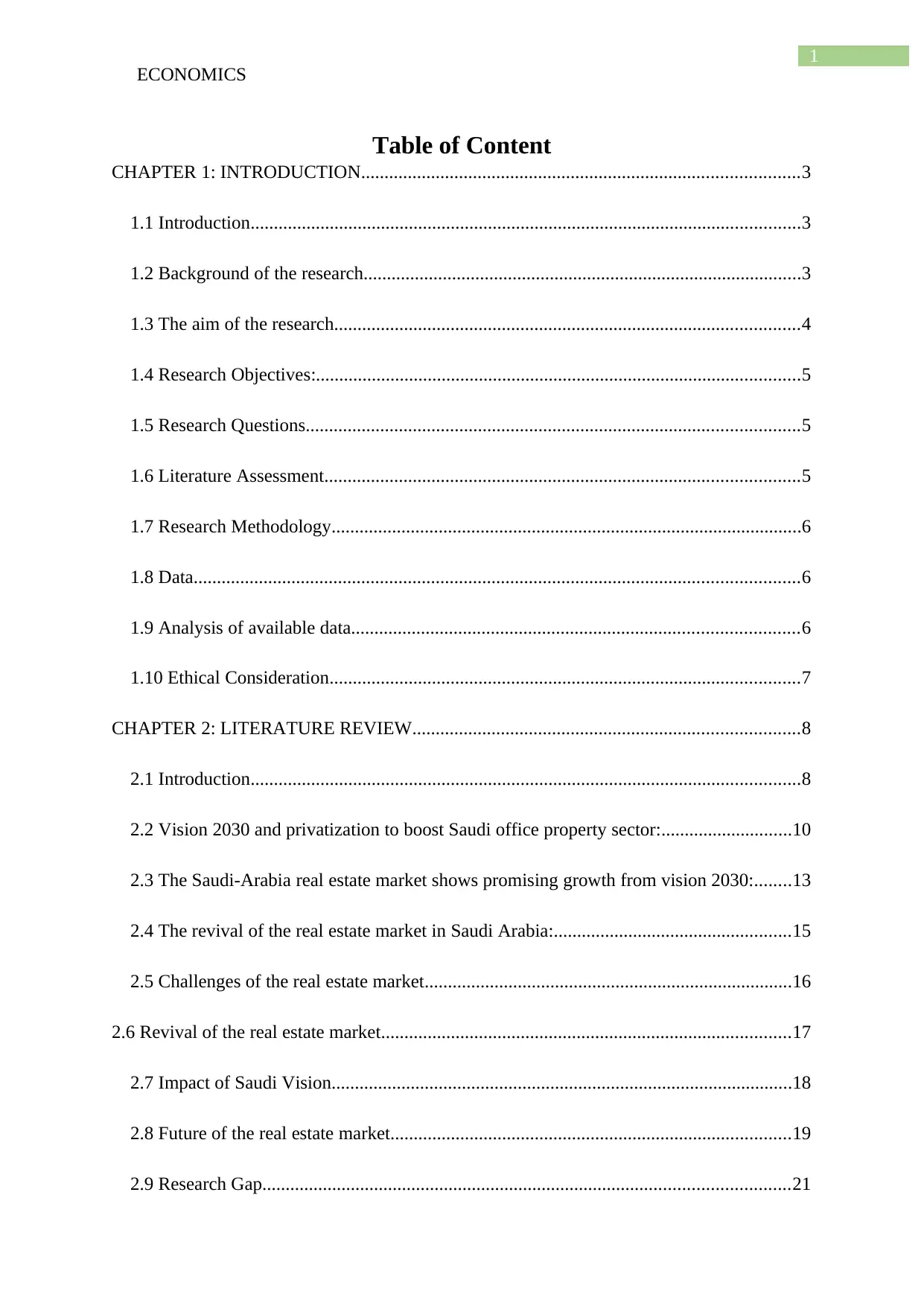
1
ECONOMICS
Table of Content
CHAPTER 1: INTRODUCTION..............................................................................................3
1.1 Introduction......................................................................................................................3
1.2 Background of the research..............................................................................................3
1.3 The aim of the research....................................................................................................4
1.4 Research Objectives:........................................................................................................5
1.5 Research Questions..........................................................................................................5
1.6 Literature Assessment......................................................................................................5
1.7 Research Methodology.....................................................................................................6
1.8 Data..................................................................................................................................6
1.9 Analysis of available data................................................................................................6
1.10 Ethical Consideration.....................................................................................................7
CHAPTER 2: LITERATURE REVIEW...................................................................................8
2.1 Introduction......................................................................................................................8
2.2 Vision 2030 and privatization to boost Saudi office property sector:............................10
2.3 The Saudi-Arabia real estate market shows promising growth from vision 2030:........13
2.4 The revival of the real estate market in Saudi Arabia:...................................................15
2.5 Challenges of the real estate market...............................................................................16
2.6 Revival of the real estate market........................................................................................17
2.7 Impact of Saudi Vision...................................................................................................18
2.8 Future of the real estate market......................................................................................19
2.9 Research Gap.................................................................................................................21
ECONOMICS
Table of Content
CHAPTER 1: INTRODUCTION..............................................................................................3
1.1 Introduction......................................................................................................................3
1.2 Background of the research..............................................................................................3
1.3 The aim of the research....................................................................................................4
1.4 Research Objectives:........................................................................................................5
1.5 Research Questions..........................................................................................................5
1.6 Literature Assessment......................................................................................................5
1.7 Research Methodology.....................................................................................................6
1.8 Data..................................................................................................................................6
1.9 Analysis of available data................................................................................................6
1.10 Ethical Consideration.....................................................................................................7
CHAPTER 2: LITERATURE REVIEW...................................................................................8
2.1 Introduction......................................................................................................................8
2.2 Vision 2030 and privatization to boost Saudi office property sector:............................10
2.3 The Saudi-Arabia real estate market shows promising growth from vision 2030:........13
2.4 The revival of the real estate market in Saudi Arabia:...................................................15
2.5 Challenges of the real estate market...............................................................................16
2.6 Revival of the real estate market........................................................................................17
2.7 Impact of Saudi Vision...................................................................................................18
2.8 Future of the real estate market......................................................................................19
2.9 Research Gap.................................................................................................................21

2
ECONOMICS
Chapter 3- Research Methodology...........................................................................................22
3.1 Introduction....................................................................................................................22
3.2 Research Approach........................................................................................................22
3.3 Research Philosophy......................................................................................................23
3.4 Research Design.............................................................................................................25
3.5 Method of Data Collection.............................................................................................27
3.6 Gantt Chart.....................................................................................................................28
3.7 Ethical Considerations...................................................................................................29
Chapter 4: Findings and Analysis...........................................................................................31
4.1 Introduction....................................................................................................................31
4.2 Thematic Analysis..........................................................................................................31
4.3 Analysis..........................................................................................................................37
References................................................................................................................................44
ECONOMICS
Chapter 3- Research Methodology...........................................................................................22
3.1 Introduction....................................................................................................................22
3.2 Research Approach........................................................................................................22
3.3 Research Philosophy......................................................................................................23
3.4 Research Design.............................................................................................................25
3.5 Method of Data Collection.............................................................................................27
3.6 Gantt Chart.....................................................................................................................28
3.7 Ethical Considerations...................................................................................................29
Chapter 4: Findings and Analysis...........................................................................................31
4.1 Introduction....................................................................................................................31
4.2 Thematic Analysis..........................................................................................................31
4.3 Analysis..........................................................................................................................37
References................................................................................................................................44
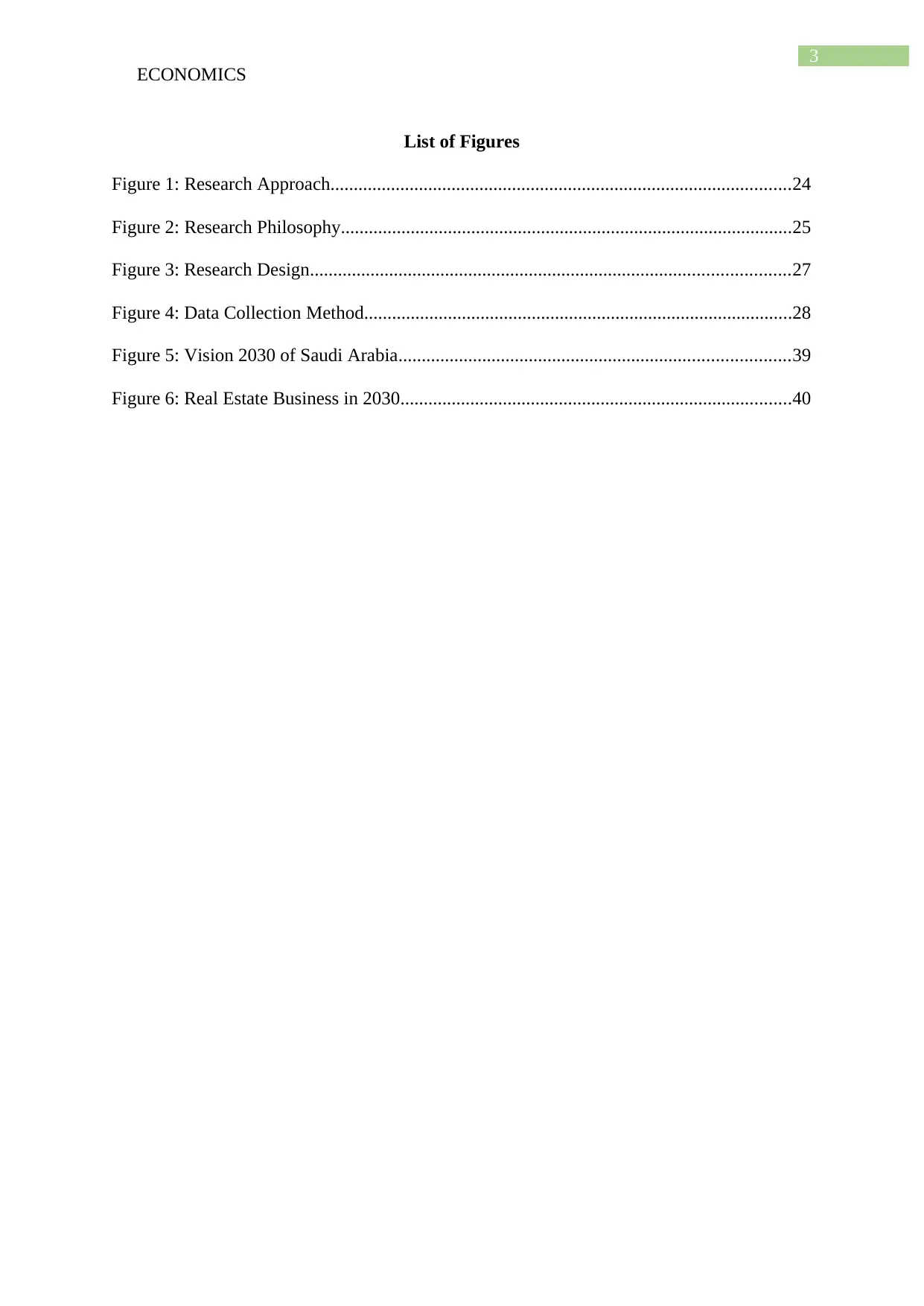
3
ECONOMICS
List of Figures
Figure 1: Research Approach...................................................................................................24
Figure 2: Research Philosophy.................................................................................................25
Figure 3: Research Design.......................................................................................................27
Figure 4: Data Collection Method............................................................................................28
Figure 5: Vision 2030 of Saudi Arabia....................................................................................39
Figure 6: Real Estate Business in 2030....................................................................................40
ECONOMICS
List of Figures
Figure 1: Research Approach...................................................................................................24
Figure 2: Research Philosophy.................................................................................................25
Figure 3: Research Design.......................................................................................................27
Figure 4: Data Collection Method............................................................................................28
Figure 5: Vision 2030 of Saudi Arabia....................................................................................39
Figure 6: Real Estate Business in 2030....................................................................................40
Secure Best Marks with AI Grader
Need help grading? Try our AI Grader for instant feedback on your assignments.

4
ECONOMICS
CHAPTER 1: INTRODUCTION
1.1 Introduction
The very sole purpose of undertaking this research is to critically
examine the current economic position of Saudi – Arabia and the new
initiative that is being implemented by them. This research aims to
support the real estate sector of the economy regarding the challenges of
the year 2015, the reduction in the price segment of the oil and
subsequent requirement to reduce government expenditure. As per Saudi
– Arabia economic Vision 2030, the real estate sector started with the
government expenses of about $10.6 billion that were provided to
different contractors and consequently SR20 billion was infused within the
banking sector of the economy.
To introduce innovation within the economy and make the real
estate sector available to different small financiers, and investors, the
capital authority has initiated new regulations and act during the year of
2016 and also allowed the formation of real estate investment traded
finances. Therefore the very purpose of undertaking this research is to
critically examine how the funds infused in this real estate sector can help
developers in Saudi Arabia seeking to generate income generating assets.
1.2 Background of the research.
Saudi vision 2030 resembles towards an arrangement to eliminate
the economicreliance on oil, expand the economy, and build up public
service sectors namely, health sector, educational sector, infrastructure
ECONOMICS
CHAPTER 1: INTRODUCTION
1.1 Introduction
The very sole purpose of undertaking this research is to critically
examine the current economic position of Saudi – Arabia and the new
initiative that is being implemented by them. This research aims to
support the real estate sector of the economy regarding the challenges of
the year 2015, the reduction in the price segment of the oil and
subsequent requirement to reduce government expenditure. As per Saudi
– Arabia economic Vision 2030, the real estate sector started with the
government expenses of about $10.6 billion that were provided to
different contractors and consequently SR20 billion was infused within the
banking sector of the economy.
To introduce innovation within the economy and make the real
estate sector available to different small financiers, and investors, the
capital authority has initiated new regulations and act during the year of
2016 and also allowed the formation of real estate investment traded
finances. Therefore the very purpose of undertaking this research is to
critically examine how the funds infused in this real estate sector can help
developers in Saudi Arabia seeking to generate income generating assets.
1.2 Background of the research.
Saudi vision 2030 resembles towards an arrangement to eliminate
the economicreliance on oil, expand the economy, and build up public
service sectors namely, health sector, educational sector, infrastructure
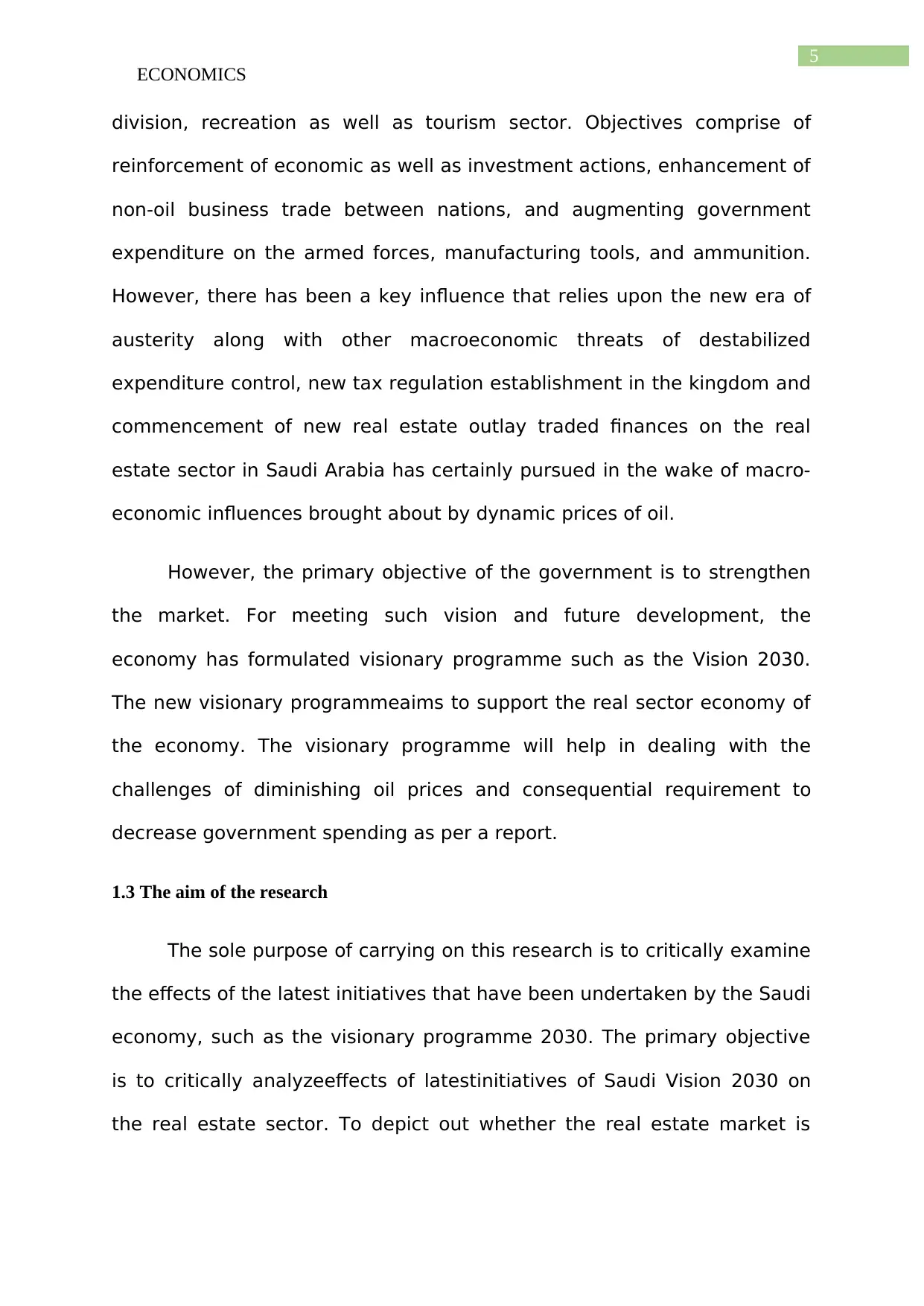
5
ECONOMICS
division, recreation as well as tourism sector. Objectives comprise of
reinforcement of economic as well as investment actions, enhancement of
non-oil business trade between nations, and augmenting government
expenditure on the armed forces, manufacturing tools, and ammunition.
However, there has been a key influence that relies upon the new era of
austerity along with other macroeconomic threats of destabilized
expenditure control, new tax regulation establishment in the kingdom and
commencement of new real estate outlay traded finances on the real
estate sector in Saudi Arabia has certainly pursued in the wake of macro-
economic influences brought about by dynamic prices of oil.
However, the primary objective of the government is to strengthen
the market. For meeting such vision and future development, the
economy has formulated visionary programme such as the Vision 2030.
The new visionary programmeaims to support the real sector economy of
the economy. The visionary programme will help in dealing with the
challenges of diminishing oil prices and consequential requirement to
decrease government spending as per a report.
1.3 The aim of the research
The sole purpose of carrying on this research is to critically examine
the effects of the latest initiatives that have been undertaken by the Saudi
economy, such as the visionary programme 2030. The primary objective
is to critically analyzeeffects of latestinitiatives of Saudi Vision 2030 on
the real estate sector. To depict out whether the real estate market is
ECONOMICS
division, recreation as well as tourism sector. Objectives comprise of
reinforcement of economic as well as investment actions, enhancement of
non-oil business trade between nations, and augmenting government
expenditure on the armed forces, manufacturing tools, and ammunition.
However, there has been a key influence that relies upon the new era of
austerity along with other macroeconomic threats of destabilized
expenditure control, new tax regulation establishment in the kingdom and
commencement of new real estate outlay traded finances on the real
estate sector in Saudi Arabia has certainly pursued in the wake of macro-
economic influences brought about by dynamic prices of oil.
However, the primary objective of the government is to strengthen
the market. For meeting such vision and future development, the
economy has formulated visionary programme such as the Vision 2030.
The new visionary programmeaims to support the real sector economy of
the economy. The visionary programme will help in dealing with the
challenges of diminishing oil prices and consequential requirement to
decrease government spending as per a report.
1.3 The aim of the research
The sole purpose of carrying on this research is to critically examine
the effects of the latest initiatives that have been undertaken by the Saudi
economy, such as the visionary programme 2030. The primary objective
is to critically analyzeeffects of latestinitiatives of Saudi Vision 2030 on
the real estate sector. To depict out whether the real estate market is
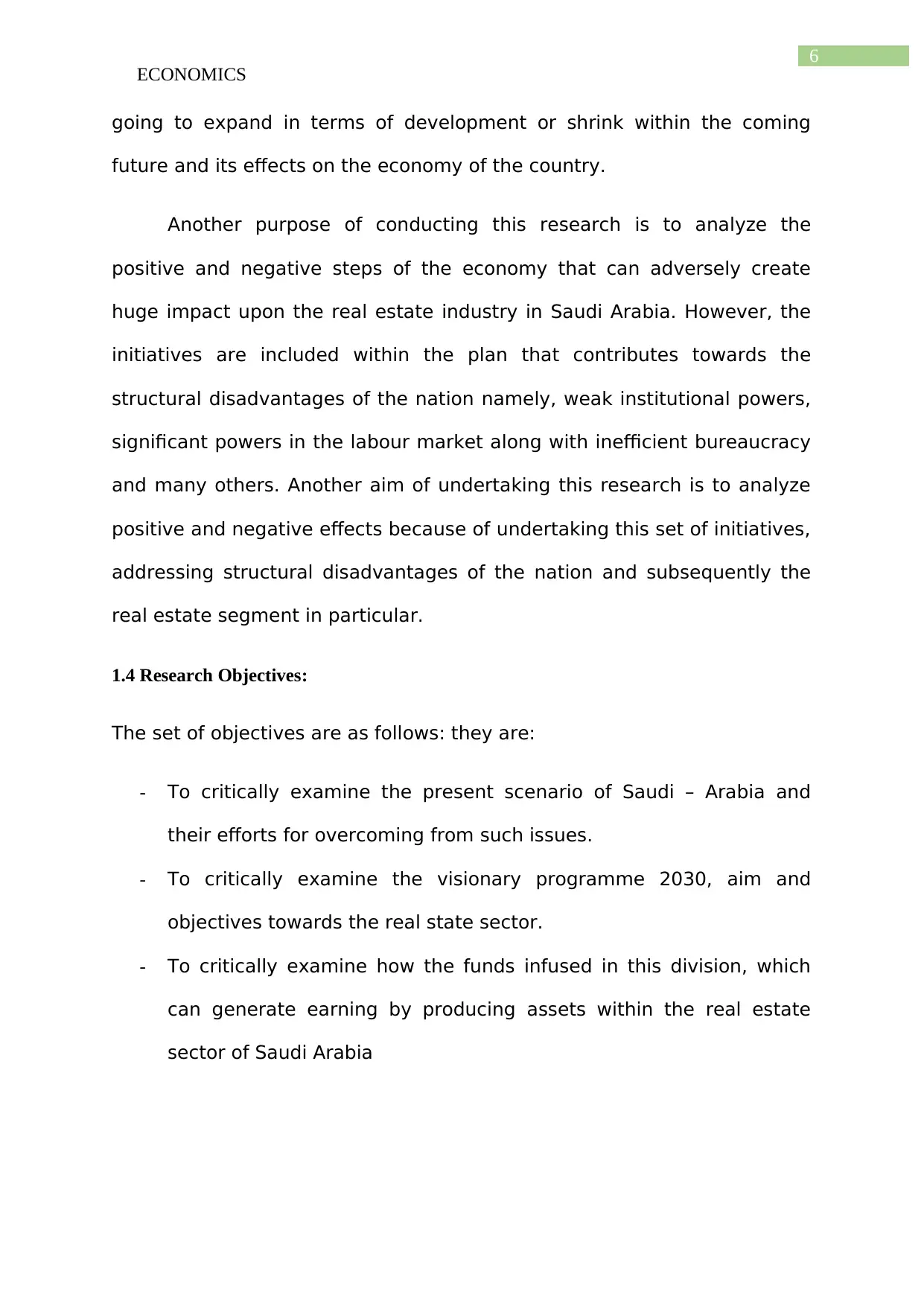
6
ECONOMICS
going to expand in terms of development or shrink within the coming
future and its effects on the economy of the country.
Another purpose of conducting this research is to analyze the
positive and negative steps of the economy that can adversely create
huge impact upon the real estate industry in Saudi Arabia. However, the
initiatives are included within the plan that contributes towards the
structural disadvantages of the nation namely, weak institutional powers,
significant powers in the labour market along with inefficient bureaucracy
and many others. Another aim of undertaking this research is to analyze
positive and negative effects because of undertaking this set of initiatives,
addressing structural disadvantages of the nation and subsequently the
real estate segment in particular.
1.4 Research Objectives:
The set of objectives are as follows: they are:
- To critically examine the present scenario of Saudi – Arabia and
their efforts for overcoming from such issues.
- To critically examine the visionary programme 2030, aim and
objectives towards the real state sector.
- To critically examine how the funds infused in this division, which
can generate earning by producing assets within the real estate
sector of Saudi Arabia
ECONOMICS
going to expand in terms of development or shrink within the coming
future and its effects on the economy of the country.
Another purpose of conducting this research is to analyze the
positive and negative steps of the economy that can adversely create
huge impact upon the real estate industry in Saudi Arabia. However, the
initiatives are included within the plan that contributes towards the
structural disadvantages of the nation namely, weak institutional powers,
significant powers in the labour market along with inefficient bureaucracy
and many others. Another aim of undertaking this research is to analyze
positive and negative effects because of undertaking this set of initiatives,
addressing structural disadvantages of the nation and subsequently the
real estate segment in particular.
1.4 Research Objectives:
The set of objectives are as follows: they are:
- To critically examine the present scenario of Saudi – Arabia and
their efforts for overcoming from such issues.
- To critically examine the visionary programme 2030, aim and
objectives towards the real state sector.
- To critically examine how the funds infused in this division, which
can generate earning by producing assets within the real estate
sector of Saudi Arabia
Paraphrase This Document
Need a fresh take? Get an instant paraphrase of this document with our AI Paraphraser
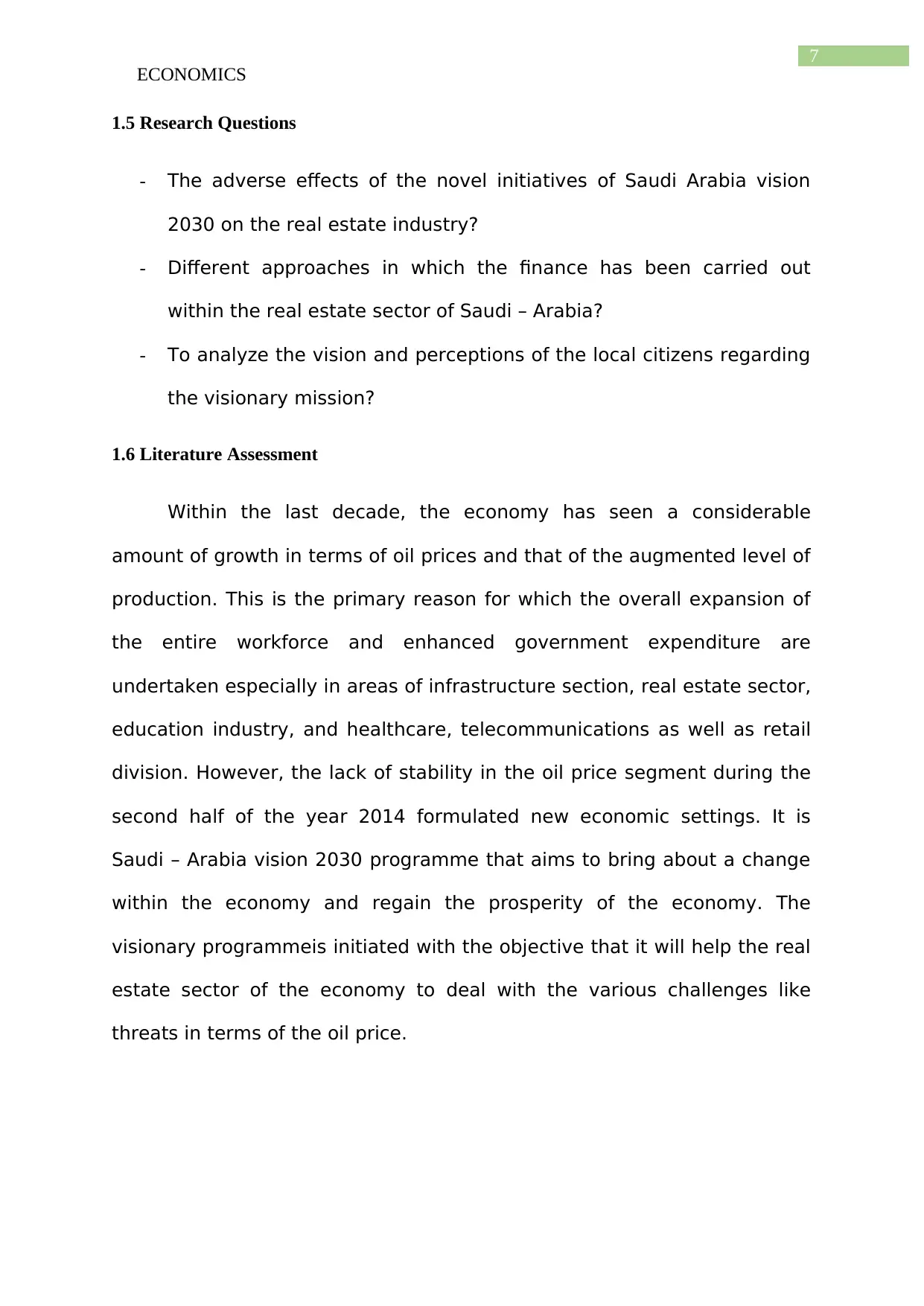
7
ECONOMICS
1.5 Research Questions
- The adverse effects of the novel initiatives of Saudi Arabia vision
2030 on the real estate industry?
- Different approaches in which the finance has been carried out
within the real estate sector of Saudi – Arabia?
- To analyze the vision and perceptions of the local citizens regarding
the visionary mission?
1.6 Literature Assessment
Within the last decade, the economy has seen a considerable
amount of growth in terms of oil prices and that of the augmented level of
production. This is the primary reason for which the overall expansion of
the entire workforce and enhanced government expenditure are
undertaken especially in areas of infrastructure section, real estate sector,
education industry, and healthcare, telecommunications as well as retail
division. However, the lack of stability in the oil price segment during the
second half of the year 2014 formulated new economic settings. It is
Saudi – Arabia vision 2030 programme that aims to bring about a change
within the economy and regain the prosperity of the economy. The
visionary programmeis initiated with the objective that it will help the real
estate sector of the economy to deal with the various challenges like
threats in terms of the oil price.
ECONOMICS
1.5 Research Questions
- The adverse effects of the novel initiatives of Saudi Arabia vision
2030 on the real estate industry?
- Different approaches in which the finance has been carried out
within the real estate sector of Saudi – Arabia?
- To analyze the vision and perceptions of the local citizens regarding
the visionary mission?
1.6 Literature Assessment
Within the last decade, the economy has seen a considerable
amount of growth in terms of oil prices and that of the augmented level of
production. This is the primary reason for which the overall expansion of
the entire workforce and enhanced government expenditure are
undertaken especially in areas of infrastructure section, real estate sector,
education industry, and healthcare, telecommunications as well as retail
division. However, the lack of stability in the oil price segment during the
second half of the year 2014 formulated new economic settings. It is
Saudi – Arabia vision 2030 programme that aims to bring about a change
within the economy and regain the prosperity of the economy. The
visionary programmeis initiated with the objective that it will help the real
estate sector of the economy to deal with the various challenges like
threats in terms of the oil price.

8
ECONOMICS
1.7 Research Methodology
The use of the deductive approach will be undertaken for
undertaking this very research. Taking into consideration the sole purpose
of the study, the motive is to make use of the descriptive research design
such that use of the secondary data is being undertaken along with the
thorough evaluation of facts that were previously acknowledged to great
degree. Making use of the descriptive research, it aims to carry out a
complete investigation of formerly available evidence and subsequently
figuring out interferences by understanding thematic analysis.
1.8 Data
The use of the secondary data is being undertaken,and the
application of qualitative analysis is undertaken. Besides, different kinds
of structured texts entailing survey response, diverse articles/journals as
well as books will be used for the current study. Therefore, this can be
gathered as qualitative data for the current study.
1.9 Analysis of available data
For undertaking this research, the primary method will comprise of
making use of the various case study analysis, thematic data analysis and
analysis of academic literature for evaluation of obtainable data. There
are different groups that concentrate on recognizing a particular pattern
in a specific dataset. Furthermore, there are different classes of thematic
analysis that can be utilized in the present study are necessarily
deductive advances that are directed by different concepts.
ECONOMICS
1.7 Research Methodology
The use of the deductive approach will be undertaken for
undertaking this very research. Taking into consideration the sole purpose
of the study, the motive is to make use of the descriptive research design
such that use of the secondary data is being undertaken along with the
thorough evaluation of facts that were previously acknowledged to great
degree. Making use of the descriptive research, it aims to carry out a
complete investigation of formerly available evidence and subsequently
figuring out interferences by understanding thematic analysis.
1.8 Data
The use of the secondary data is being undertaken,and the
application of qualitative analysis is undertaken. Besides, different kinds
of structured texts entailing survey response, diverse articles/journals as
well as books will be used for the current study. Therefore, this can be
gathered as qualitative data for the current study.
1.9 Analysis of available data
For undertaking this research, the primary method will comprise of
making use of the various case study analysis, thematic data analysis and
analysis of academic literature for evaluation of obtainable data. There
are different groups that concentrate on recognizing a particular pattern
in a specific dataset. Furthermore, there are different classes of thematic
analysis that can be utilized in the present study are necessarily
deductive advances that are directed by different concepts.

9
ECONOMICS
1.10 Ethical Consideration
It is very important to follow the rules and regulations while
undertaking the study. The privacy of the individual has been kept
confidential. In fact, for the current study, requisite secondary information
namely, available reports, periodicals, relevant articles amongst others
are acquired from diverse secondary sources. It is taken care of that the
individual sentiments of the subjects do not get hampered. In addition to
his, the secondary qualitative data can essentially be derived from diverse
restructured as well as reliant sources, so that there is no disagreement
and inconsistency.
ECONOMICS
1.10 Ethical Consideration
It is very important to follow the rules and regulations while
undertaking the study. The privacy of the individual has been kept
confidential. In fact, for the current study, requisite secondary information
namely, available reports, periodicals, relevant articles amongst others
are acquired from diverse secondary sources. It is taken care of that the
individual sentiments of the subjects do not get hampered. In addition to
his, the secondary qualitative data can essentially be derived from diverse
restructured as well as reliant sources, so that there is no disagreement
and inconsistency.
Secure Best Marks with AI Grader
Need help grading? Try our AI Grader for instant feedback on your assignments.
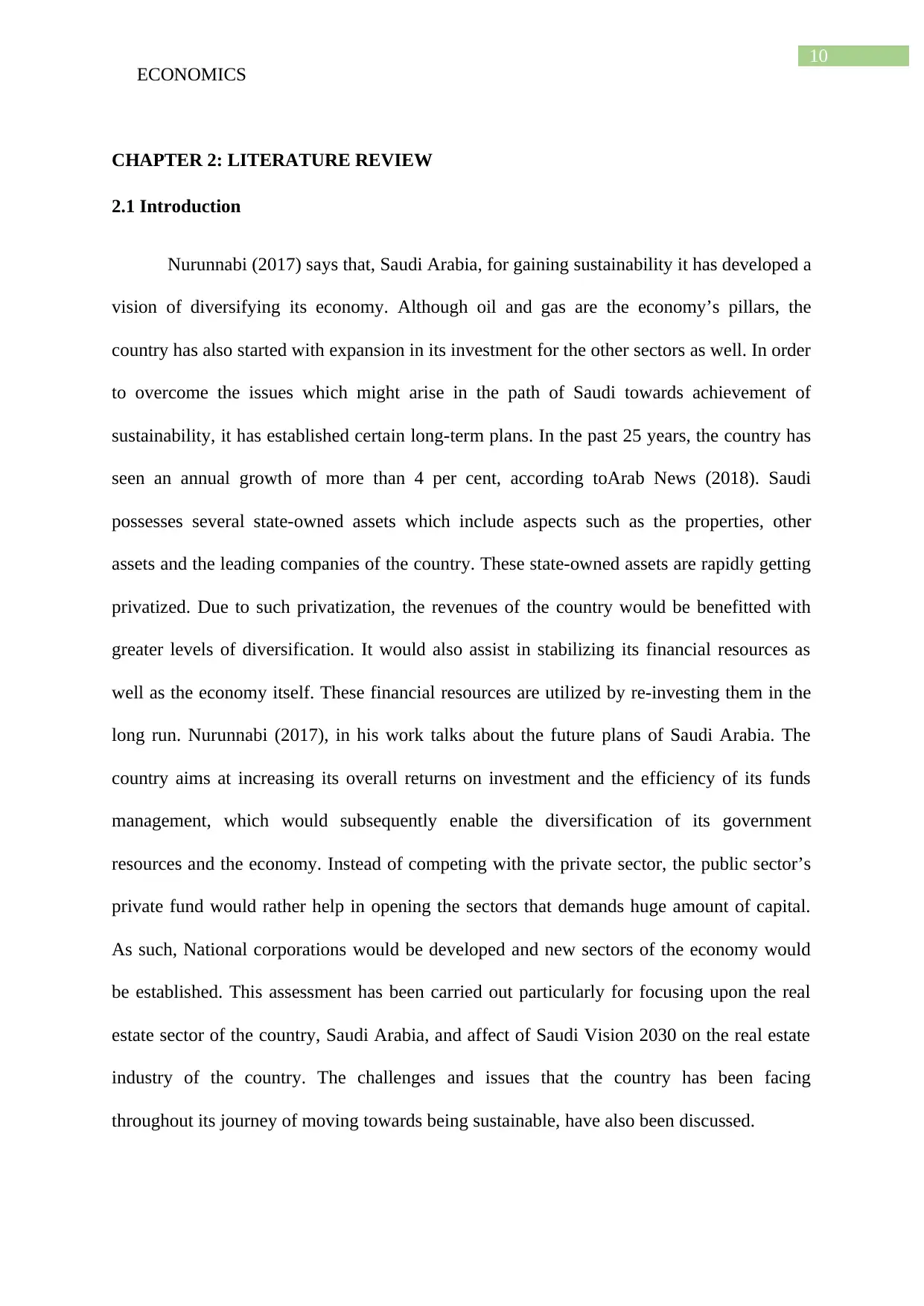
10
ECONOMICS
CHAPTER 2: LITERATURE REVIEW
2.1 Introduction
Nurunnabi (2017) says that, Saudi Arabia, for gaining sustainability it has developed a
vision of diversifying its economy. Although oil and gas are the economy’s pillars, the
country has also started with expansion in its investment for the other sectors as well. In order
to overcome the issues which might arise in the path of Saudi towards achievement of
sustainability, it has established certain long-term plans. In the past 25 years, the country has
seen an annual growth of more than 4 per cent, according toArab News (2018). Saudi
possesses several state-owned assets which include aspects such as the properties, other
assets and the leading companies of the country. These state-owned assets are rapidly getting
privatized. Due to such privatization, the revenues of the country would be benefitted with
greater levels of diversification. It would also assist in stabilizing its financial resources as
well as the economy itself. These financial resources are utilized by re-investing them in the
long run. Nurunnabi (2017), in his work talks about the future plans of Saudi Arabia. The
country aims at increasing its overall returns on investment and the efficiency of its funds
management, which would subsequently enable the diversification of its government
resources and the economy. Instead of competing with the private sector, the public sector’s
private fund would rather help in opening the sectors that demands huge amount of capital.
As such, National corporations would be developed and new sectors of the economy would
be established. This assessment has been carried out particularly for focusing upon the real
estate sector of the country, Saudi Arabia, and affect of Saudi Vision 2030 on the real estate
industry of the country. The challenges and issues that the country has been facing
throughout its journey of moving towards being sustainable, have also been discussed.
ECONOMICS
CHAPTER 2: LITERATURE REVIEW
2.1 Introduction
Nurunnabi (2017) says that, Saudi Arabia, for gaining sustainability it has developed a
vision of diversifying its economy. Although oil and gas are the economy’s pillars, the
country has also started with expansion in its investment for the other sectors as well. In order
to overcome the issues which might arise in the path of Saudi towards achievement of
sustainability, it has established certain long-term plans. In the past 25 years, the country has
seen an annual growth of more than 4 per cent, according toArab News (2018). Saudi
possesses several state-owned assets which include aspects such as the properties, other
assets and the leading companies of the country. These state-owned assets are rapidly getting
privatized. Due to such privatization, the revenues of the country would be benefitted with
greater levels of diversification. It would also assist in stabilizing its financial resources as
well as the economy itself. These financial resources are utilized by re-investing them in the
long run. Nurunnabi (2017), in his work talks about the future plans of Saudi Arabia. The
country aims at increasing its overall returns on investment and the efficiency of its funds
management, which would subsequently enable the diversification of its government
resources and the economy. Instead of competing with the private sector, the public sector’s
private fund would rather help in opening the sectors that demands huge amount of capital.
As such, National corporations would be developed and new sectors of the economy would
be established. This assessment has been carried out particularly for focusing upon the real
estate sector of the country, Saudi Arabia, and affect of Saudi Vision 2030 on the real estate
industry of the country. The challenges and issues that the country has been facing
throughout its journey of moving towards being sustainable, have also been discussed.

11
ECONOMICS
According to the author Arabia et al., (2030), the Kingdom of Saudi-Arabia is blessed
because of its possession of the rich assets that stayin favour of the economy. Its geographic,
cultural, social, demographic and economic advantages have enabled the economy to be a
dominator in assets that they possess in comparison to other countries. Because of the
possession of these assets, the region of Saudi-Arabia is at a leading position within the
world.
The Vision 2030, the programme is formulated on a strategic basis. The visionary
programme is a blueprint that acts as a visionary tool for economists within Saudi – Arabia.
The blueprintresembles towards the future for Saudi Arabia based on an economy diversified,
away from a dependency on oil and driven by the establishment and formulation of new
private business units. Public-Private Partnerships, privatisation of many government
services, and a modernisation of the business legal environment to promote entrepreneurship,
local as well as foreign investment. Moreover, the economy has faith in this visionary
programme s they believe that this visionary programme will help in the creation of new job
opportunities and will result in the elimination of poverty level.
Therein Saudi – Arabia, also exists a specific segment of local residents who do not
even have favorable conditions to live in. They do not evenhave a reach to basic services.
They do not have a proper house to live in such that they reside in tents. Some of the
problems as faced by the poor section of the society comprises of sand storms. This visionary
programme will at least help the poor section of the society by creating new job opportunities
for them. On the other hand, the living standard of these specific poor sections of the society
will get improved. This will directly result in the growth of the economy.
However, Vision 2030 programme aims to open the door of hope and put the hand
forward to bring more prosperity by loosening investment rules within the specific regions,
ECONOMICS
According to the author Arabia et al., (2030), the Kingdom of Saudi-Arabia is blessed
because of its possession of the rich assets that stayin favour of the economy. Its geographic,
cultural, social, demographic and economic advantages have enabled the economy to be a
dominator in assets that they possess in comparison to other countries. Because of the
possession of these assets, the region of Saudi-Arabia is at a leading position within the
world.
The Vision 2030, the programme is formulated on a strategic basis. The visionary
programme is a blueprint that acts as a visionary tool for economists within Saudi – Arabia.
The blueprintresembles towards the future for Saudi Arabia based on an economy diversified,
away from a dependency on oil and driven by the establishment and formulation of new
private business units. Public-Private Partnerships, privatisation of many government
services, and a modernisation of the business legal environment to promote entrepreneurship,
local as well as foreign investment. Moreover, the economy has faith in this visionary
programme s they believe that this visionary programme will help in the creation of new job
opportunities and will result in the elimination of poverty level.
Therein Saudi – Arabia, also exists a specific segment of local residents who do not
even have favorable conditions to live in. They do not evenhave a reach to basic services.
They do not have a proper house to live in such that they reside in tents. Some of the
problems as faced by the poor section of the society comprises of sand storms. This visionary
programme will at least help the poor section of the society by creating new job opportunities
for them. On the other hand, the living standard of these specific poor sections of the society
will get improved. This will directly result in the growth of the economy.
However, Vision 2030 programme aims to open the door of hope and put the hand
forward to bring more prosperity by loosening investment rules within the specific regions,
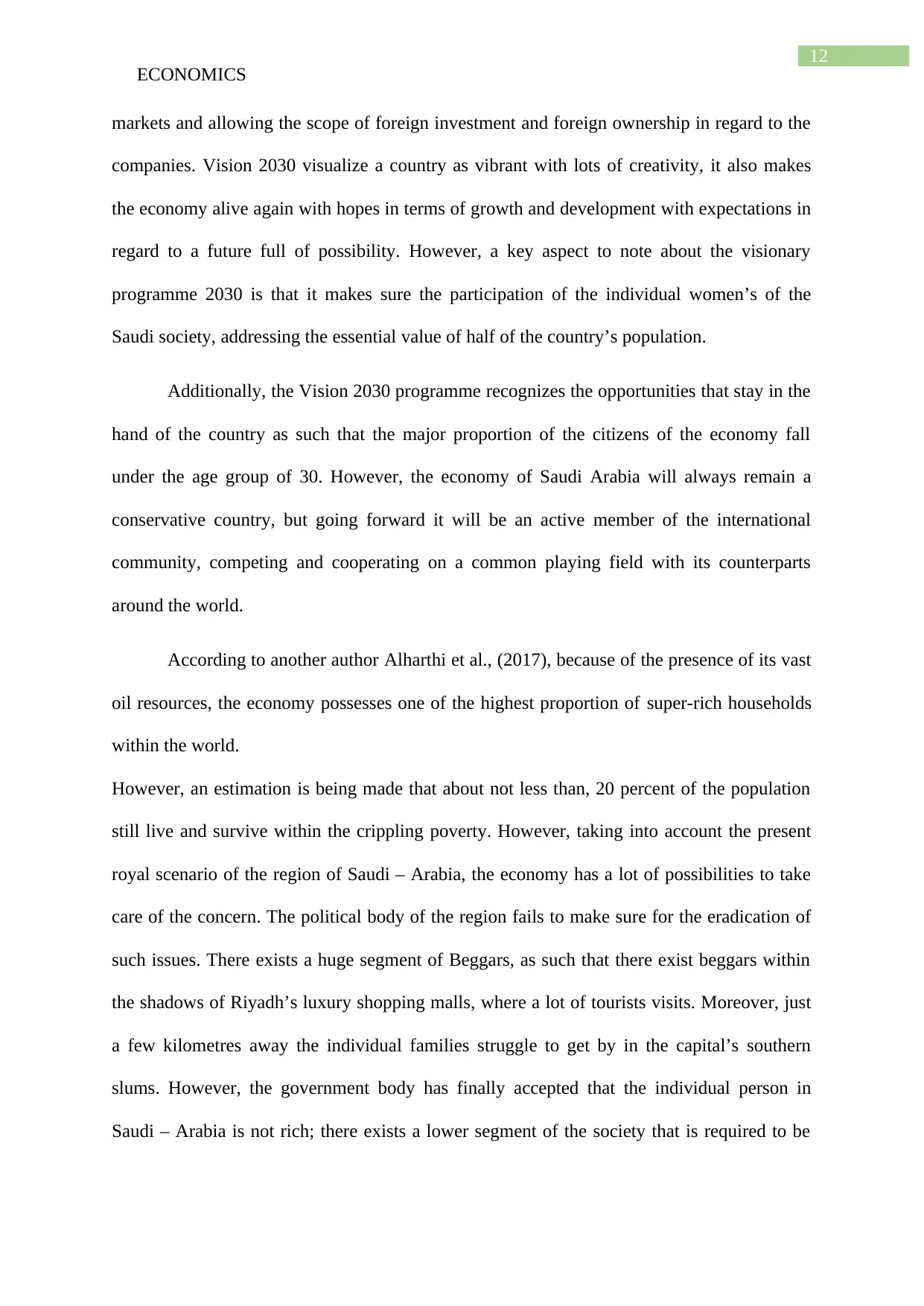
12
ECONOMICS
markets and allowing the scope of foreign investment and foreign ownership in regard to the
companies. Vision 2030 visualize a country as vibrant with lots of creativity, it also makes
the economy alive again with hopes in terms of growth and development with expectations in
regard to a future full of possibility. However, a key aspect to note about the visionary
programme 2030 is that it makes sure the participation of the individual women’s of the
Saudi society, addressing the essential value of half of the country’s population.
Additionally, the Vision 2030 programme recognizes the opportunities that stay in the
hand of the country as such that the major proportion of the citizens of the economy fall
under the age group of 30. However, the economy of Saudi Arabia will always remain a
conservative country, but going forward it will be an active member of the international
community, competing and cooperating on a common playing field with its counterparts
around the world.
According to another author Alharthi et al., (2017), because of the presence of its vast
oil resources, the economy possesses one of the highest proportion of super-rich households
within the world.
However, an estimation is being made that about not less than, 20 percent of the population
still live and survive within the crippling poverty. However, taking into account the present
royal scenario of the region of Saudi – Arabia, the economy has a lot of possibilities to take
care of the concern. The political body of the region fails to make sure for the eradication of
such issues. There exists a huge segment of Beggars, as such that there exist beggars within
the shadows of Riyadh’s luxury shopping malls, where a lot of tourists visits. Moreover, just
a few kilometres away the individual families struggle to get by in the capital’s southern
slums. However, the government body has finally accepted that the individual person in
Saudi – Arabia is not rich; there exists a lower segment of the society that is required to be
ECONOMICS
markets and allowing the scope of foreign investment and foreign ownership in regard to the
companies. Vision 2030 visualize a country as vibrant with lots of creativity, it also makes
the economy alive again with hopes in terms of growth and development with expectations in
regard to a future full of possibility. However, a key aspect to note about the visionary
programme 2030 is that it makes sure the participation of the individual women’s of the
Saudi society, addressing the essential value of half of the country’s population.
Additionally, the Vision 2030 programme recognizes the opportunities that stay in the
hand of the country as such that the major proportion of the citizens of the economy fall
under the age group of 30. However, the economy of Saudi Arabia will always remain a
conservative country, but going forward it will be an active member of the international
community, competing and cooperating on a common playing field with its counterparts
around the world.
According to another author Alharthi et al., (2017), because of the presence of its vast
oil resources, the economy possesses one of the highest proportion of super-rich households
within the world.
However, an estimation is being made that about not less than, 20 percent of the population
still live and survive within the crippling poverty. However, taking into account the present
royal scenario of the region of Saudi – Arabia, the economy has a lot of possibilities to take
care of the concern. The political body of the region fails to make sure for the eradication of
such issues. There exists a huge segment of Beggars, as such that there exist beggars within
the shadows of Riyadh’s luxury shopping malls, where a lot of tourists visits. Moreover, just
a few kilometres away the individual families struggle to get by in the capital’s southern
slums. However, the government body has finally accepted that the individual person in
Saudi – Arabia is not rich; there exists a lower segment of the society that is required to be
Paraphrase This Document
Need a fresh take? Get an instant paraphrase of this document with our AI Paraphraser
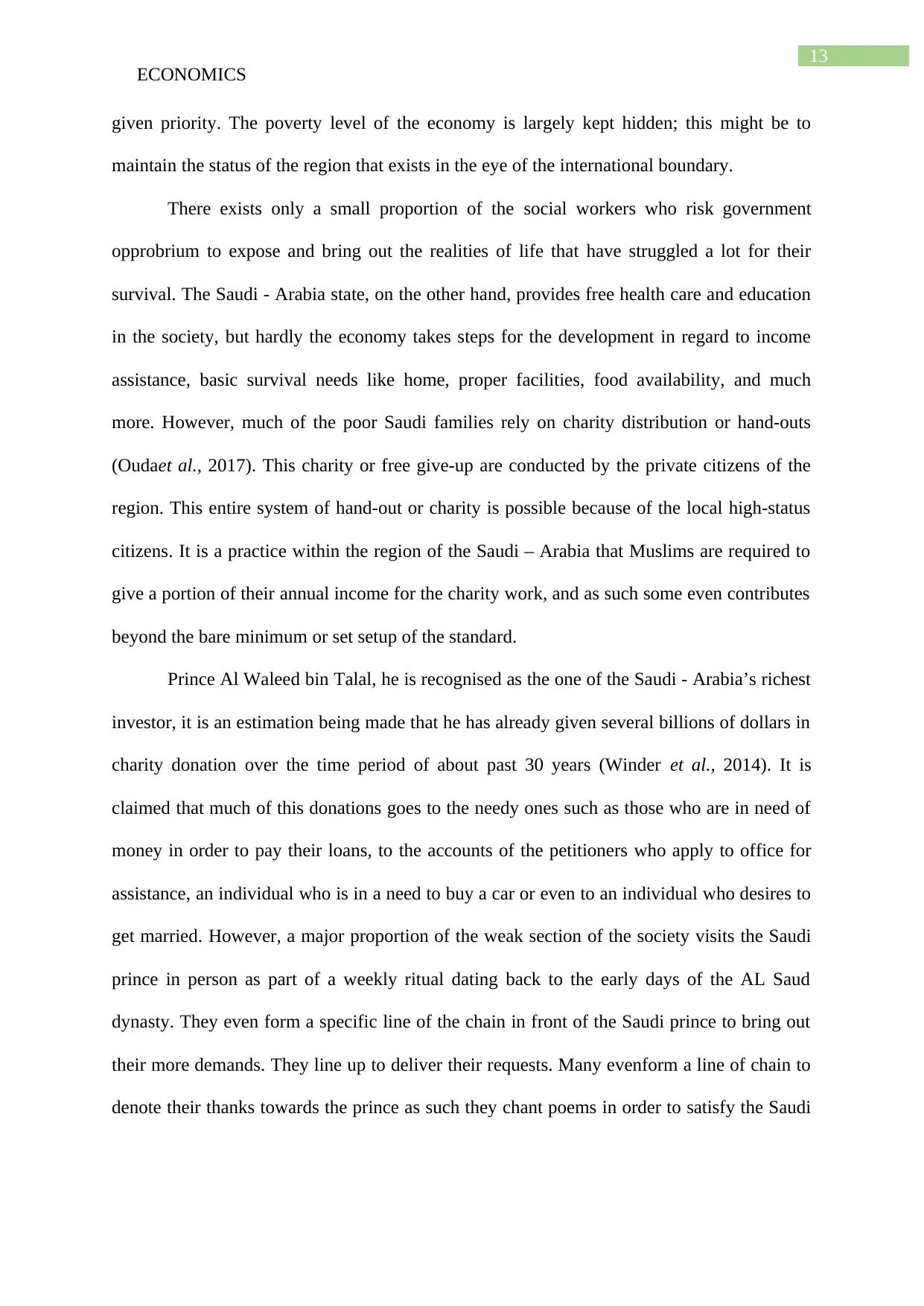
13
ECONOMICS
given priority. The poverty level of the economy is largely kept hidden; this might be to
maintain the status of the region that exists in the eye of the international boundary.
There exists only a small proportion of the social workers who risk government
opprobrium to expose and bring out the realities of life that have struggled a lot for their
survival. The Saudi - Arabia state, on the other hand, provides free health care and education
in the society, but hardly the economy takes steps for the development in regard to income
assistance, basic survival needs like home, proper facilities, food availability, and much
more. However, much of the poor Saudi families rely on charity distribution or hand-outs
(Oudaet al., 2017). This charity or free give-up are conducted by the private citizens of the
region. This entire system of hand-out or charity is possible because of the local high-status
citizens. It is a practice within the region of the Saudi – Arabia that Muslims are required to
give a portion of their annual income for the charity work, and as such some even contributes
beyond the bare minimum or set setup of the standard.
Prince Al Waleed bin Talal, he is recognised as the one of the Saudi - Arabia’s richest
investor, it is an estimation being made that he has already given several billions of dollars in
charity donation over the time period of about past 30 years (Winder et al., 2014). It is
claimed that much of this donations goes to the needy ones such as those who are in need of
money in order to pay their loans, to the accounts of the petitioners who apply to office for
assistance, an individual who is in a need to buy a car or even to an individual who desires to
get married. However, a major proportion of the weak section of the society visits the Saudi
prince in person as part of a weekly ritual dating back to the early days of the AL Saud
dynasty. They even form a specific line of the chain in front of the Saudi prince to bring out
their more demands. They line up to deliver their requests. Many evenform a line of chain to
denote their thanks towards the prince as such they chant poems in order to satisfy the Saudi
ECONOMICS
given priority. The poverty level of the economy is largely kept hidden; this might be to
maintain the status of the region that exists in the eye of the international boundary.
There exists only a small proportion of the social workers who risk government
opprobrium to expose and bring out the realities of life that have struggled a lot for their
survival. The Saudi - Arabia state, on the other hand, provides free health care and education
in the society, but hardly the economy takes steps for the development in regard to income
assistance, basic survival needs like home, proper facilities, food availability, and much
more. However, much of the poor Saudi families rely on charity distribution or hand-outs
(Oudaet al., 2017). This charity or free give-up are conducted by the private citizens of the
region. This entire system of hand-out or charity is possible because of the local high-status
citizens. It is a practice within the region of the Saudi – Arabia that Muslims are required to
give a portion of their annual income for the charity work, and as such some even contributes
beyond the bare minimum or set setup of the standard.
Prince Al Waleed bin Talal, he is recognised as the one of the Saudi - Arabia’s richest
investor, it is an estimation being made that he has already given several billions of dollars in
charity donation over the time period of about past 30 years (Winder et al., 2014). It is
claimed that much of this donations goes to the needy ones such as those who are in need of
money in order to pay their loans, to the accounts of the petitioners who apply to office for
assistance, an individual who is in a need to buy a car or even to an individual who desires to
get married. However, a major proportion of the weak section of the society visits the Saudi
prince in person as part of a weekly ritual dating back to the early days of the AL Saud
dynasty. They even form a specific line of the chain in front of the Saudi prince to bring out
their more demands. They line up to deliver their requests. Many evenform a line of chain to
denote their thanks towards the prince as such they chant poems in order to satisfy the Saudi
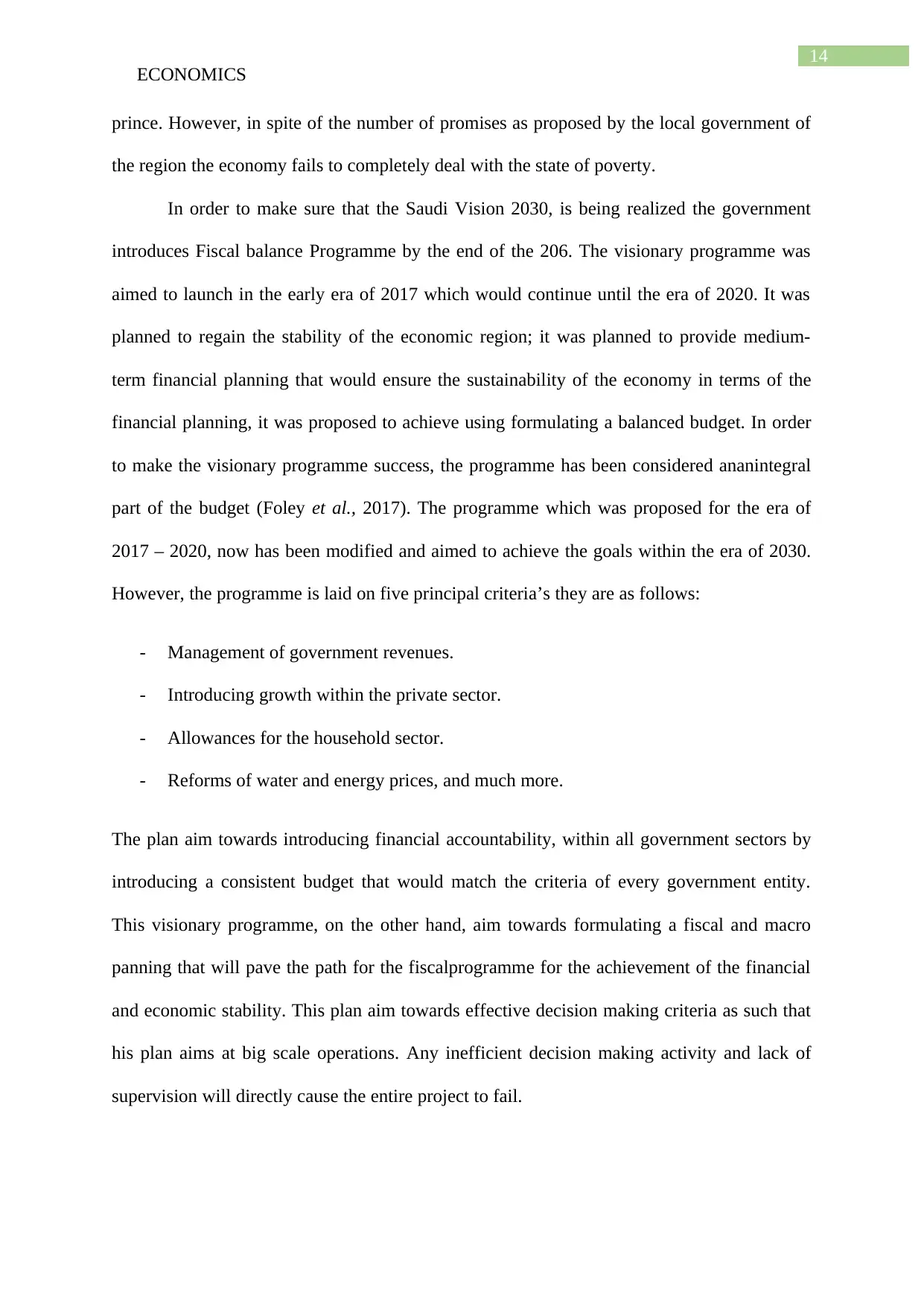
14
ECONOMICS
prince. However, in spite of the number of promises as proposed by the local government of
the region the economy fails to completely deal with the state of poverty.
In order to make sure that the Saudi Vision 2030, is being realized the government
introduces Fiscal balance Programme by the end of the 206. The visionary programme was
aimed to launch in the early era of 2017 which would continue until the era of 2020. It was
planned to regain the stability of the economic region; it was planned to provide medium-
term financial planning that would ensure the sustainability of the economy in terms of the
financial planning, it was proposed to achieve using formulating a balanced budget. In order
to make the visionary programme success, the programme has been considered ananintegral
part of the budget (Foley et al., 2017). The programme which was proposed for the era of
2017 – 2020, now has been modified and aimed to achieve the goals within the era of 2030.
However, the programme is laid on five principal criteria’s they are as follows:
- Management of government revenues.
- Introducing growth within the private sector.
- Allowances for the household sector.
- Reforms of water and energy prices, and much more.
The plan aim towards introducing financial accountability, within all government sectors by
introducing a consistent budget that would match the criteria of every government entity.
This visionary programme, on the other hand, aim towards formulating a fiscal and macro
panning that will pave the path for the fiscalprogramme for the achievement of the financial
and economic stability. This plan aim towards effective decision making criteria as such that
his plan aims at big scale operations. Any inefficient decision making activity and lack of
supervision will directly cause the entire project to fail.
ECONOMICS
prince. However, in spite of the number of promises as proposed by the local government of
the region the economy fails to completely deal with the state of poverty.
In order to make sure that the Saudi Vision 2030, is being realized the government
introduces Fiscal balance Programme by the end of the 206. The visionary programme was
aimed to launch in the early era of 2017 which would continue until the era of 2020. It was
planned to regain the stability of the economic region; it was planned to provide medium-
term financial planning that would ensure the sustainability of the economy in terms of the
financial planning, it was proposed to achieve using formulating a balanced budget. In order
to make the visionary programme success, the programme has been considered ananintegral
part of the budget (Foley et al., 2017). The programme which was proposed for the era of
2017 – 2020, now has been modified and aimed to achieve the goals within the era of 2030.
However, the programme is laid on five principal criteria’s they are as follows:
- Management of government revenues.
- Introducing growth within the private sector.
- Allowances for the household sector.
- Reforms of water and energy prices, and much more.
The plan aim towards introducing financial accountability, within all government sectors by
introducing a consistent budget that would match the criteria of every government entity.
This visionary programme, on the other hand, aim towards formulating a fiscal and macro
panning that will pave the path for the fiscalprogramme for the achievement of the financial
and economic stability. This plan aim towards effective decision making criteria as such that
his plan aims at big scale operations. Any inefficient decision making activity and lack of
supervision will directly cause the entire project to fail.
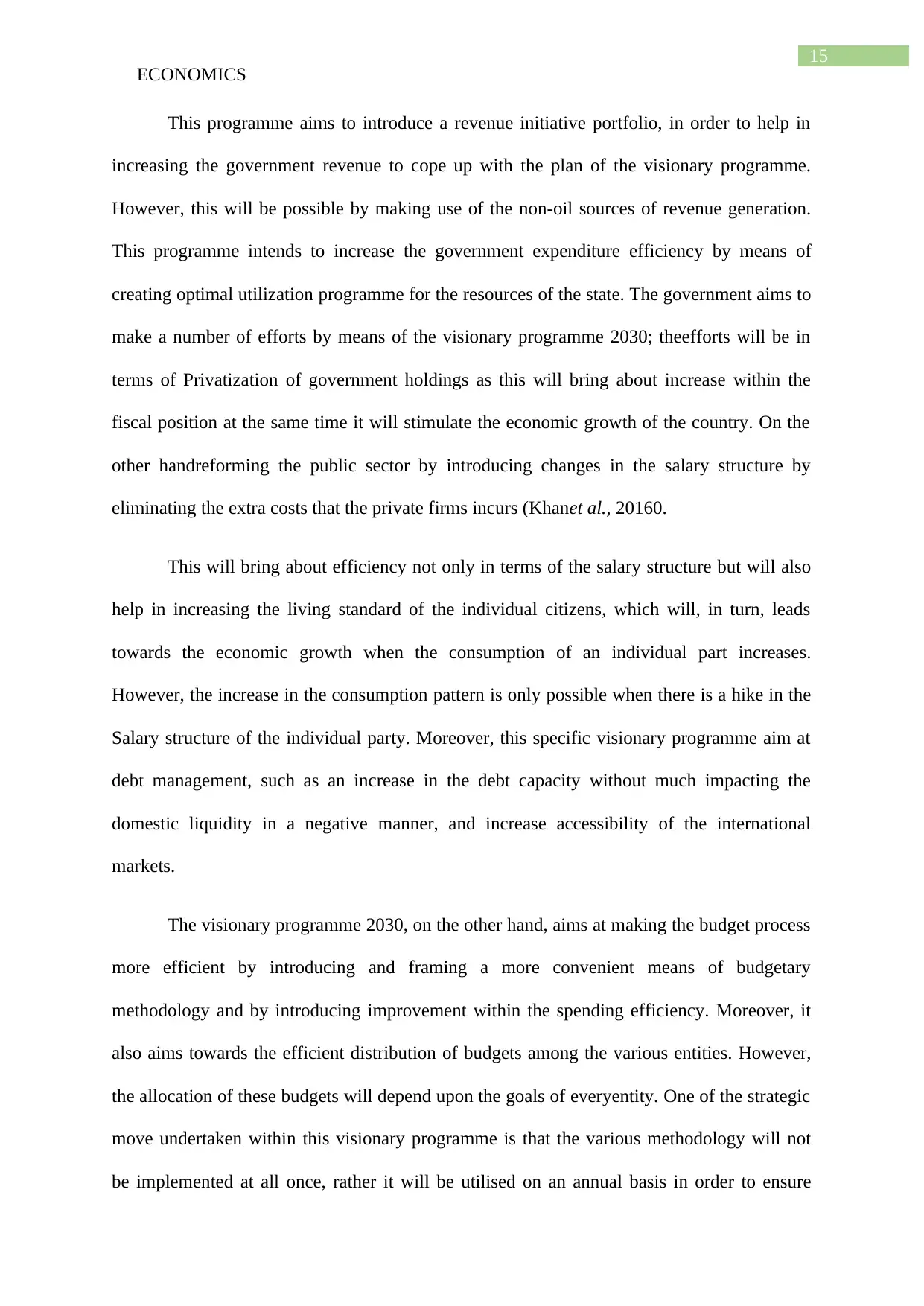
15
ECONOMICS
This programme aims to introduce a revenue initiative portfolio, in order to help in
increasing the government revenue to cope up with the plan of the visionary programme.
However, this will be possible by making use of the non-oil sources of revenue generation.
This programme intends to increase the government expenditure efficiency by means of
creating optimal utilization programme for the resources of the state. The government aims to
make a number of efforts by means of the visionary programme 2030; theefforts will be in
terms of Privatization of government holdings as this will bring about increase within the
fiscal position at the same time it will stimulate the economic growth of the country. On the
other handreforming the public sector by introducing changes in the salary structure by
eliminating the extra costs that the private firms incurs (Khanet al., 20160.
This will bring about efficiency not only in terms of the salary structure but will also
help in increasing the living standard of the individual citizens, which will, in turn, leads
towards the economic growth when the consumption of an individual part increases.
However, the increase in the consumption pattern is only possible when there is a hike in the
Salary structure of the individual party. Moreover, this specific visionary programme aim at
debt management, such as an increase in the debt capacity without much impacting the
domestic liquidity in a negative manner, and increase accessibility of the international
markets.
The visionary programme 2030, on the other hand, aims at making the budget process
more efficient by introducing and framing a more convenient means of budgetary
methodology and by introducing improvement within the spending efficiency. Moreover, it
also aims towards the efficient distribution of budgets among the various entities. However,
the allocation of these budgets will depend upon the goals of everyentity. One of the strategic
move undertaken within this visionary programme is that the various methodology will not
be implemented at all once, rather it will be utilised on an annual basis in order to ensure
ECONOMICS
This programme aims to introduce a revenue initiative portfolio, in order to help in
increasing the government revenue to cope up with the plan of the visionary programme.
However, this will be possible by making use of the non-oil sources of revenue generation.
This programme intends to increase the government expenditure efficiency by means of
creating optimal utilization programme for the resources of the state. The government aims to
make a number of efforts by means of the visionary programme 2030; theefforts will be in
terms of Privatization of government holdings as this will bring about increase within the
fiscal position at the same time it will stimulate the economic growth of the country. On the
other handreforming the public sector by introducing changes in the salary structure by
eliminating the extra costs that the private firms incurs (Khanet al., 20160.
This will bring about efficiency not only in terms of the salary structure but will also
help in increasing the living standard of the individual citizens, which will, in turn, leads
towards the economic growth when the consumption of an individual part increases.
However, the increase in the consumption pattern is only possible when there is a hike in the
Salary structure of the individual party. Moreover, this specific visionary programme aim at
debt management, such as an increase in the debt capacity without much impacting the
domestic liquidity in a negative manner, and increase accessibility of the international
markets.
The visionary programme 2030, on the other hand, aims at making the budget process
more efficient by introducing and framing a more convenient means of budgetary
methodology and by introducing improvement within the spending efficiency. Moreover, it
also aims towards the efficient distribution of budgets among the various entities. However,
the allocation of these budgets will depend upon the goals of everyentity. One of the strategic
move undertaken within this visionary programme is that the various methodology will not
be implemented at all once, rather it will be utilised on an annual basis in order to ensure
Secure Best Marks with AI Grader
Need help grading? Try our AI Grader for instant feedback on your assignments.
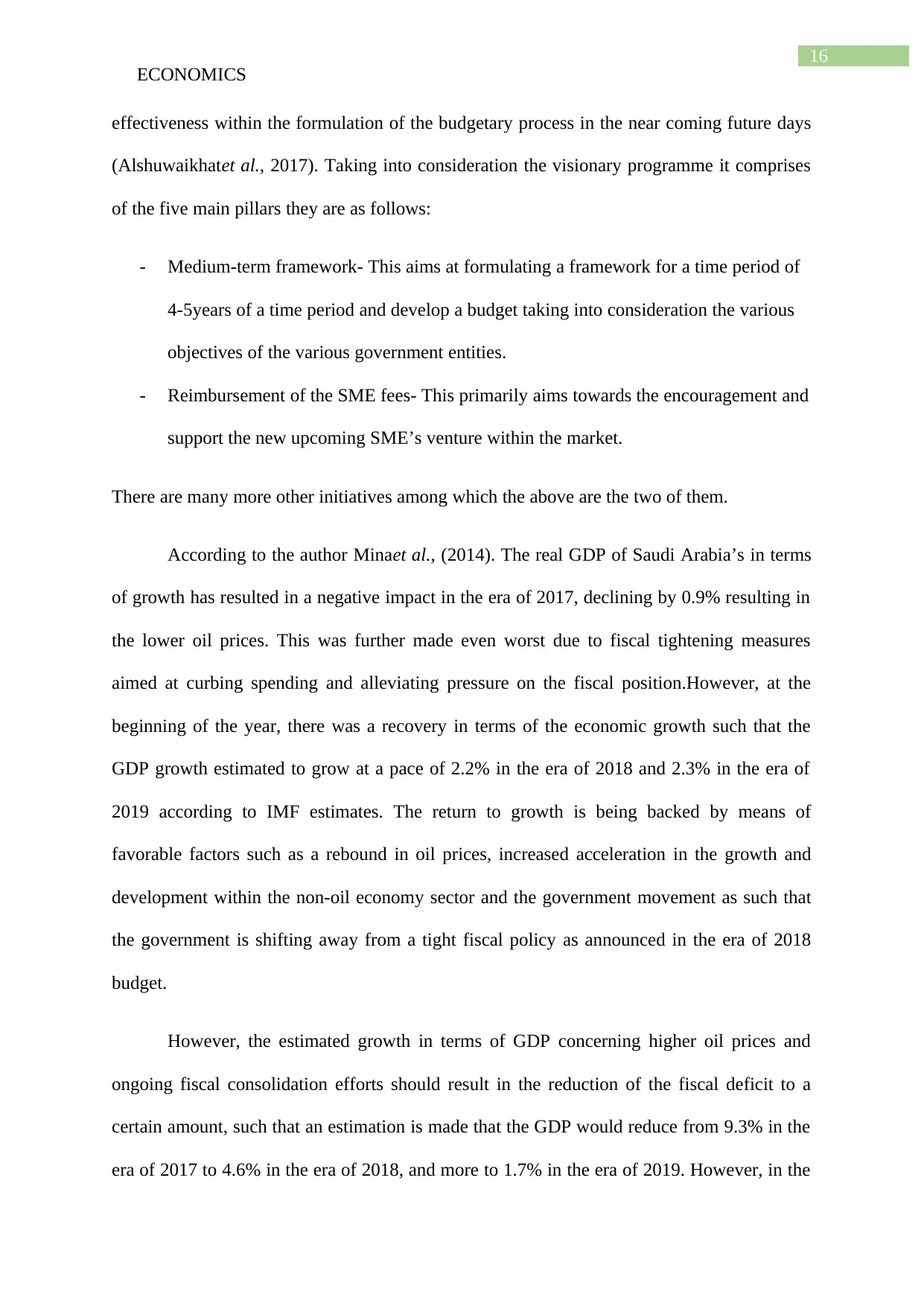
16
ECONOMICS
effectiveness within the formulation of the budgetary process in the near coming future days
(Alshuwaikhatet al., 2017). Taking into consideration the visionary programme it comprises
of the five main pillars they are as follows:
- Medium-term framework- This aims at formulating a framework for a time period of
4-5years of a time period and develop a budget taking into consideration the various
objectives of the various government entities.
- Reimbursement of the SME fees- This primarily aims towards the encouragement and
support the new upcoming SME’s venture within the market.
There are many more other initiatives among which the above are the two of them.
According to the author Minaet al., (2014). The real GDP of Saudi Arabia’s in terms
of growth has resulted in a negative impact in the era of 2017, declining by 0.9% resulting in
the lower oil prices. This was further made even worst due to fiscal tightening measures
aimed at curbing spending and alleviating pressure on the fiscal position.However, at the
beginning of the year, there was a recovery in terms of the economic growth such that the
GDP growth estimated to grow at a pace of 2.2% in the era of 2018 and 2.3% in the era of
2019 according to IMF estimates. The return to growth is being backed by means of
favorable factors such as a rebound in oil prices, increased acceleration in the growth and
development within the non-oil economy sector and the government movement as such that
the government is shifting away from a tight fiscal policy as announced in the era of 2018
budget.
However, the estimated growth in terms of GDP concerning higher oil prices and
ongoing fiscal consolidation efforts should result in the reduction of the fiscal deficit to a
certain amount, such that an estimation is made that the GDP would reduce from 9.3% in the
era of 2017 to 4.6% in the era of 2018, and more to 1.7% in the era of 2019. However, in the
ECONOMICS
effectiveness within the formulation of the budgetary process in the near coming future days
(Alshuwaikhatet al., 2017). Taking into consideration the visionary programme it comprises
of the five main pillars they are as follows:
- Medium-term framework- This aims at formulating a framework for a time period of
4-5years of a time period and develop a budget taking into consideration the various
objectives of the various government entities.
- Reimbursement of the SME fees- This primarily aims towards the encouragement and
support the new upcoming SME’s venture within the market.
There are many more other initiatives among which the above are the two of them.
According to the author Minaet al., (2014). The real GDP of Saudi Arabia’s in terms
of growth has resulted in a negative impact in the era of 2017, declining by 0.9% resulting in
the lower oil prices. This was further made even worst due to fiscal tightening measures
aimed at curbing spending and alleviating pressure on the fiscal position.However, at the
beginning of the year, there was a recovery in terms of the economic growth such that the
GDP growth estimated to grow at a pace of 2.2% in the era of 2018 and 2.3% in the era of
2019 according to IMF estimates. The return to growth is being backed by means of
favorable factors such as a rebound in oil prices, increased acceleration in the growth and
development within the non-oil economy sector and the government movement as such that
the government is shifting away from a tight fiscal policy as announced in the era of 2018
budget.
However, the estimated growth in terms of GDP concerning higher oil prices and
ongoing fiscal consolidation efforts should result in the reduction of the fiscal deficit to a
certain amount, such that an estimation is made that the GDP would reduce from 9.3% in the
era of 2017 to 4.6% in the era of 2018, and more to 1.7% in the era of 2019. However, in the
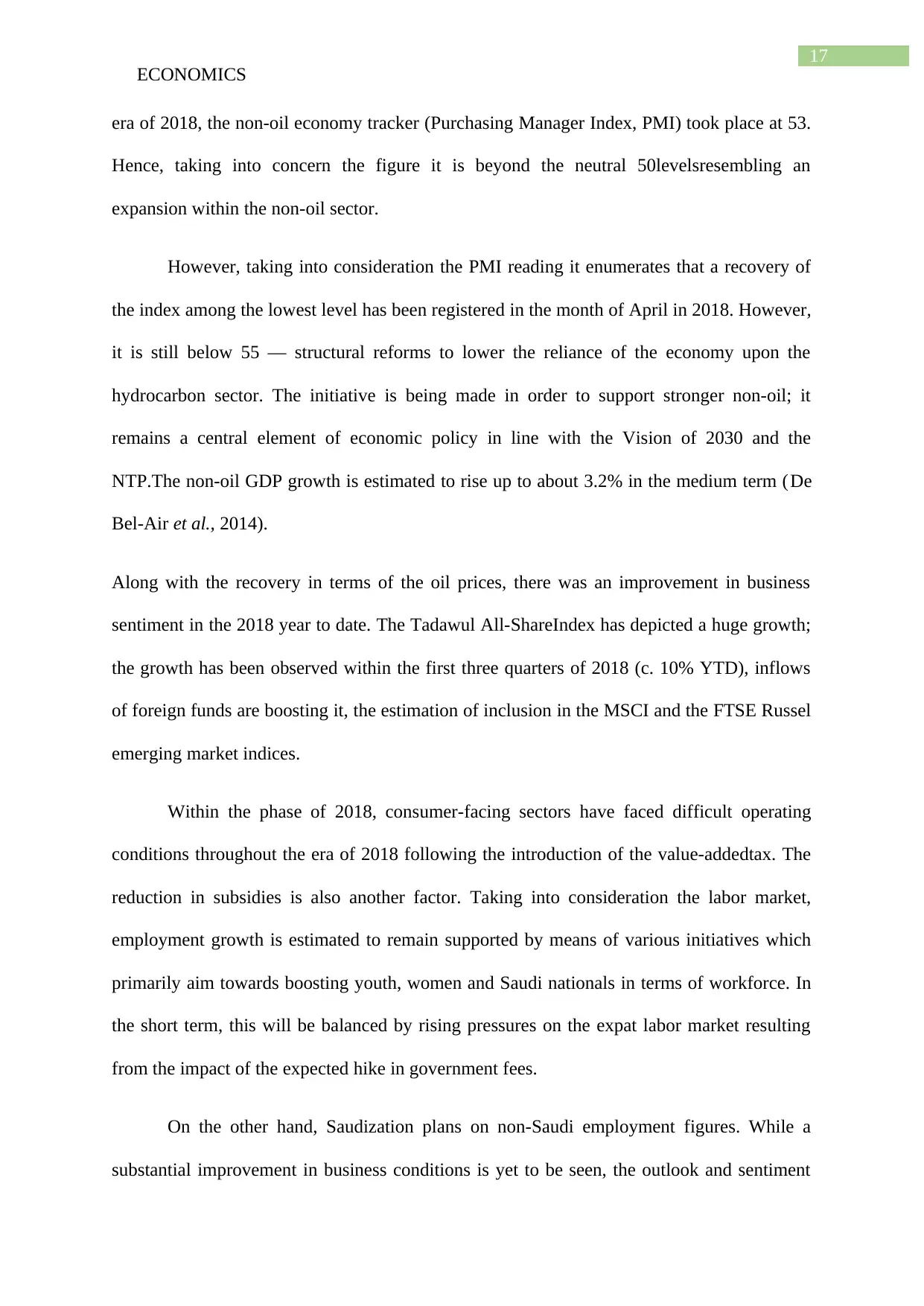
17
ECONOMICS
era of 2018, the non-oil economy tracker (Purchasing Manager Index, PMI) took place at 53.
Hence, taking into concern the figure it is beyond the neutral 50levelsresembling an
expansion within the non-oil sector.
However, taking into consideration the PMI reading it enumerates that a recovery of
the index among the lowest level has been registered in the month of April in 2018. However,
it is still below 55 — structural reforms to lower the reliance of the economy upon the
hydrocarbon sector. The initiative is being made in order to support stronger non-oil; it
remains a central element of economic policy in line with the Vision of 2030 and the
NTP.The non-oil GDP growth is estimated to rise up to about 3.2% in the medium term (De
Bel-Air et al., 2014).
Along with the recovery in terms of the oil prices, there was an improvement in business
sentiment in the 2018 year to date. The Tadawul All-ShareIndex has depicted a huge growth;
the growth has been observed within the first three quarters of 2018 (c. 10% YTD), inflows
of foreign funds are boosting it, the estimation of inclusion in the MSCI and the FTSE Russel
emerging market indices.
Within the phase of 2018, consumer-facing sectors have faced difficult operating
conditions throughout the era of 2018 following the introduction of the value-addedtax. The
reduction in subsidies is also another factor. Taking into consideration the labor market,
employment growth is estimated to remain supported by means of various initiatives which
primarily aim towards boosting youth, women and Saudi nationals in terms of workforce. In
the short term, this will be balanced by rising pressures on the expat labor market resulting
from the impact of the expected hike in government fees.
On the other hand, Saudization plans on non-Saudi employment figures. While a
substantial improvement in business conditions is yet to be seen, the outlook and sentiment
ECONOMICS
era of 2018, the non-oil economy tracker (Purchasing Manager Index, PMI) took place at 53.
Hence, taking into concern the figure it is beyond the neutral 50levelsresembling an
expansion within the non-oil sector.
However, taking into consideration the PMI reading it enumerates that a recovery of
the index among the lowest level has been registered in the month of April in 2018. However,
it is still below 55 — structural reforms to lower the reliance of the economy upon the
hydrocarbon sector. The initiative is being made in order to support stronger non-oil; it
remains a central element of economic policy in line with the Vision of 2030 and the
NTP.The non-oil GDP growth is estimated to rise up to about 3.2% in the medium term (De
Bel-Air et al., 2014).
Along with the recovery in terms of the oil prices, there was an improvement in business
sentiment in the 2018 year to date. The Tadawul All-ShareIndex has depicted a huge growth;
the growth has been observed within the first three quarters of 2018 (c. 10% YTD), inflows
of foreign funds are boosting it, the estimation of inclusion in the MSCI and the FTSE Russel
emerging market indices.
Within the phase of 2018, consumer-facing sectors have faced difficult operating
conditions throughout the era of 2018 following the introduction of the value-addedtax. The
reduction in subsidies is also another factor. Taking into consideration the labor market,
employment growth is estimated to remain supported by means of various initiatives which
primarily aim towards boosting youth, women and Saudi nationals in terms of workforce. In
the short term, this will be balanced by rising pressures on the expat labor market resulting
from the impact of the expected hike in government fees.
On the other hand, Saudization plans on non-Saudi employment figures. While a
substantial improvement in business conditions is yet to be seen, the outlook and sentiment
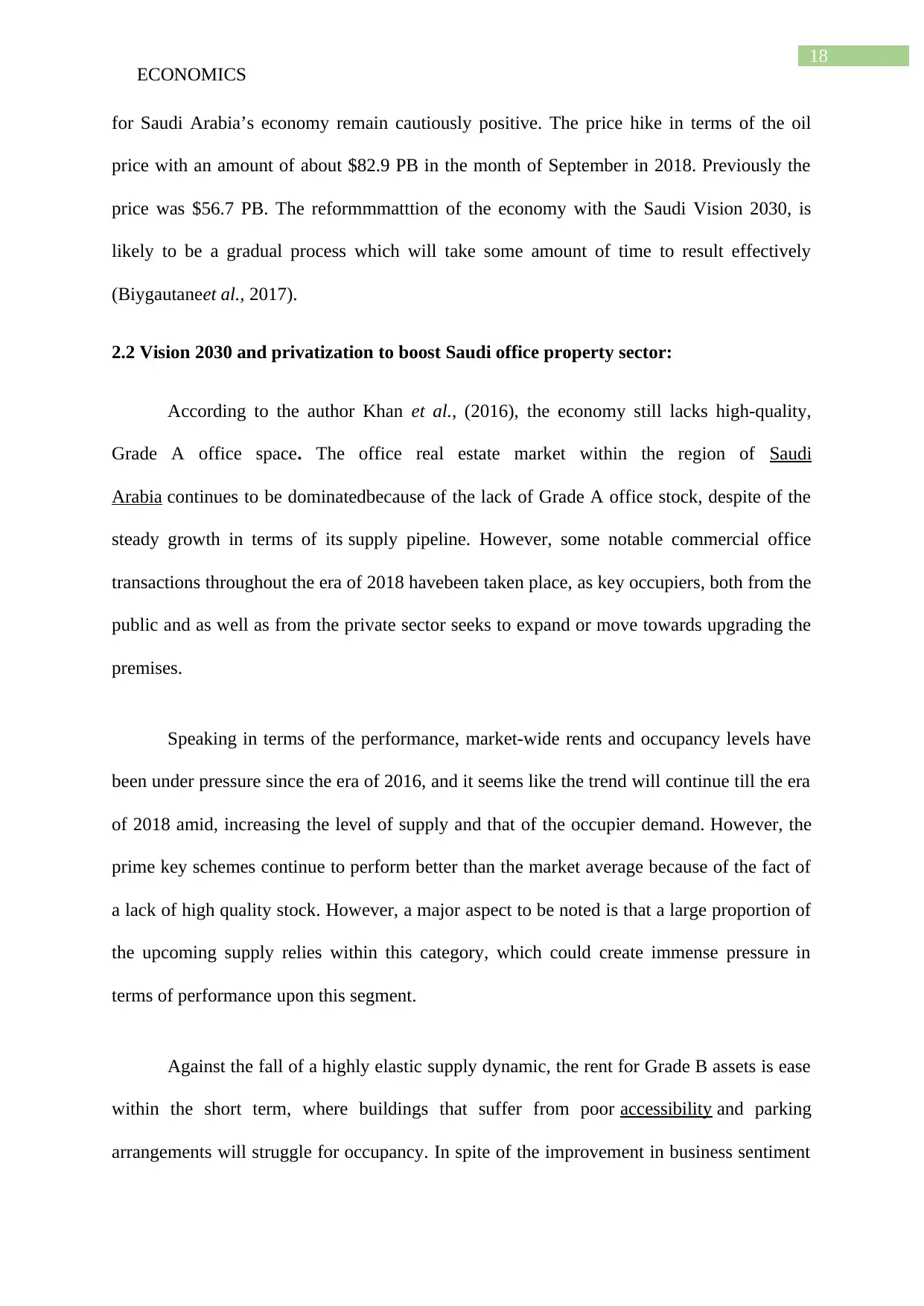
18
ECONOMICS
for Saudi Arabia’s economy remain cautiously positive. The price hike in terms of the oil
price with an amount of about $82.9 PB in the month of September in 2018. Previously the
price was $56.7 PB. The reformmmatttion of the economy with the Saudi Vision 2030, is
likely to be a gradual process which will take some amount of time to result effectively
(Biygautaneet al., 2017).
2.2 Vision 2030 and privatization to boost Saudi office property sector:
According to the author Khan et al., (2016), the economy still lacks high-quality,
Grade A office space. The office real estate market within the region of Saudi
Arabia continues to be dominatedbecause of the lack of Grade A office stock, despite of the
steady growth in terms of its supply pipeline. However, some notable commercial office
transactions throughout the era of 2018 havebeen taken place, as key occupiers, both from the
public and as well as from the private sector seeks to expand or move towards upgrading the
premises.
Speaking in terms of the performance, market-wide rents and occupancy levels have
been under pressure since the era of 2016, and it seems like the trend will continue till the era
of 2018 amid, increasing the level of supply and that of the occupier demand. However, the
prime key schemes continue to perform better than the market average because of the fact of
a lack of high quality stock. However, a major aspect to be noted is that a large proportion of
the upcoming supply relies within this category, which could create immense pressure in
terms of performance upon this segment.
Against the fall of a highly elastic supply dynamic, the rent for Grade B assets is ease
within the short term, where buildings that suffer from poor accessibility and parking
arrangements will struggle for occupancy. In spite of the improvement in business sentiment
ECONOMICS
for Saudi Arabia’s economy remain cautiously positive. The price hike in terms of the oil
price with an amount of about $82.9 PB in the month of September in 2018. Previously the
price was $56.7 PB. The reformmmatttion of the economy with the Saudi Vision 2030, is
likely to be a gradual process which will take some amount of time to result effectively
(Biygautaneet al., 2017).
2.2 Vision 2030 and privatization to boost Saudi office property sector:
According to the author Khan et al., (2016), the economy still lacks high-quality,
Grade A office space. The office real estate market within the region of Saudi
Arabia continues to be dominatedbecause of the lack of Grade A office stock, despite of the
steady growth in terms of its supply pipeline. However, some notable commercial office
transactions throughout the era of 2018 havebeen taken place, as key occupiers, both from the
public and as well as from the private sector seeks to expand or move towards upgrading the
premises.
Speaking in terms of the performance, market-wide rents and occupancy levels have
been under pressure since the era of 2016, and it seems like the trend will continue till the era
of 2018 amid, increasing the level of supply and that of the occupier demand. However, the
prime key schemes continue to perform better than the market average because of the fact of
a lack of high quality stock. However, a major aspect to be noted is that a large proportion of
the upcoming supply relies within this category, which could create immense pressure in
terms of performance upon this segment.
Against the fall of a highly elastic supply dynamic, the rent for Grade B assets is ease
within the short term, where buildings that suffer from poor accessibility and parking
arrangements will struggle for occupancy. In spite of the improvement in business sentiment
Paraphrase This Document
Need a fresh take? Get an instant paraphrase of this document with our AI Paraphraser
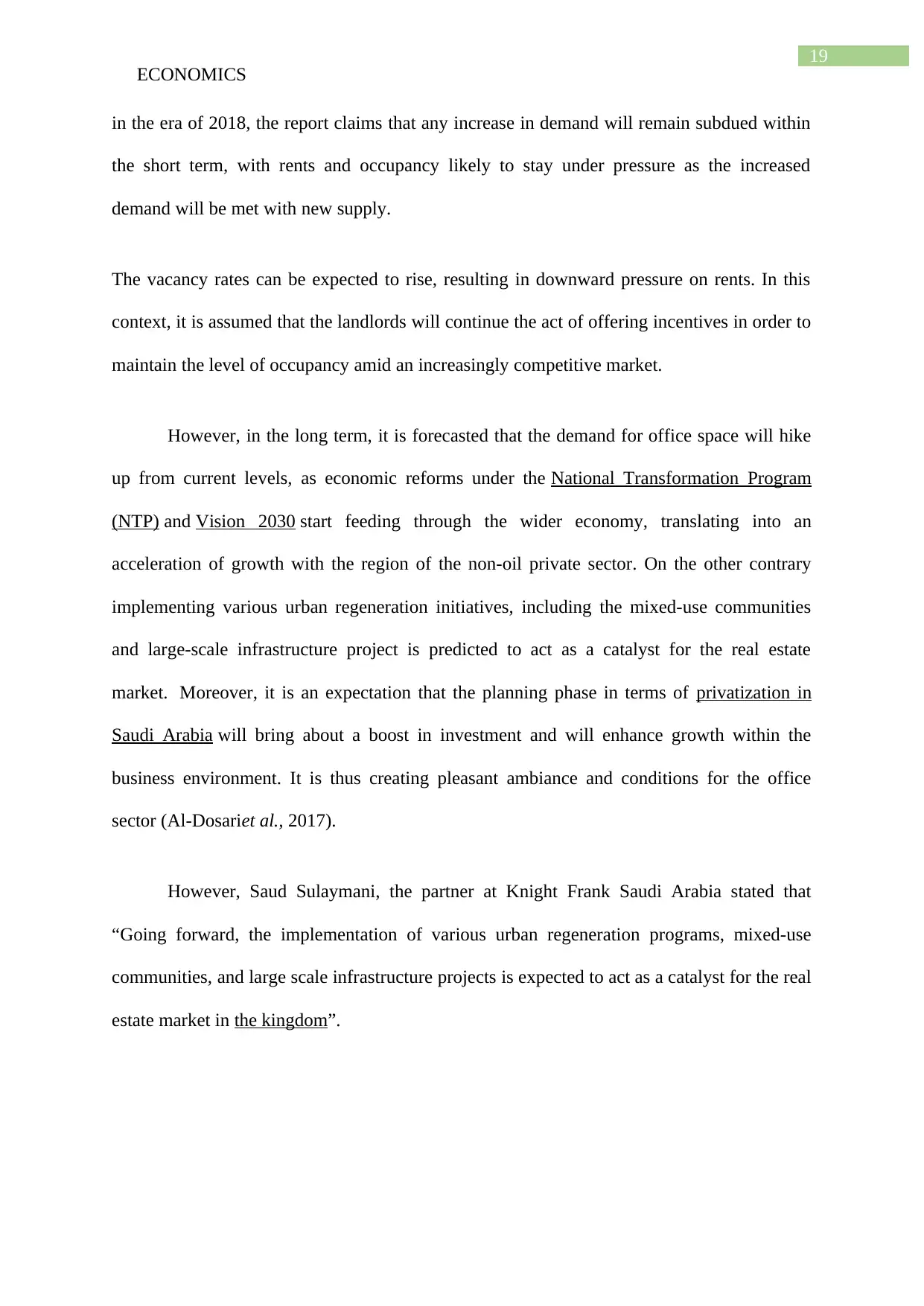
19
ECONOMICS
in the era of 2018, the report claims that any increase in demand will remain subdued within
the short term, with rents and occupancy likely to stay under pressure as the increased
demand will be met with new supply.
The vacancy rates can be expected to rise, resulting in downward pressure on rents. In this
context, it is assumed that the landlords will continue the act of offering incentives in order to
maintain the level of occupancy amid an increasingly competitive market.
However, in the long term, it is forecasted that the demand for office space will hike
up from current levels, as economic reforms under the National Transformation Program
(NTP) and Vision 2030 start feeding through the wider economy, translating into an
acceleration of growth with the region of the non-oil private sector. On the other contrary
implementing various urban regeneration initiatives, including the mixed-use communities
and large-scale infrastructure project is predicted to act as a catalyst for the real estate
market. Moreover, it is an expectation that the planning phase in terms of privatization in
Saudi Arabia will bring about a boost in investment and will enhance growth within the
business environment. It is thus creating pleasant ambiance and conditions for the office
sector (Al-Dosariet al., 2017).
However, Saud Sulaymani, the partner at Knight Frank Saudi Arabia stated that
“Going forward, the implementation of various urban regeneration programs, mixed-use
communities, and large scale infrastructure projects is expected to act as a catalyst for the real
estate market in the kingdom”.
ECONOMICS
in the era of 2018, the report claims that any increase in demand will remain subdued within
the short term, with rents and occupancy likely to stay under pressure as the increased
demand will be met with new supply.
The vacancy rates can be expected to rise, resulting in downward pressure on rents. In this
context, it is assumed that the landlords will continue the act of offering incentives in order to
maintain the level of occupancy amid an increasingly competitive market.
However, in the long term, it is forecasted that the demand for office space will hike
up from current levels, as economic reforms under the National Transformation Program
(NTP) and Vision 2030 start feeding through the wider economy, translating into an
acceleration of growth with the region of the non-oil private sector. On the other contrary
implementing various urban regeneration initiatives, including the mixed-use communities
and large-scale infrastructure project is predicted to act as a catalyst for the real estate
market. Moreover, it is an expectation that the planning phase in terms of privatization in
Saudi Arabia will bring about a boost in investment and will enhance growth within the
business environment. It is thus creating pleasant ambiance and conditions for the office
sector (Al-Dosariet al., 2017).
However, Saud Sulaymani, the partner at Knight Frank Saudi Arabia stated that
“Going forward, the implementation of various urban regeneration programs, mixed-use
communities, and large scale infrastructure projects is expected to act as a catalyst for the real
estate market in the kingdom”.

20
ECONOMICS
2.3 The Saudi-Arabia real estate market shows promising growth from vision 2030:
According to author Paul et al., (2016), The Foreign investors are seeking an
opportunity in order to invest in the Saudi Arabia real estate market; it is the interest of the
foreign investors which they have evolved due to the multiple announcements made by the
visionary programme over the last year, Vision 2030. Howevera number of feedback were
generated from the local public of Saudi-Arabia, they were asked in regard to the faith and
believe that they have towards the visionary programme.
Among the chosen focus group, the total proportion of about 50 percent of the citizens
expecting the Vision 2030 programme to bring about increase in development within the real
estate market in Riyadh, specifically within the residential properties. It was an estimation
made by the 33% of the observers, while 43% of the observer expect an increase in the real
estate development in Jeddah and Mecca. Besides, the observes also had faith that the Vision
2030 programme would result in an increase in the retail/commercial units and enable the
flow of foreign direct investment within the region of Saudi Arabia.
After finally evaluating the observer's expectations, it was found that the major
proportions of the observer had a plan to purchase a property in the Saudi-Arabia region
within the next year. However, it was also found that among the observer about 23%, already
possess property in the Saudi – Arabia region.
Ahmed Zakaria, addressed as the exhibition director of Restatex Cityscape in Riyadh, stated
that ““It’s clear that there is a significant number of investors and home buyers interested in
investing in real estate in the Kingdom and they’re looking at plans set by the government,
like Vision 2030, as ways to boost real estate investment development.”
However, the feedback of the observer also introduced light to the fact that affordability is a
primary concern in the region of the Saudi –Arabia. About 41% of the observer claims that
there is a lack of affordable units.
ECONOMICS
2.3 The Saudi-Arabia real estate market shows promising growth from vision 2030:
According to author Paul et al., (2016), The Foreign investors are seeking an
opportunity in order to invest in the Saudi Arabia real estate market; it is the interest of the
foreign investors which they have evolved due to the multiple announcements made by the
visionary programme over the last year, Vision 2030. Howevera number of feedback were
generated from the local public of Saudi-Arabia, they were asked in regard to the faith and
believe that they have towards the visionary programme.
Among the chosen focus group, the total proportion of about 50 percent of the citizens
expecting the Vision 2030 programme to bring about increase in development within the real
estate market in Riyadh, specifically within the residential properties. It was an estimation
made by the 33% of the observers, while 43% of the observer expect an increase in the real
estate development in Jeddah and Mecca. Besides, the observes also had faith that the Vision
2030 programme would result in an increase in the retail/commercial units and enable the
flow of foreign direct investment within the region of Saudi Arabia.
After finally evaluating the observer's expectations, it was found that the major
proportions of the observer had a plan to purchase a property in the Saudi-Arabia region
within the next year. However, it was also found that among the observer about 23%, already
possess property in the Saudi – Arabia region.
Ahmed Zakaria, addressed as the exhibition director of Restatex Cityscape in Riyadh, stated
that ““It’s clear that there is a significant number of investors and home buyers interested in
investing in real estate in the Kingdom and they’re looking at plans set by the government,
like Vision 2030, as ways to boost real estate investment development.”
However, the feedback of the observer also introduced light to the fact that affordability is a
primary concern in the region of the Saudi –Arabia. About 41% of the observer claims that
there is a lack of affordable units.
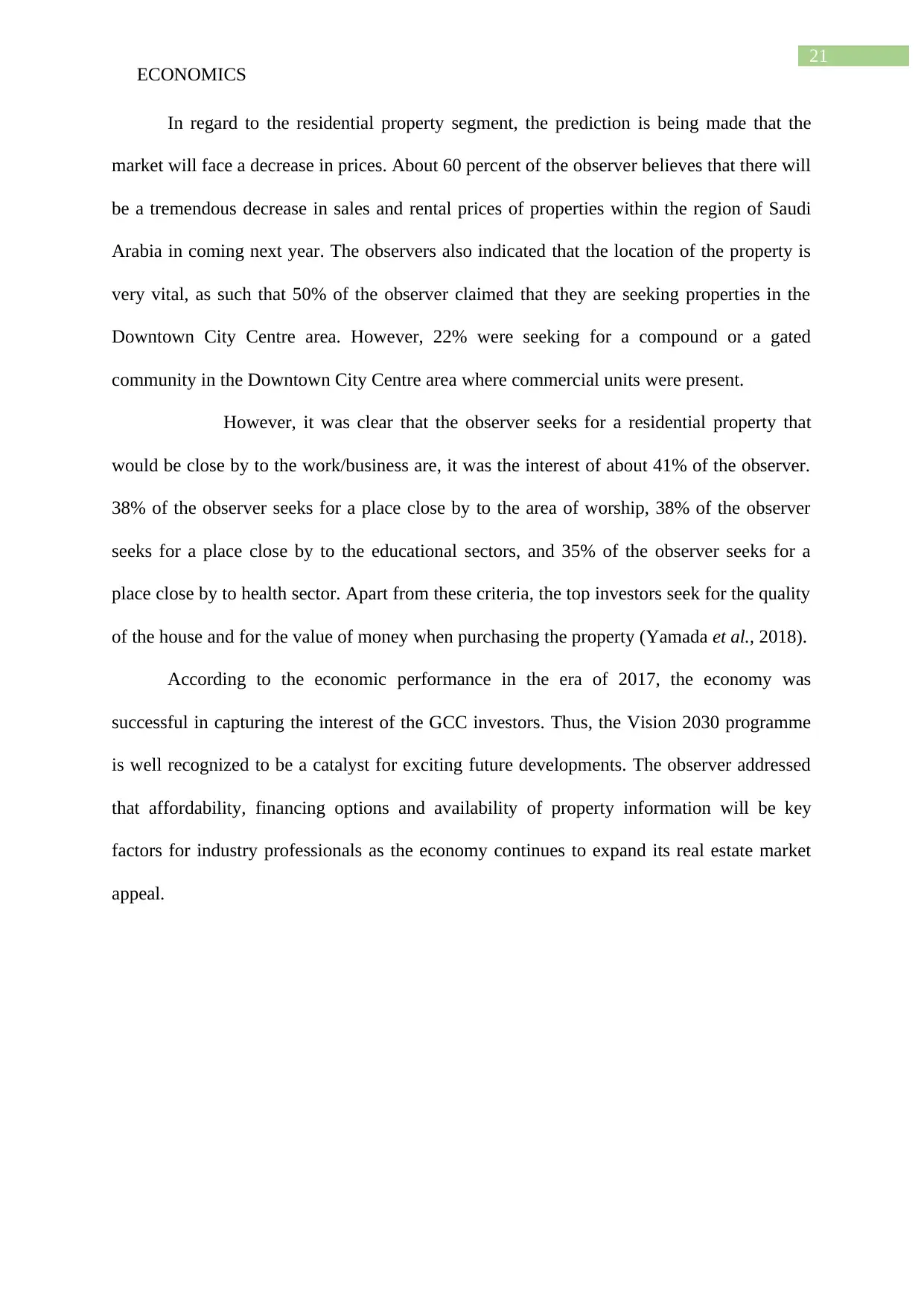
21
ECONOMICS
In regard to the residential property segment, the prediction is being made that the
market will face a decrease in prices. About 60 percent of the observer believes that there will
be a tremendous decrease in sales and rental prices of properties within the region of Saudi
Arabia in coming next year. The observers also indicated that the location of the property is
very vital, as such that 50% of the observer claimed that they are seeking properties in the
Downtown City Centre area. However, 22% were seeking for a compound or a gated
community in the Downtown City Centre area where commercial units were present.
However, it was clear that the observer seeks for a residential property that
would be close by to the work/business are, it was the interest of about 41% of the observer.
38% of the observer seeks for a place close by to the area of worship, 38% of the observer
seeks for a place close by to the educational sectors, and 35% of the observer seeks for a
place close by to health sector. Apart from these criteria, the top investors seek for the quality
of the house and for the value of money when purchasing the property (Yamada et al., 2018).
According to the economic performance in the era of 2017, the economy was
successful in capturing the interest of the GCC investors. Thus, the Vision 2030 programme
is well recognized to be a catalyst for exciting future developments. The observer addressed
that affordability, financing options and availability of property information will be key
factors for industry professionals as the economy continues to expand its real estate market
appeal.
ECONOMICS
In regard to the residential property segment, the prediction is being made that the
market will face a decrease in prices. About 60 percent of the observer believes that there will
be a tremendous decrease in sales and rental prices of properties within the region of Saudi
Arabia in coming next year. The observers also indicated that the location of the property is
very vital, as such that 50% of the observer claimed that they are seeking properties in the
Downtown City Centre area. However, 22% were seeking for a compound or a gated
community in the Downtown City Centre area where commercial units were present.
However, it was clear that the observer seeks for a residential property that
would be close by to the work/business are, it was the interest of about 41% of the observer.
38% of the observer seeks for a place close by to the area of worship, 38% of the observer
seeks for a place close by to the educational sectors, and 35% of the observer seeks for a
place close by to health sector. Apart from these criteria, the top investors seek for the quality
of the house and for the value of money when purchasing the property (Yamada et al., 2018).
According to the economic performance in the era of 2017, the economy was
successful in capturing the interest of the GCC investors. Thus, the Vision 2030 programme
is well recognized to be a catalyst for exciting future developments. The observer addressed
that affordability, financing options and availability of property information will be key
factors for industry professionals as the economy continues to expand its real estate market
appeal.
Secure Best Marks with AI Grader
Need help grading? Try our AI Grader for instant feedback on your assignments.
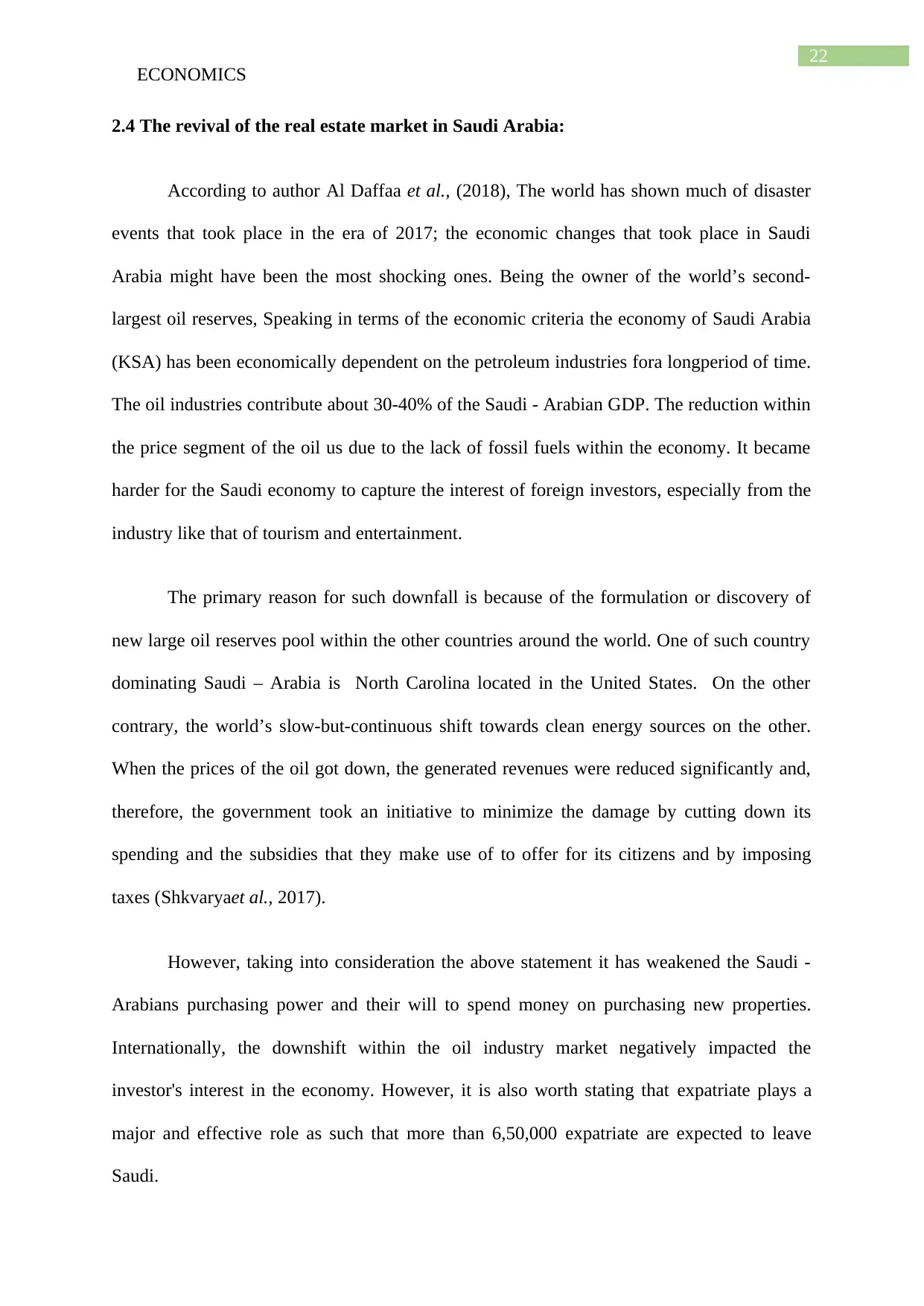
22
ECONOMICS
2.4 The revival of the real estate market in Saudi Arabia:
According to author Al Daffaa et al., (2018), The world has shown much of disaster
events that took place in the era of 2017; the economic changes that took place in Saudi
Arabia might have been the most shocking ones. Being the owner of the world’s second-
largest oil reserves, Speaking in terms of the economic criteria the economy of Saudi Arabia
(KSA) has been economically dependent on the petroleum industries fora longperiod of time.
The oil industries contribute about 30-40% of the Saudi - Arabian GDP. The reduction within
the price segment of the oil us due to the lack of fossil fuels within the economy. It became
harder for the Saudi economy to capture the interest of foreign investors, especially from the
industry like that of tourism and entertainment.
The primary reason for such downfall is because of the formulation or discovery of
new large oil reserves pool within the other countries around the world. One of such country
dominating Saudi – Arabia is North Carolina located in the United States. On the other
contrary, the world’s slow-but-continuous shift towards clean energy sources on the other.
When the prices of the oil got down, the generated revenues were reduced significantly and,
therefore, the government took an initiative to minimize the damage by cutting down its
spending and the subsidies that they make use of to offer for its citizens and by imposing
taxes (Shkvaryaet al., 2017).
However, taking into consideration the above statement it has weakened the Saudi -
Arabians purchasing power and their will to spend money on purchasing new properties.
Internationally, the downshift within the oil industry market negatively impacted the
investor's interest in the economy. However, it is also worth stating that expatriate plays a
major and effective role as such that more than 6,50,000 expatriate are expected to leave
Saudi.
ECONOMICS
2.4 The revival of the real estate market in Saudi Arabia:
According to author Al Daffaa et al., (2018), The world has shown much of disaster
events that took place in the era of 2017; the economic changes that took place in Saudi
Arabia might have been the most shocking ones. Being the owner of the world’s second-
largest oil reserves, Speaking in terms of the economic criteria the economy of Saudi Arabia
(KSA) has been economically dependent on the petroleum industries fora longperiod of time.
The oil industries contribute about 30-40% of the Saudi - Arabian GDP. The reduction within
the price segment of the oil us due to the lack of fossil fuels within the economy. It became
harder for the Saudi economy to capture the interest of foreign investors, especially from the
industry like that of tourism and entertainment.
The primary reason for such downfall is because of the formulation or discovery of
new large oil reserves pool within the other countries around the world. One of such country
dominating Saudi – Arabia is North Carolina located in the United States. On the other
contrary, the world’s slow-but-continuous shift towards clean energy sources on the other.
When the prices of the oil got down, the generated revenues were reduced significantly and,
therefore, the government took an initiative to minimize the damage by cutting down its
spending and the subsidies that they make use of to offer for its citizens and by imposing
taxes (Shkvaryaet al., 2017).
However, taking into consideration the above statement it has weakened the Saudi -
Arabians purchasing power and their will to spend money on purchasing new properties.
Internationally, the downshift within the oil industry market negatively impacted the
investor's interest in the economy. However, it is also worth stating that expatriate plays a
major and effective role as such that more than 6,50,000 expatriate are expected to leave
Saudi.
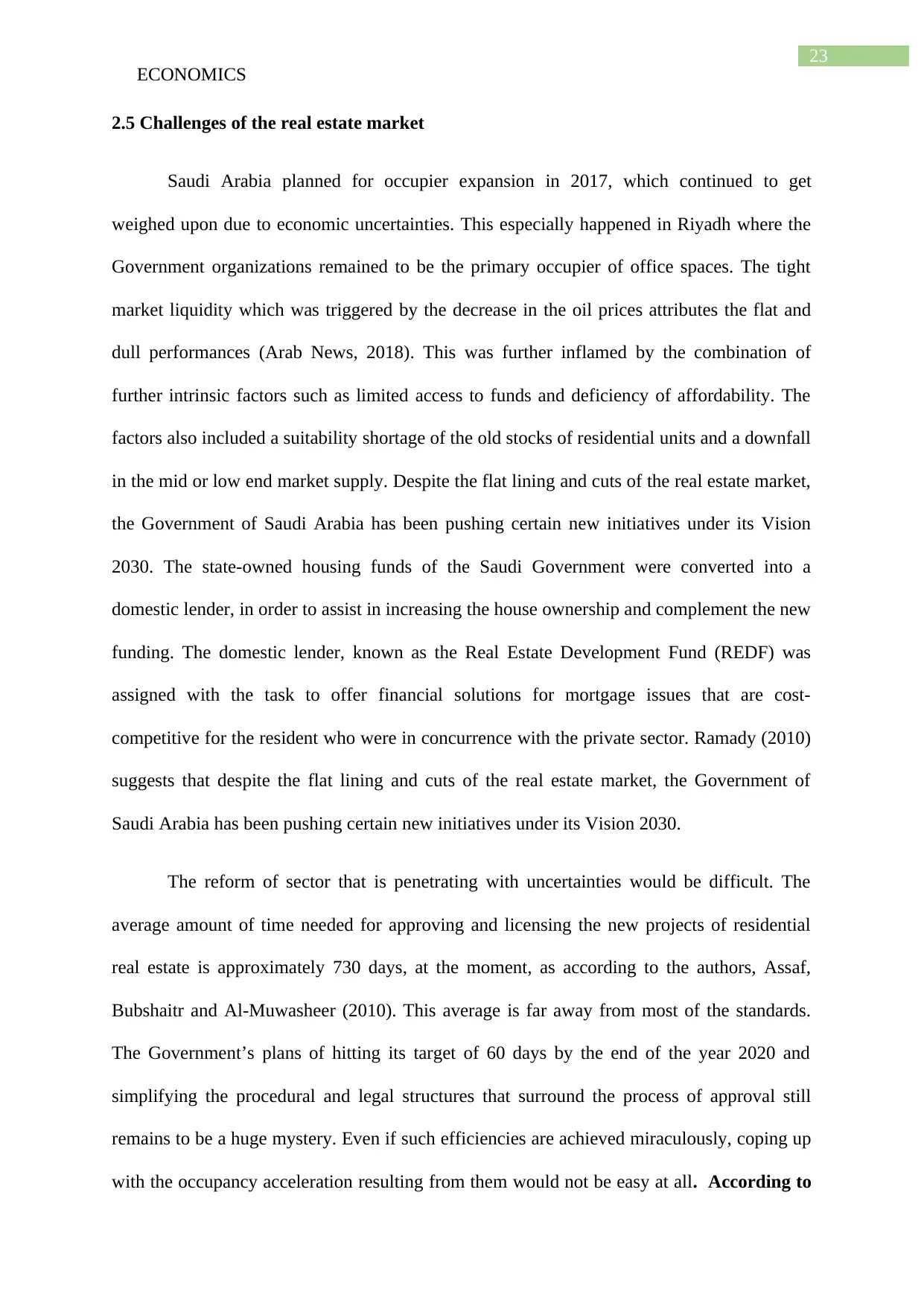
23
ECONOMICS
2.5 Challenges of the real estate market
Saudi Arabia planned for occupier expansion in 2017, which continued to get
weighed upon due to economic uncertainties. This especially happened in Riyadh where the
Government organizations remained to be the primary occupier of office spaces. The tight
market liquidity which was triggered by the decrease in the oil prices attributes the flat and
dull performances (Arab News, 2018). This was further inflamed by the combination of
further intrinsic factors such as limited access to funds and deficiency of affordability. The
factors also included a suitability shortage of the old stocks of residential units and a downfall
in the mid or low end market supply. Despite the flat lining and cuts of the real estate market,
the Government of Saudi Arabia has been pushing certain new initiatives under its Vision
2030. The state-owned housing funds of the Saudi Government were converted into a
domestic lender, in order to assist in increasing the house ownership and complement the new
funding. The domestic lender, known as the Real Estate Development Fund (REDF) was
assigned with the task to offer financial solutions for mortgage issues that are cost-
competitive for the resident who were in concurrence with the private sector. Ramady (2010)
suggests that despite the flat lining and cuts of the real estate market, the Government of
Saudi Arabia has been pushing certain new initiatives under its Vision 2030.
The reform of sector that is penetrating with uncertainties would be difficult. The
average amount of time needed for approving and licensing the new projects of residential
real estate is approximately 730 days, at the moment, as according to the authors, Assaf,
Bubshaitr and Al-Muwasheer (2010). This average is far away from most of the standards.
The Government’s plans of hitting its target of 60 days by the end of the year 2020 and
simplifying the procedural and legal structures that surround the process of approval still
remains to be a huge mystery. Even if such efficiencies are achieved miraculously, coping up
with the occupancy acceleration resulting from them would not be easy at all. According to
ECONOMICS
2.5 Challenges of the real estate market
Saudi Arabia planned for occupier expansion in 2017, which continued to get
weighed upon due to economic uncertainties. This especially happened in Riyadh where the
Government organizations remained to be the primary occupier of office spaces. The tight
market liquidity which was triggered by the decrease in the oil prices attributes the flat and
dull performances (Arab News, 2018). This was further inflamed by the combination of
further intrinsic factors such as limited access to funds and deficiency of affordability. The
factors also included a suitability shortage of the old stocks of residential units and a downfall
in the mid or low end market supply. Despite the flat lining and cuts of the real estate market,
the Government of Saudi Arabia has been pushing certain new initiatives under its Vision
2030. The state-owned housing funds of the Saudi Government were converted into a
domestic lender, in order to assist in increasing the house ownership and complement the new
funding. The domestic lender, known as the Real Estate Development Fund (REDF) was
assigned with the task to offer financial solutions for mortgage issues that are cost-
competitive for the resident who were in concurrence with the private sector. Ramady (2010)
suggests that despite the flat lining and cuts of the real estate market, the Government of
Saudi Arabia has been pushing certain new initiatives under its Vision 2030.
The reform of sector that is penetrating with uncertainties would be difficult. The
average amount of time needed for approving and licensing the new projects of residential
real estate is approximately 730 days, at the moment, as according to the authors, Assaf,
Bubshaitr and Al-Muwasheer (2010). This average is far away from most of the standards.
The Government’s plans of hitting its target of 60 days by the end of the year 2020 and
simplifying the procedural and legal structures that surround the process of approval still
remains to be a huge mystery. Even if such efficiencies are achieved miraculously, coping up
with the occupancy acceleration resulting from them would not be easy at all. According to

24
ECONOMICS
Al Buloushi, it would be very challenging to rent the built-up areas at significant prices
and achieve reasonable rates of occupancy (Bonds & Loans, 2018). Most of the real estate
projects of Saudi Arabia are funded and financially assisted by the local and regional banks.
Susilawati and Al Surf (2011) suggest that the Public Investment Fund of the country
supports all of these projects; however, in order to bring them to fulfillment, international
liquidity will be required on an unparalleled scale. According to bankers, this in itself is a big
issue due to several reasons, in spite of the refrain of banks securing licenses of investment
banking in the economy.
2.6 Revival of the real estate market
Even though several drastic changes have been seen by the world in the year 2017, the
changes taking place in Saudi Arabia, are one of the most shocking and unbelievable changes
ever seen. These shifts became necessary after there was a huge downfall in the markets of
both, real estate as well the petroleum. Being the second largest owner of oil reserves of the
world, the Kingdom of Saudi Arabia (KSA) has been frugally dependent on the petroleum
industry for a long period of time (Alshehry and Belloumi, 2015). This industry and that of
the real estate have been the sole backbone of the economy of the country’s kingdom. The
Saudi Arabian GDP is contributed by 30-40% by the oil industry which includes the other
industries as well which are dependent upon the former (Callen, Cherif, Hasanov, Hegazy
and Khandelwal, 2014). The primary for this was its society’s conservative nature as well as
the kingdom’s prosperity and bounty of fossil fuels and natural resources. In comparison with
its competitive neighbor countries, it was more difficult for Saudi Arabia to lure investors
from various industries such as entertainment and tourism. The economy the country was hit
hardest by the ruination of the oil prices that took place in the past two years. The primary
cause for such a crisis was the discovery of huge reserves of oil and fossil fuels in other
ECONOMICS
Al Buloushi, it would be very challenging to rent the built-up areas at significant prices
and achieve reasonable rates of occupancy (Bonds & Loans, 2018). Most of the real estate
projects of Saudi Arabia are funded and financially assisted by the local and regional banks.
Susilawati and Al Surf (2011) suggest that the Public Investment Fund of the country
supports all of these projects; however, in order to bring them to fulfillment, international
liquidity will be required on an unparalleled scale. According to bankers, this in itself is a big
issue due to several reasons, in spite of the refrain of banks securing licenses of investment
banking in the economy.
2.6 Revival of the real estate market
Even though several drastic changes have been seen by the world in the year 2017, the
changes taking place in Saudi Arabia, are one of the most shocking and unbelievable changes
ever seen. These shifts became necessary after there was a huge downfall in the markets of
both, real estate as well the petroleum. Being the second largest owner of oil reserves of the
world, the Kingdom of Saudi Arabia (KSA) has been frugally dependent on the petroleum
industry for a long period of time (Alshehry and Belloumi, 2015). This industry and that of
the real estate have been the sole backbone of the economy of the country’s kingdom. The
Saudi Arabian GDP is contributed by 30-40% by the oil industry which includes the other
industries as well which are dependent upon the former (Callen, Cherif, Hasanov, Hegazy
and Khandelwal, 2014). The primary for this was its society’s conservative nature as well as
the kingdom’s prosperity and bounty of fossil fuels and natural resources. In comparison with
its competitive neighbor countries, it was more difficult for Saudi Arabia to lure investors
from various industries such as entertainment and tourism. The economy the country was hit
hardest by the ruination of the oil prices that took place in the past two years. The primary
cause for such a crisis was the discovery of huge reserves of oil and fossil fuels in other
Paraphrase This Document
Need a fresh take? Get an instant paraphrase of this document with our AI Paraphraser
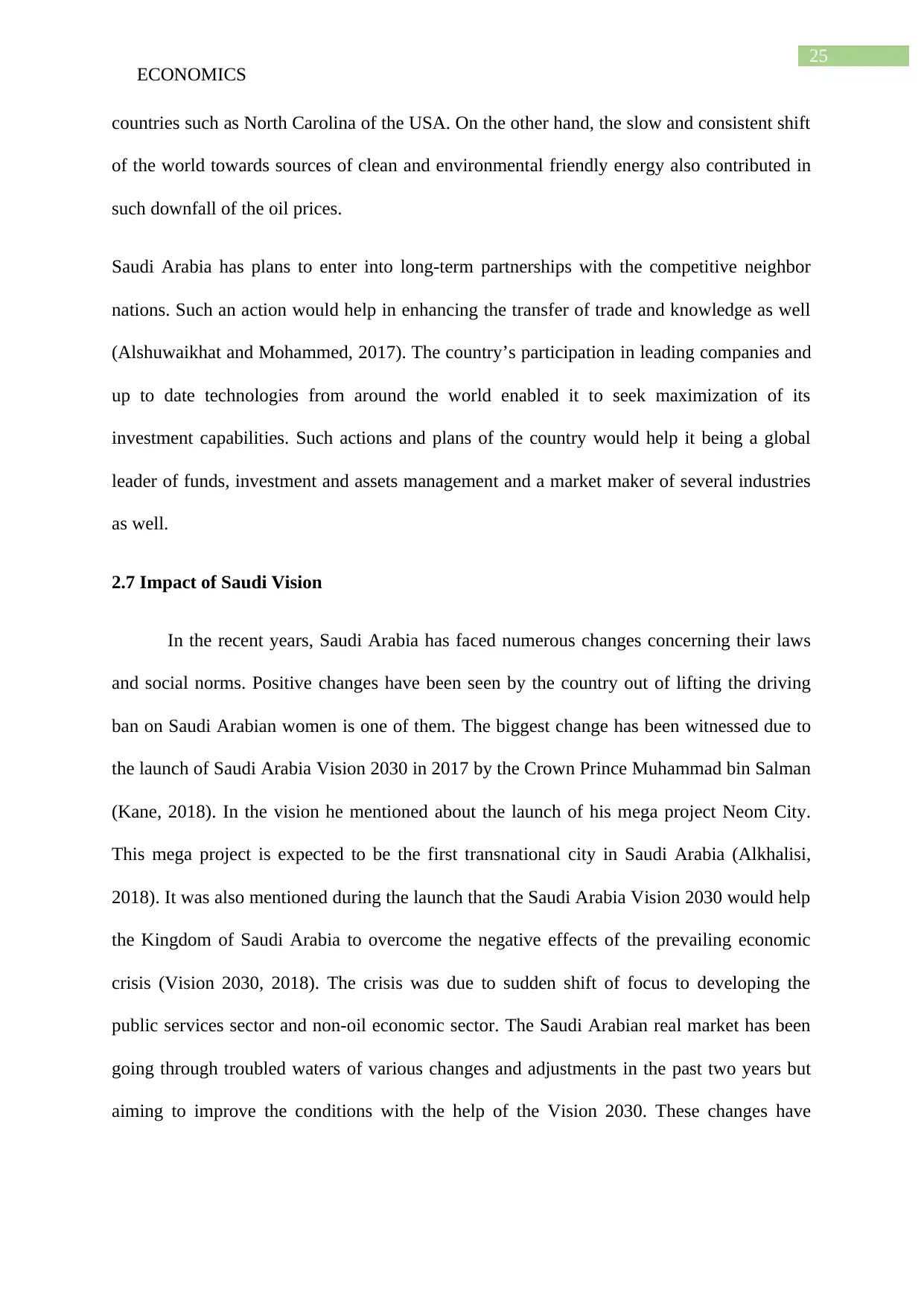
25
ECONOMICS
countries such as North Carolina of the USA. On the other hand, the slow and consistent shift
of the world towards sources of clean and environmental friendly energy also contributed in
such downfall of the oil prices.
Saudi Arabia has plans to enter into long-term partnerships with the competitive neighbor
nations. Such an action would help in enhancing the transfer of trade and knowledge as well
(Alshuwaikhat and Mohammed, 2017). The country’s participation in leading companies and
up to date technologies from around the world enabled it to seek maximization of its
investment capabilities. Such actions and plans of the country would help it being a global
leader of funds, investment and assets management and a market maker of several industries
as well.
2.7 Impact of Saudi Vision
In the recent years, Saudi Arabia has faced numerous changes concerning their laws
and social norms. Positive changes have been seen by the country out of lifting the driving
ban on Saudi Arabian women is one of them. The biggest change has been witnessed due to
the launch of Saudi Arabia Vision 2030 in 2017 by the Crown Prince Muhammad bin Salman
(Kane, 2018). In the vision he mentioned about the launch of his mega project Neom City.
This mega project is expected to be the first transnational city in Saudi Arabia (Alkhalisi,
2018). It was also mentioned during the launch that the Saudi Arabia Vision 2030 would help
the Kingdom of Saudi Arabia to overcome the negative effects of the prevailing economic
crisis (Vision 2030, 2018). The crisis was due to sudden shift of focus to developing the
public services sector and non-oil economic sector. The Saudi Arabian real market has been
going through troubled waters of various changes and adjustments in the past two years but
aiming to improve the conditions with the help of the Vision 2030. These changes have
ECONOMICS
countries such as North Carolina of the USA. On the other hand, the slow and consistent shift
of the world towards sources of clean and environmental friendly energy also contributed in
such downfall of the oil prices.
Saudi Arabia has plans to enter into long-term partnerships with the competitive neighbor
nations. Such an action would help in enhancing the transfer of trade and knowledge as well
(Alshuwaikhat and Mohammed, 2017). The country’s participation in leading companies and
up to date technologies from around the world enabled it to seek maximization of its
investment capabilities. Such actions and plans of the country would help it being a global
leader of funds, investment and assets management and a market maker of several industries
as well.
2.7 Impact of Saudi Vision
In the recent years, Saudi Arabia has faced numerous changes concerning their laws
and social norms. Positive changes have been seen by the country out of lifting the driving
ban on Saudi Arabian women is one of them. The biggest change has been witnessed due to
the launch of Saudi Arabia Vision 2030 in 2017 by the Crown Prince Muhammad bin Salman
(Kane, 2018). In the vision he mentioned about the launch of his mega project Neom City.
This mega project is expected to be the first transnational city in Saudi Arabia (Alkhalisi,
2018). It was also mentioned during the launch that the Saudi Arabia Vision 2030 would help
the Kingdom of Saudi Arabia to overcome the negative effects of the prevailing economic
crisis (Vision 2030, 2018). The crisis was due to sudden shift of focus to developing the
public services sector and non-oil economic sector. The Saudi Arabian real market has been
going through troubled waters of various changes and adjustments in the past two years but
aiming to improve the conditions with the help of the Vision 2030. These changes have
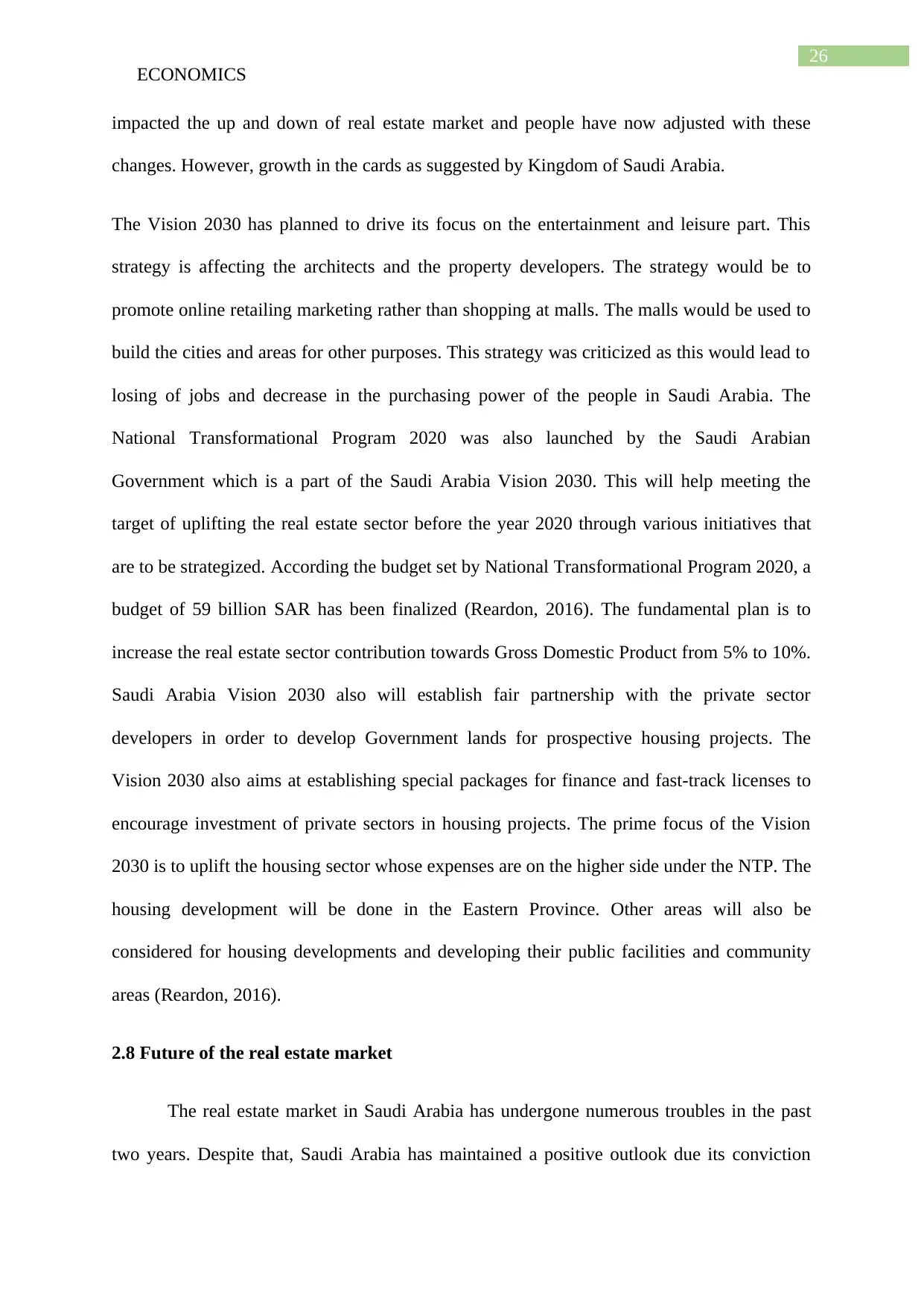
26
ECONOMICS
impacted the up and down of real estate market and people have now adjusted with these
changes. However, growth in the cards as suggested by Kingdom of Saudi Arabia.
The Vision 2030 has planned to drive its focus on the entertainment and leisure part. This
strategy is affecting the architects and the property developers. The strategy would be to
promote online retailing marketing rather than shopping at malls. The malls would be used to
build the cities and areas for other purposes. This strategy was criticized as this would lead to
losing of jobs and decrease in the purchasing power of the people in Saudi Arabia. The
National Transformational Program 2020 was also launched by the Saudi Arabian
Government which is a part of the Saudi Arabia Vision 2030. This will help meeting the
target of uplifting the real estate sector before the year 2020 through various initiatives that
are to be strategized. According the budget set by National Transformational Program 2020, a
budget of 59 billion SAR has been finalized (Reardon, 2016). The fundamental plan is to
increase the real estate sector contribution towards Gross Domestic Product from 5% to 10%.
Saudi Arabia Vision 2030 also will establish fair partnership with the private sector
developers in order to develop Government lands for prospective housing projects. The
Vision 2030 also aims at establishing special packages for finance and fast-track licenses to
encourage investment of private sectors in housing projects. The prime focus of the Vision
2030 is to uplift the housing sector whose expenses are on the higher side under the NTP. The
housing development will be done in the Eastern Province. Other areas will also be
considered for housing developments and developing their public facilities and community
areas (Reardon, 2016).
2.8 Future of the real estate market
The real estate market in Saudi Arabia has undergone numerous troubles in the past
two years. Despite that, Saudi Arabia has maintained a positive outlook due its conviction
ECONOMICS
impacted the up and down of real estate market and people have now adjusted with these
changes. However, growth in the cards as suggested by Kingdom of Saudi Arabia.
The Vision 2030 has planned to drive its focus on the entertainment and leisure part. This
strategy is affecting the architects and the property developers. The strategy would be to
promote online retailing marketing rather than shopping at malls. The malls would be used to
build the cities and areas for other purposes. This strategy was criticized as this would lead to
losing of jobs and decrease in the purchasing power of the people in Saudi Arabia. The
National Transformational Program 2020 was also launched by the Saudi Arabian
Government which is a part of the Saudi Arabia Vision 2030. This will help meeting the
target of uplifting the real estate sector before the year 2020 through various initiatives that
are to be strategized. According the budget set by National Transformational Program 2020, a
budget of 59 billion SAR has been finalized (Reardon, 2016). The fundamental plan is to
increase the real estate sector contribution towards Gross Domestic Product from 5% to 10%.
Saudi Arabia Vision 2030 also will establish fair partnership with the private sector
developers in order to develop Government lands for prospective housing projects. The
Vision 2030 also aims at establishing special packages for finance and fast-track licenses to
encourage investment of private sectors in housing projects. The prime focus of the Vision
2030 is to uplift the housing sector whose expenses are on the higher side under the NTP. The
housing development will be done in the Eastern Province. Other areas will also be
considered for housing developments and developing their public facilities and community
areas (Reardon, 2016).
2.8 Future of the real estate market
The real estate market in Saudi Arabia has undergone numerous troubles in the past
two years. Despite that, Saudi Arabia has maintained a positive outlook due its conviction
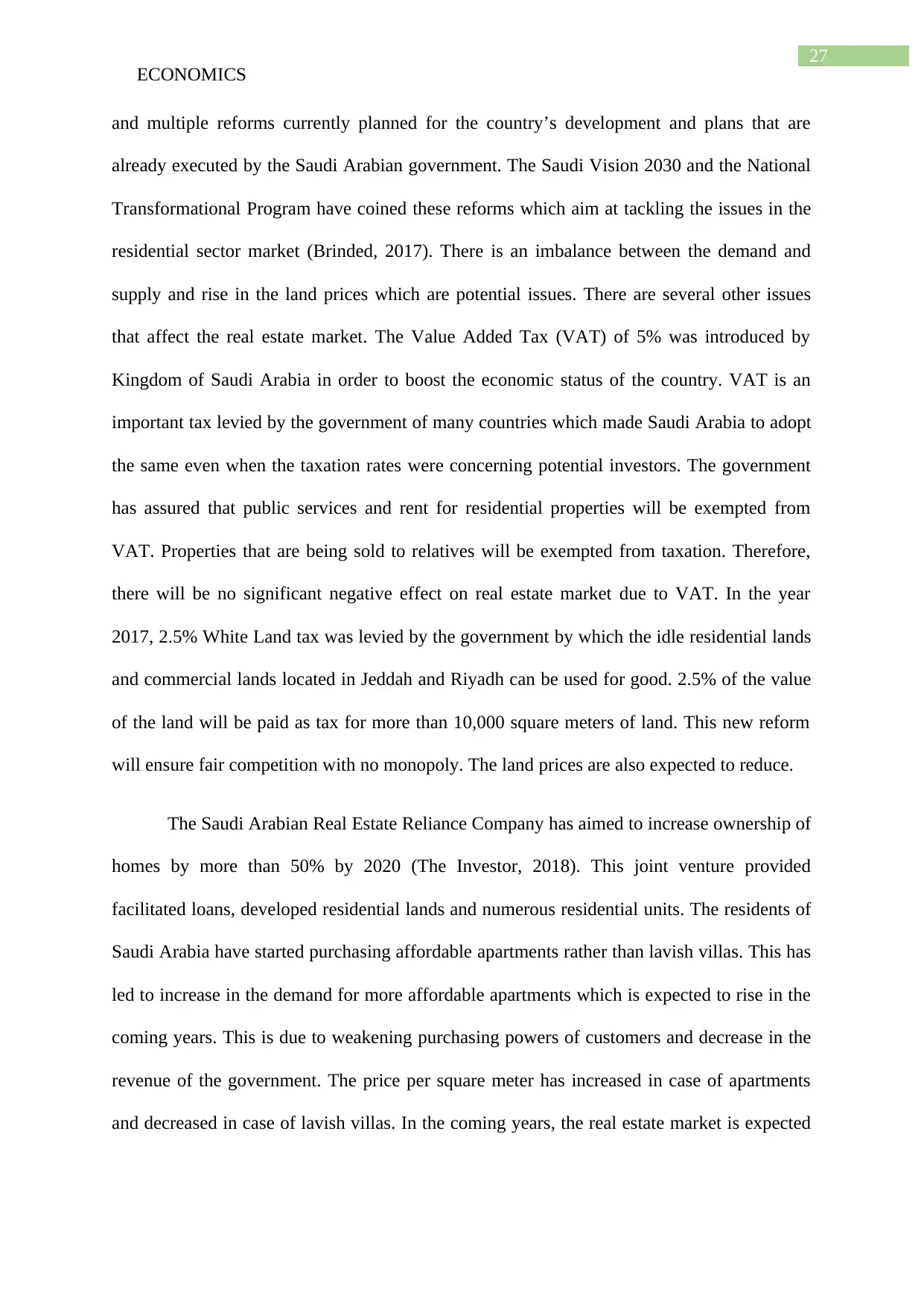
27
ECONOMICS
and multiple reforms currently planned for the country’s development and plans that are
already executed by the Saudi Arabian government. The Saudi Vision 2030 and the National
Transformational Program have coined these reforms which aim at tackling the issues in the
residential sector market (Brinded, 2017). There is an imbalance between the demand and
supply and rise in the land prices which are potential issues. There are several other issues
that affect the real estate market. The Value Added Tax (VAT) of 5% was introduced by
Kingdom of Saudi Arabia in order to boost the economic status of the country. VAT is an
important tax levied by the government of many countries which made Saudi Arabia to adopt
the same even when the taxation rates were concerning potential investors. The government
has assured that public services and rent for residential properties will be exempted from
VAT. Properties that are being sold to relatives will be exempted from taxation. Therefore,
there will be no significant negative effect on real estate market due to VAT. In the year
2017, 2.5% White Land tax was levied by the government by which the idle residential lands
and commercial lands located in Jeddah and Riyadh can be used for good. 2.5% of the value
of the land will be paid as tax for more than 10,000 square meters of land. This new reform
will ensure fair competition with no monopoly. The land prices are also expected to reduce.
The Saudi Arabian Real Estate Reliance Company has aimed to increase ownership of
homes by more than 50% by 2020 (The Investor, 2018). This joint venture provided
facilitated loans, developed residential lands and numerous residential units. The residents of
Saudi Arabia have started purchasing affordable apartments rather than lavish villas. This has
led to increase in the demand for more affordable apartments which is expected to rise in the
coming years. This is due to weakening purchasing powers of customers and decrease in the
revenue of the government. The price per square meter has increased in case of apartments
and decreased in case of lavish villas. In the coming years, the real estate market is expected
ECONOMICS
and multiple reforms currently planned for the country’s development and plans that are
already executed by the Saudi Arabian government. The Saudi Vision 2030 and the National
Transformational Program have coined these reforms which aim at tackling the issues in the
residential sector market (Brinded, 2017). There is an imbalance between the demand and
supply and rise in the land prices which are potential issues. There are several other issues
that affect the real estate market. The Value Added Tax (VAT) of 5% was introduced by
Kingdom of Saudi Arabia in order to boost the economic status of the country. VAT is an
important tax levied by the government of many countries which made Saudi Arabia to adopt
the same even when the taxation rates were concerning potential investors. The government
has assured that public services and rent for residential properties will be exempted from
VAT. Properties that are being sold to relatives will be exempted from taxation. Therefore,
there will be no significant negative effect on real estate market due to VAT. In the year
2017, 2.5% White Land tax was levied by the government by which the idle residential lands
and commercial lands located in Jeddah and Riyadh can be used for good. 2.5% of the value
of the land will be paid as tax for more than 10,000 square meters of land. This new reform
will ensure fair competition with no monopoly. The land prices are also expected to reduce.
The Saudi Arabian Real Estate Reliance Company has aimed to increase ownership of
homes by more than 50% by 2020 (The Investor, 2018). This joint venture provided
facilitated loans, developed residential lands and numerous residential units. The residents of
Saudi Arabia have started purchasing affordable apartments rather than lavish villas. This has
led to increase in the demand for more affordable apartments which is expected to rise in the
coming years. This is due to weakening purchasing powers of customers and decrease in the
revenue of the government. The price per square meter has increased in case of apartments
and decreased in case of lavish villas. In the coming years, the real estate market is expected
Secure Best Marks with AI Grader
Need help grading? Try our AI Grader for instant feedback on your assignments.
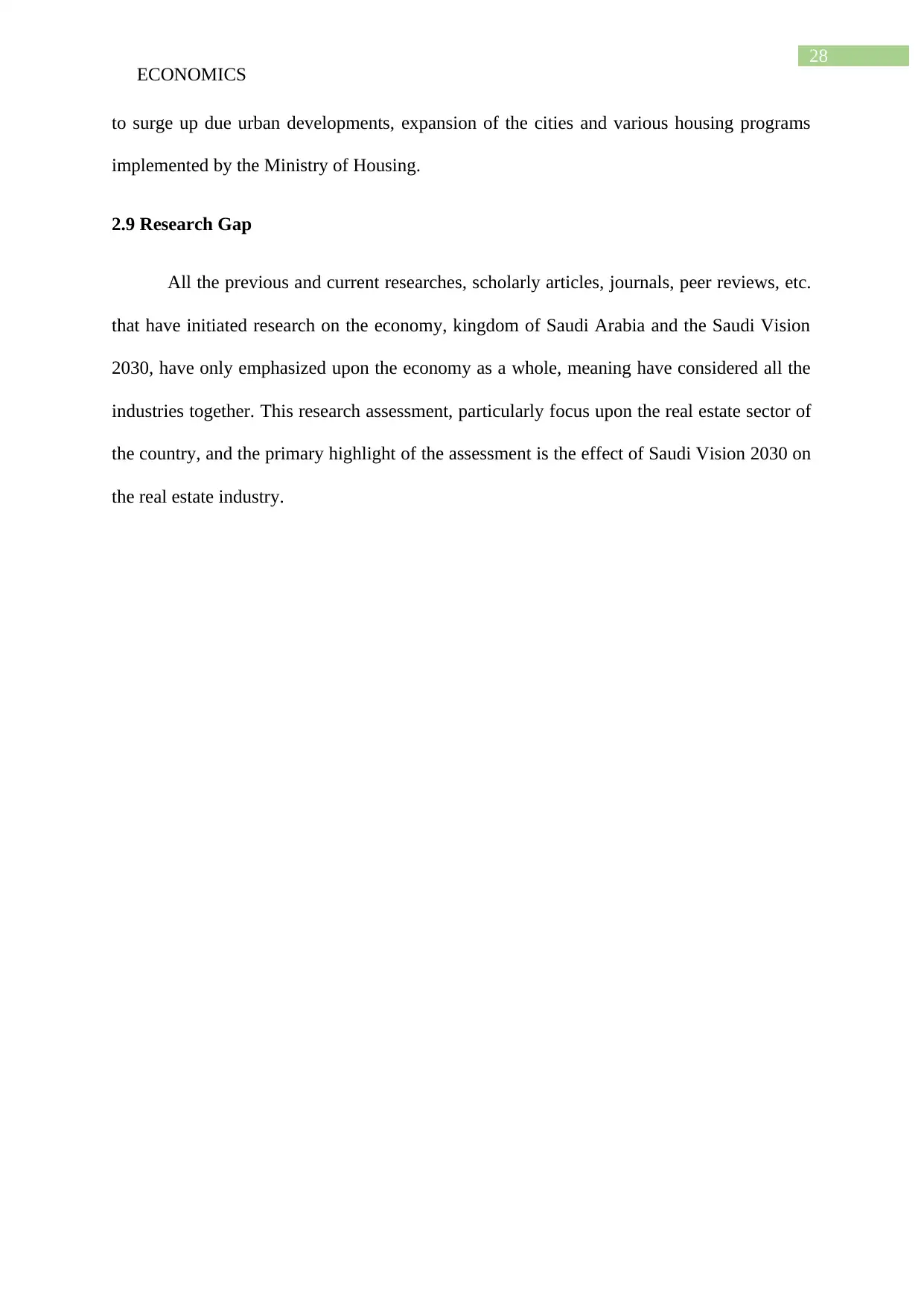
28
ECONOMICS
to surge up due urban developments, expansion of the cities and various housing programs
implemented by the Ministry of Housing.
2.9 Research Gap
All the previous and current researches, scholarly articles, journals, peer reviews, etc.
that have initiated research on the economy, kingdom of Saudi Arabia and the Saudi Vision
2030, have only emphasized upon the economy as a whole, meaning have considered all the
industries together. This research assessment, particularly focus upon the real estate sector of
the country, and the primary highlight of the assessment is the effect of Saudi Vision 2030 on
the real estate industry.
ECONOMICS
to surge up due urban developments, expansion of the cities and various housing programs
implemented by the Ministry of Housing.
2.9 Research Gap
All the previous and current researches, scholarly articles, journals, peer reviews, etc.
that have initiated research on the economy, kingdom of Saudi Arabia and the Saudi Vision
2030, have only emphasized upon the economy as a whole, meaning have considered all the
industries together. This research assessment, particularly focus upon the real estate sector of
the country, and the primary highlight of the assessment is the effect of Saudi Vision 2030 on
the real estate industry.
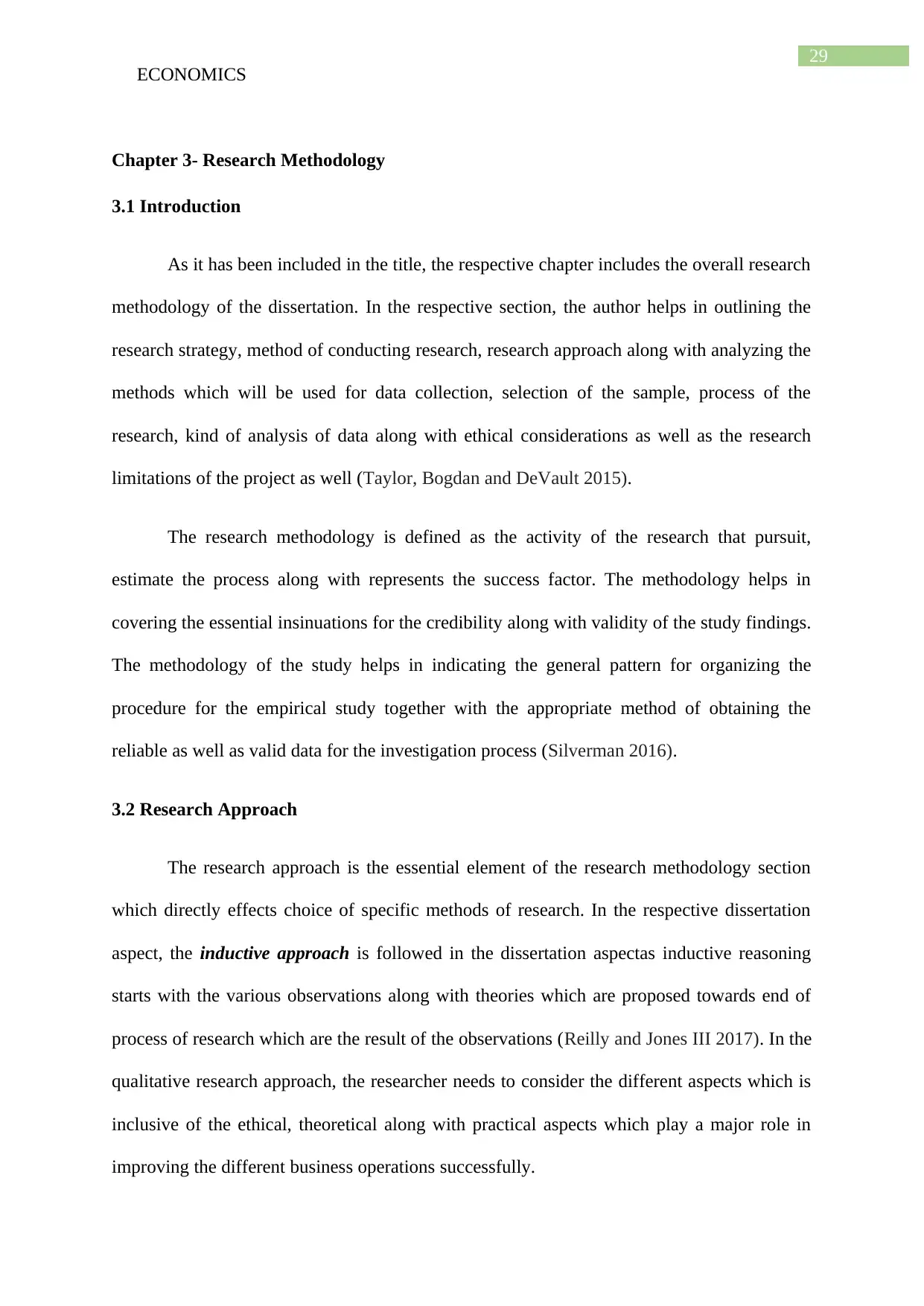
29
ECONOMICS
Chapter 3- Research Methodology
3.1 Introduction
As it has been included in the title, the respective chapter includes the overall research
methodology of the dissertation. In the respective section, the author helps in outlining the
research strategy, method of conducting research, research approach along with analyzing the
methods which will be used for data collection, selection of the sample, process of the
research, kind of analysis of data along with ethical considerations as well as the research
limitations of the project as well (Taylor, Bogdan and DeVault 2015).
The research methodology is defined as the activity of the research that pursuit,
estimate the process along with represents the success factor. The methodology helps in
covering the essential insinuations for the credibility along with validity of the study findings.
The methodology of the study helps in indicating the general pattern for organizing the
procedure for the empirical study together with the appropriate method of obtaining the
reliable as well as valid data for the investigation process (Silverman 2016).
3.2 Research Approach
The research approach is the essential element of the research methodology section
which directly effects choice of specific methods of research. In the respective dissertation
aspect, the inductive approach is followed in the dissertation aspectas inductive reasoning
starts with the various observations along with theories which are proposed towards end of
process of research which are the result of the observations (Reilly and Jones III 2017). In the
qualitative research approach, the researcher needs to consider the different aspects which is
inclusive of the ethical, theoretical along with practical aspects which play a major role in
improving the different business operations successfully.
ECONOMICS
Chapter 3- Research Methodology
3.1 Introduction
As it has been included in the title, the respective chapter includes the overall research
methodology of the dissertation. In the respective section, the author helps in outlining the
research strategy, method of conducting research, research approach along with analyzing the
methods which will be used for data collection, selection of the sample, process of the
research, kind of analysis of data along with ethical considerations as well as the research
limitations of the project as well (Taylor, Bogdan and DeVault 2015).
The research methodology is defined as the activity of the research that pursuit,
estimate the process along with represents the success factor. The methodology helps in
covering the essential insinuations for the credibility along with validity of the study findings.
The methodology of the study helps in indicating the general pattern for organizing the
procedure for the empirical study together with the appropriate method of obtaining the
reliable as well as valid data for the investigation process (Silverman 2016).
3.2 Research Approach
The research approach is the essential element of the research methodology section
which directly effects choice of specific methods of research. In the respective dissertation
aspect, the inductive approach is followed in the dissertation aspectas inductive reasoning
starts with the various observations along with theories which are proposed towards end of
process of research which are the result of the observations (Reilly and Jones III 2017). In the
qualitative research approach, the researcher needs to consider the different aspects which is
inclusive of the ethical, theoretical along with practical aspects which play a major role in
improving the different business operations successfully.
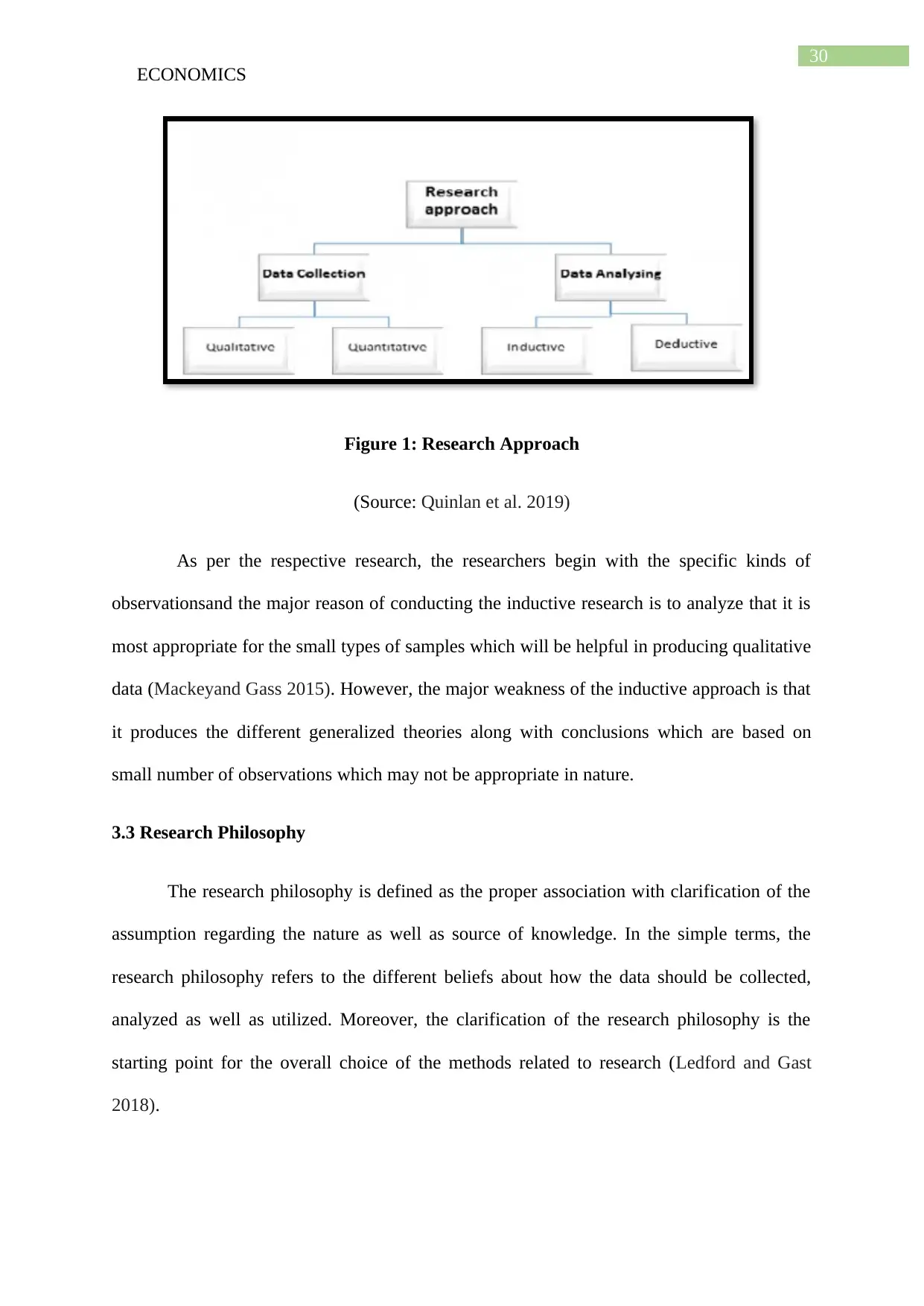
30
ECONOMICS
Figure 1: Research Approach
(Source: Quinlan et al. 2019)
As per the respective research, the researchers begin with the specific kinds of
observationsand the major reason of conducting the inductive research is to analyze that it is
most appropriate for the small types of samples which will be helpful in producing qualitative
data (Mackeyand Gass 2015). However, the major weakness of the inductive approach is that
it produces the different generalized theories along with conclusions which are based on
small number of observations which may not be appropriate in nature.
3.3 Research Philosophy
The research philosophy is defined as the proper association with clarification of the
assumption regarding the nature as well as source of knowledge. In the simple terms, the
research philosophy refers to the different beliefs about how the data should be collected,
analyzed as well as utilized. Moreover, the clarification of the research philosophy is the
starting point for the overall choice of the methods related to research (Ledford and Gast
2018).
ECONOMICS
Figure 1: Research Approach
(Source: Quinlan et al. 2019)
As per the respective research, the researchers begin with the specific kinds of
observationsand the major reason of conducting the inductive research is to analyze that it is
most appropriate for the small types of samples which will be helpful in producing qualitative
data (Mackeyand Gass 2015). However, the major weakness of the inductive approach is that
it produces the different generalized theories along with conclusions which are based on
small number of observations which may not be appropriate in nature.
3.3 Research Philosophy
The research philosophy is defined as the proper association with clarification of the
assumption regarding the nature as well as source of knowledge. In the simple terms, the
research philosophy refers to the different beliefs about how the data should be collected,
analyzed as well as utilized. Moreover, the clarification of the research philosophy is the
starting point for the overall choice of the methods related to research (Ledford and Gast
2018).
Paraphrase This Document
Need a fresh take? Get an instant paraphrase of this document with our AI Paraphraser
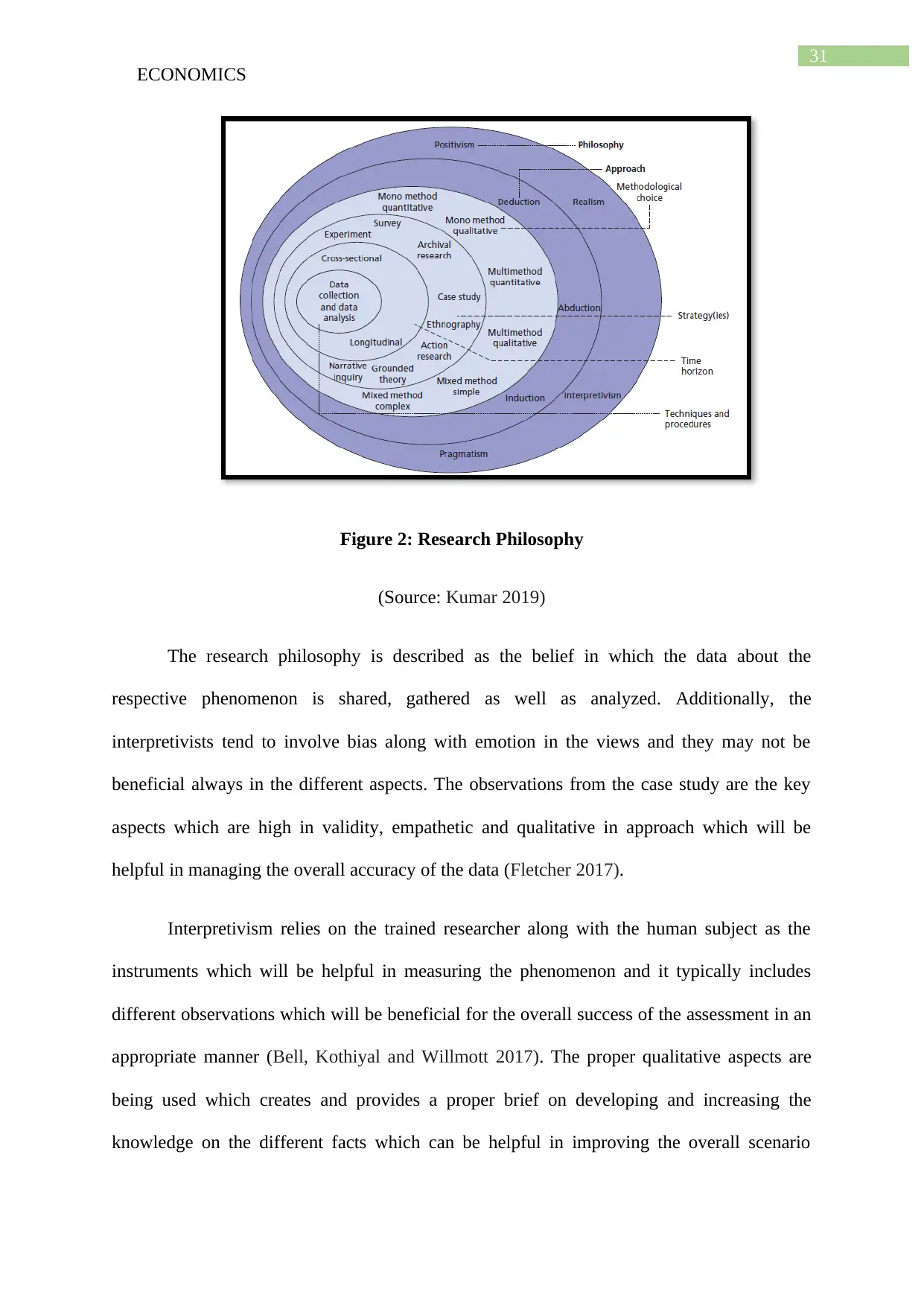
31
ECONOMICS
Figure 2: Research Philosophy
(Source: Kumar 2019)
The research philosophy is described as the belief in which the data about the
respective phenomenon is shared, gathered as well as analyzed. Additionally, the
interpretivists tend to involve bias along with emotion in the views and they may not be
beneficial always in the different aspects. The observations from the case study are the key
aspects which are high in validity, empathetic and qualitative in approach which will be
helpful in managing the overall accuracy of the data (Fletcher 2017).
Interpretivism relies on the trained researcher along with the human subject as the
instruments which will be helpful in measuring the phenomenon and it typically includes
different observations which will be beneficial for the overall success of the assessment in an
appropriate manner (Bell, Kothiyal and Willmott 2017). The proper qualitative aspects are
being used which creates and provides a proper brief on developing and increasing the
knowledge on the different facts which can be helpful in improving the overall scenario
ECONOMICS
Figure 2: Research Philosophy
(Source: Kumar 2019)
The research philosophy is described as the belief in which the data about the
respective phenomenon is shared, gathered as well as analyzed. Additionally, the
interpretivists tend to involve bias along with emotion in the views and they may not be
beneficial always in the different aspects. The observations from the case study are the key
aspects which are high in validity, empathetic and qualitative in approach which will be
helpful in managing the overall accuracy of the data (Fletcher 2017).
Interpretivism relies on the trained researcher along with the human subject as the
instruments which will be helpful in measuring the phenomenon and it typically includes
different observations which will be beneficial for the overall success of the assessment in an
appropriate manner (Bell, Kothiyal and Willmott 2017). The proper qualitative aspects are
being used which creates and provides a proper brief on developing and increasing the
knowledge on the different facts which can be helpful in improving the overall scenario
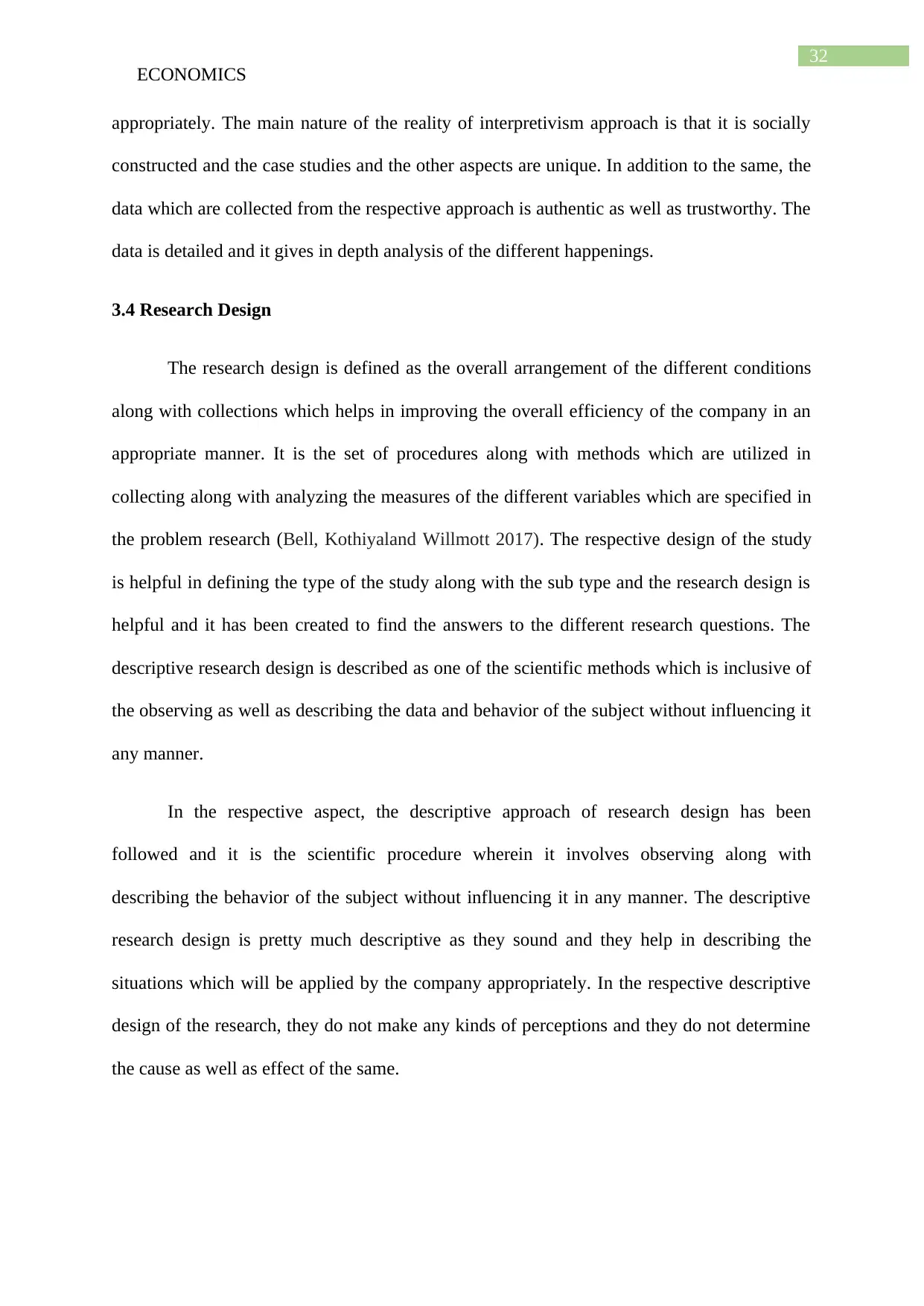
32
ECONOMICS
appropriately. The main nature of the reality of interpretivism approach is that it is socially
constructed and the case studies and the other aspects are unique. In addition to the same, the
data which are collected from the respective approach is authentic as well as trustworthy. The
data is detailed and it gives in depth analysis of the different happenings.
3.4 Research Design
The research design is defined as the overall arrangement of the different conditions
along with collections which helps in improving the overall efficiency of the company in an
appropriate manner. It is the set of procedures along with methods which are utilized in
collecting along with analyzing the measures of the different variables which are specified in
the problem research (Bell, Kothiyaland Willmott 2017). The respective design of the study
is helpful in defining the type of the study along with the sub type and the research design is
helpful and it has been created to find the answers to the different research questions. The
descriptive research design is described as one of the scientific methods which is inclusive of
the observing as well as describing the data and behavior of the subject without influencing it
any manner.
In the respective aspect, the descriptive approach of research design has been
followed and it is the scientific procedure wherein it involves observing along with
describing the behavior of the subject without influencing it in any manner. The descriptive
research design is pretty much descriptive as they sound and they help in describing the
situations which will be applied by the company appropriately. In the respective descriptive
design of the research, they do not make any kinds of perceptions and they do not determine
the cause as well as effect of the same.
ECONOMICS
appropriately. The main nature of the reality of interpretivism approach is that it is socially
constructed and the case studies and the other aspects are unique. In addition to the same, the
data which are collected from the respective approach is authentic as well as trustworthy. The
data is detailed and it gives in depth analysis of the different happenings.
3.4 Research Design
The research design is defined as the overall arrangement of the different conditions
along with collections which helps in improving the overall efficiency of the company in an
appropriate manner. It is the set of procedures along with methods which are utilized in
collecting along with analyzing the measures of the different variables which are specified in
the problem research (Bell, Kothiyaland Willmott 2017). The respective design of the study
is helpful in defining the type of the study along with the sub type and the research design is
helpful and it has been created to find the answers to the different research questions. The
descriptive research design is described as one of the scientific methods which is inclusive of
the observing as well as describing the data and behavior of the subject without influencing it
any manner.
In the respective aspect, the descriptive approach of research design has been
followed and it is the scientific procedure wherein it involves observing along with
describing the behavior of the subject without influencing it in any manner. The descriptive
research design is pretty much descriptive as they sound and they help in describing the
situations which will be applied by the company appropriately. In the respective descriptive
design of the research, they do not make any kinds of perceptions and they do not determine
the cause as well as effect of the same.
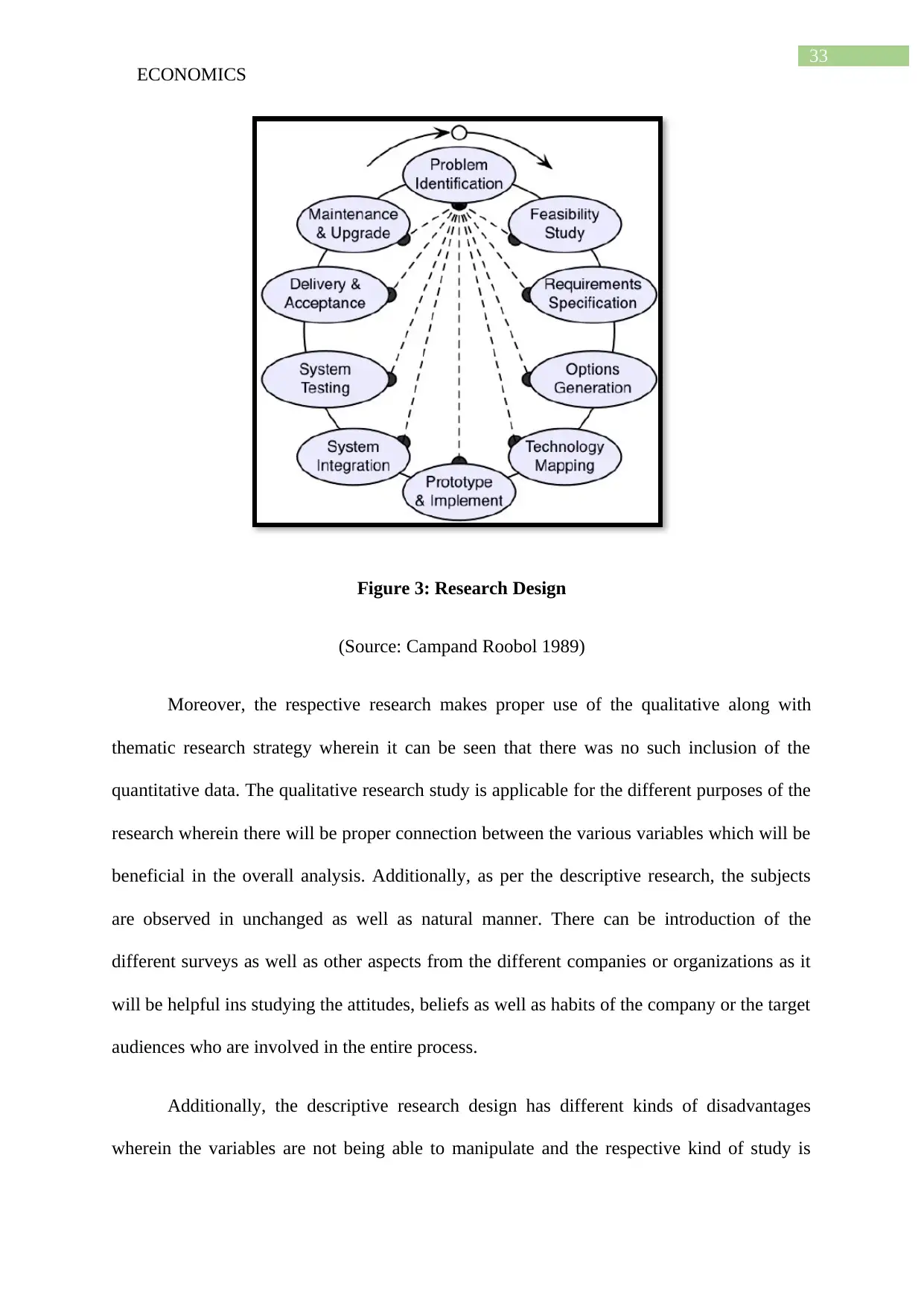
33
ECONOMICS
Figure 3: Research Design
(Source: Campand Roobol 1989)
Moreover, the respective research makes proper use of the qualitative along with
thematic research strategy wherein it can be seen that there was no such inclusion of the
quantitative data. The qualitative research study is applicable for the different purposes of the
research wherein there will be proper connection between the various variables which will be
beneficial in the overall analysis. Additionally, as per the descriptive research, the subjects
are observed in unchanged as well as natural manner. There can be introduction of the
different surveys as well as other aspects from the different companies or organizations as it
will be helpful ins studying the attitudes, beliefs as well as habits of the company or the target
audiences who are involved in the entire process.
Additionally, the descriptive research design has different kinds of disadvantages
wherein the variables are not being able to manipulate and the respective kind of study is
ECONOMICS
Figure 3: Research Design
(Source: Campand Roobol 1989)
Moreover, the respective research makes proper use of the qualitative along with
thematic research strategy wherein it can be seen that there was no such inclusion of the
quantitative data. The qualitative research study is applicable for the different purposes of the
research wherein there will be proper connection between the various variables which will be
beneficial in the overall analysis. Additionally, as per the descriptive research, the subjects
are observed in unchanged as well as natural manner. There can be introduction of the
different surveys as well as other aspects from the different companies or organizations as it
will be helpful ins studying the attitudes, beliefs as well as habits of the company or the target
audiences who are involved in the entire process.
Additionally, the descriptive research design has different kinds of disadvantages
wherein the variables are not being able to manipulate and the respective kind of study is
Secure Best Marks with AI Grader
Need help grading? Try our AI Grader for instant feedback on your assignments.

34
ECONOMICS
unscientific as well as unreliable. From the overall analysis, it can be identified that
descriptive research design is considered to be one of the most valid methods for the
researching of the specific subjects and it will be available for the more qualitative data
analysis of the study which is being conducted.
3.5 Method of Data Collection
There are mainly two kinds of data which is inclusive of primary as well as secondary
data types. The primary data is the type of data which never existed before and therefore it
has not been published previously as well. The primary data is collected for a specific
purpose which is basically to find the different answers for the research questions through the
utilisation of the different tools such as SPSS and the excel data analytics as well. On the
other hand, the secondary data analysis is referred to the data which are already published in
different journals, newspaper, magazines along with online portals or other sources such as
usage of the case studies.
Moreover, the qualitative data analysis will be helpful in understanding the market
research method which mainly focuses on obtaining the different data with the help of the
open ended along with conversational communication. In the case study approach, the main
focus will be on the organization, entity and the entire research is conducted through
interviews, documents along with observations which will be helpful in gaining appropriate
data and it will play a major role in gaining data in an appropriate method.
In addition to the same, the qualitative data research is not used in the early stages of
the process of collecting data, which in case of the quantitative data collection the approach is
followed. Proper identification of the research problem is essential to be analysed that will be
preparing the research questions and gain more knowledge on the situation to frame such
questions appropriately which will be leading to successful development of the research plan.
ECONOMICS
unscientific as well as unreliable. From the overall analysis, it can be identified that
descriptive research design is considered to be one of the most valid methods for the
researching of the specific subjects and it will be available for the more qualitative data
analysis of the study which is being conducted.
3.5 Method of Data Collection
There are mainly two kinds of data which is inclusive of primary as well as secondary
data types. The primary data is the type of data which never existed before and therefore it
has not been published previously as well. The primary data is collected for a specific
purpose which is basically to find the different answers for the research questions through the
utilisation of the different tools such as SPSS and the excel data analytics as well. On the
other hand, the secondary data analysis is referred to the data which are already published in
different journals, newspaper, magazines along with online portals or other sources such as
usage of the case studies.
Moreover, the qualitative data analysis will be helpful in understanding the market
research method which mainly focuses on obtaining the different data with the help of the
open ended along with conversational communication. In the case study approach, the main
focus will be on the organization, entity and the entire research is conducted through
interviews, documents along with observations which will be helpful in gaining appropriate
data and it will play a major role in gaining data in an appropriate method.
In addition to the same, the qualitative data research is not used in the early stages of
the process of collecting data, which in case of the quantitative data collection the approach is
followed. Proper identification of the research problem is essential to be analysed that will be
preparing the research questions and gain more knowledge on the situation to frame such
questions appropriately which will be leading to successful development of the research plan.
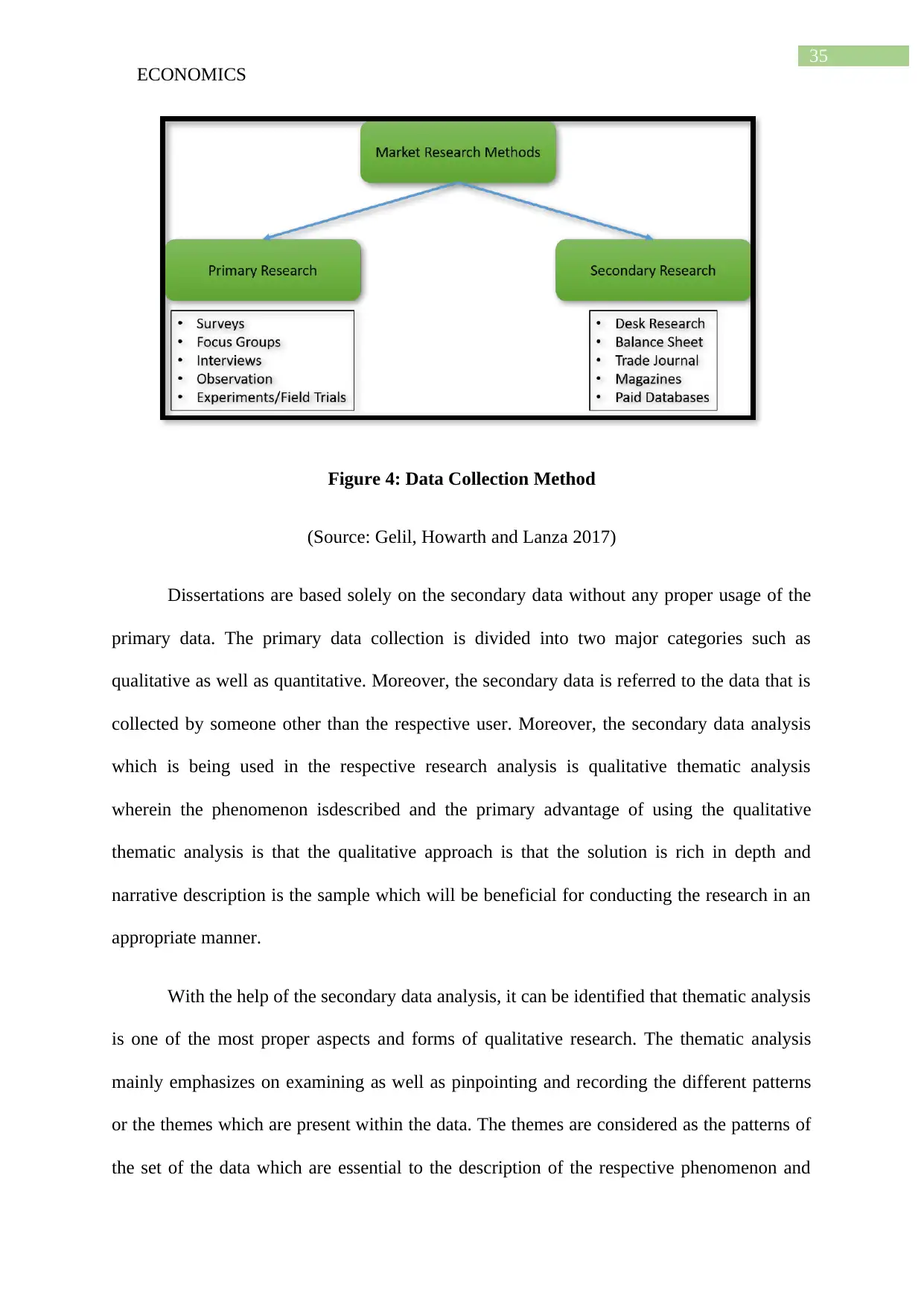
35
ECONOMICS
Figure 4: Data Collection Method
(Source: Gelil, Howarth and Lanza 2017)
Dissertations are based solely on the secondary data without any proper usage of the
primary data. The primary data collection is divided into two major categories such as
qualitative as well as quantitative. Moreover, the secondary data is referred to the data that is
collected by someone other than the respective user. Moreover, the secondary data analysis
which is being used in the respective research analysis is qualitative thematic analysis
wherein the phenomenon isdescribed and the primary advantage of using the qualitative
thematic analysis is that the qualitative approach is that the solution is rich in depth and
narrative description is the sample which will be beneficial for conducting the research in an
appropriate manner.
With the help of the secondary data analysis, it can be identified that thematic analysis
is one of the most proper aspects and forms of qualitative research. The thematic analysis
mainly emphasizes on examining as well as pinpointing and recording the different patterns
or the themes which are present within the data. The themes are considered as the patterns of
the set of the data which are essential to the description of the respective phenomenon and
ECONOMICS
Figure 4: Data Collection Method
(Source: Gelil, Howarth and Lanza 2017)
Dissertations are based solely on the secondary data without any proper usage of the
primary data. The primary data collection is divided into two major categories such as
qualitative as well as quantitative. Moreover, the secondary data is referred to the data that is
collected by someone other than the respective user. Moreover, the secondary data analysis
which is being used in the respective research analysis is qualitative thematic analysis
wherein the phenomenon isdescribed and the primary advantage of using the qualitative
thematic analysis is that the qualitative approach is that the solution is rich in depth and
narrative description is the sample which will be beneficial for conducting the research in an
appropriate manner.
With the help of the secondary data analysis, it can be identified that thematic analysis
is one of the most proper aspects and forms of qualitative research. The thematic analysis
mainly emphasizes on examining as well as pinpointing and recording the different patterns
or the themes which are present within the data. The themes are considered as the patterns of
the set of the data which are essential to the description of the respective phenomenon and
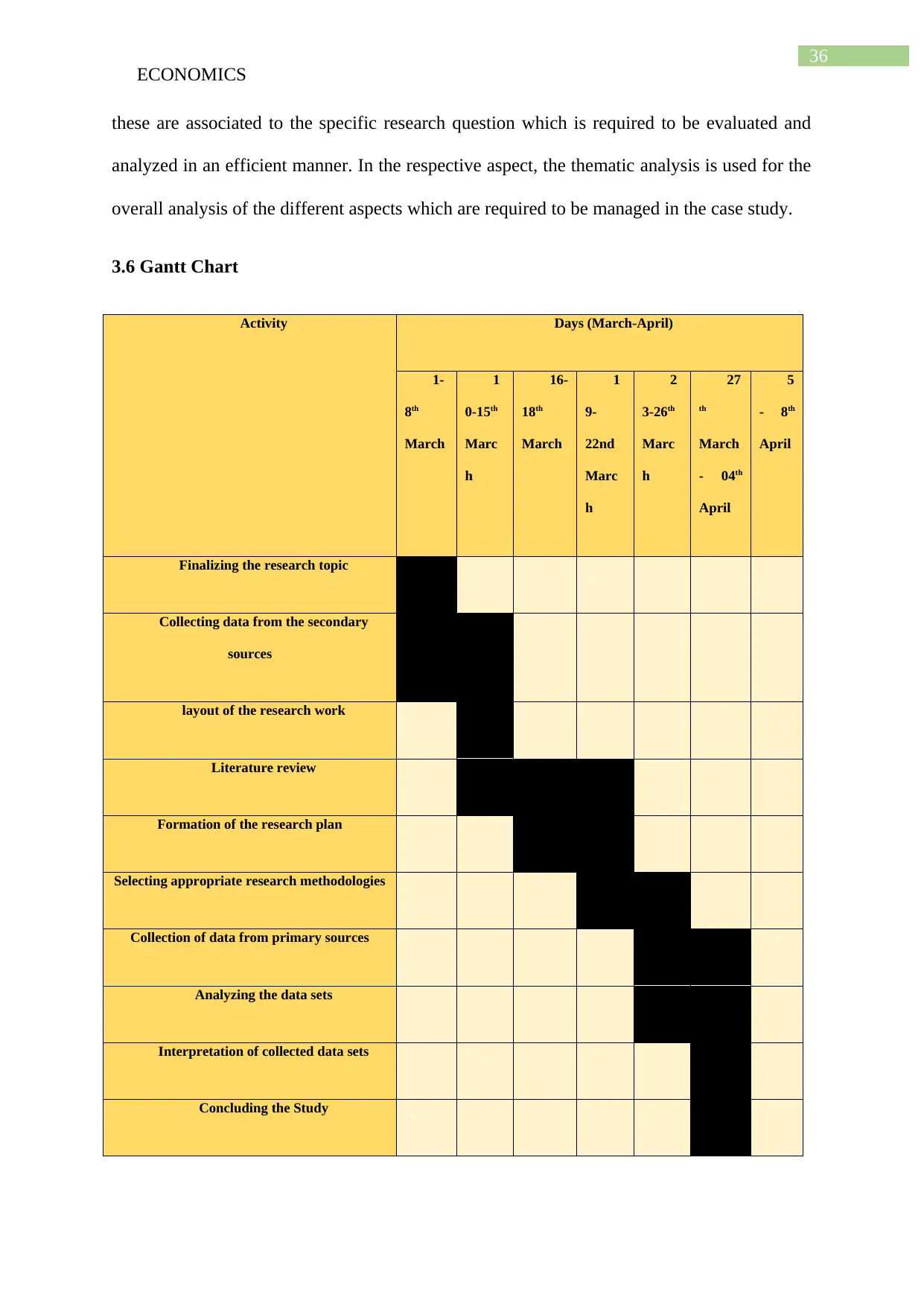
36
ECONOMICS
these are associated to the specific research question which is required to be evaluated and
analyzed in an efficient manner. In the respective aspect, the thematic analysis is used for the
overall analysis of the different aspects which are required to be managed in the case study.
3.6 Gantt Chart
Activity Days (March-April)
1-
8th
March
1
0-15th
Marc
h
16-
18th
March
1
9-
22nd
Marc
h
2
3-26th
Marc
h
27
th
March
- 04th
April
5
- 8th
April
Finalizing the research topic
Collecting data from the secondary
sources
layout of the research work
Literature review
Formation of the research plan
Selecting appropriate research methodologies
Collection of data from primary sources
Analyzing the data sets
Interpretation of collected data sets
Concluding the Study
ECONOMICS
these are associated to the specific research question which is required to be evaluated and
analyzed in an efficient manner. In the respective aspect, the thematic analysis is used for the
overall analysis of the different aspects which are required to be managed in the case study.
3.6 Gantt Chart
Activity Days (March-April)
1-
8th
March
1
0-15th
Marc
h
16-
18th
March
1
9-
22nd
Marc
h
2
3-26th
Marc
h
27
th
March
- 04th
April
5
- 8th
April
Finalizing the research topic
Collecting data from the secondary
sources
layout of the research work
Literature review
Formation of the research plan
Selecting appropriate research methodologies
Collection of data from primary sources
Analyzing the data sets
Interpretation of collected data sets
Concluding the Study
Paraphrase This Document
Need a fresh take? Get an instant paraphrase of this document with our AI Paraphraser

37
ECONOMICS
Designing of rough draft
Submitting the Final Work
3.7 Ethical Considerations
There are different rules along with regulations which have been analyzed while
undertaking the study. In a fundamental manner, the most appropriate component is to
maintain proper privacy of the data along with the different specific information which are
presented in the study (Gelil, Howarth and Lanza 2017). Moreover, the particular information
which is private in nature is generated through proper means of research along with the
information with the means of research along with the information which are utilized for the
present research which are not required to be shared. In fact, for the present study, the
requisite secondary information such as different available reports, periodicals along with the
relevant articles are being acquired from the various studies from the diverse sources which
are secondary in nature.
In addition to the same, the information which is acquired along with analyzed needs to
be dependable, or the upshots will be affected in an undesirable manner. In addition to the
same, the researcher needs to make sure that he/she does not hurt the sentiments while
conducting the overall research. In addition to the same, the qualitative data which is
secondary in nature is required to be derived from diverse reliant and restructured sources and
there should be not be presence of any kind of inconsistency and disagreement (Alomi 2017).
Furthermore, regardless of the choice of the method of the research, the researcher is obliged
to address the different ethical aspects of writing the dissertation in a proactive manner and it
should be ethical in approach as well. The researcher is required to state that there is
ECONOMICS
Designing of rough draft
Submitting the Final Work
3.7 Ethical Considerations
There are different rules along with regulations which have been analyzed while
undertaking the study. In a fundamental manner, the most appropriate component is to
maintain proper privacy of the data along with the different specific information which are
presented in the study (Gelil, Howarth and Lanza 2017). Moreover, the particular information
which is private in nature is generated through proper means of research along with the
information with the means of research along with the information which are utilized for the
present research which are not required to be shared. In fact, for the present study, the
requisite secondary information such as different available reports, periodicals along with the
relevant articles are being acquired from the various studies from the diverse sources which
are secondary in nature.
In addition to the same, the information which is acquired along with analyzed needs to
be dependable, or the upshots will be affected in an undesirable manner. In addition to the
same, the researcher needs to make sure that he/she does not hurt the sentiments while
conducting the overall research. In addition to the same, the qualitative data which is
secondary in nature is required to be derived from diverse reliant and restructured sources and
there should be not be presence of any kind of inconsistency and disagreement (Alomi 2017).
Furthermore, regardless of the choice of the method of the research, the researcher is obliged
to address the different ethical aspects of writing the dissertation in a proactive manner and it
should be ethical in approach as well. The researcher is required to state that there is
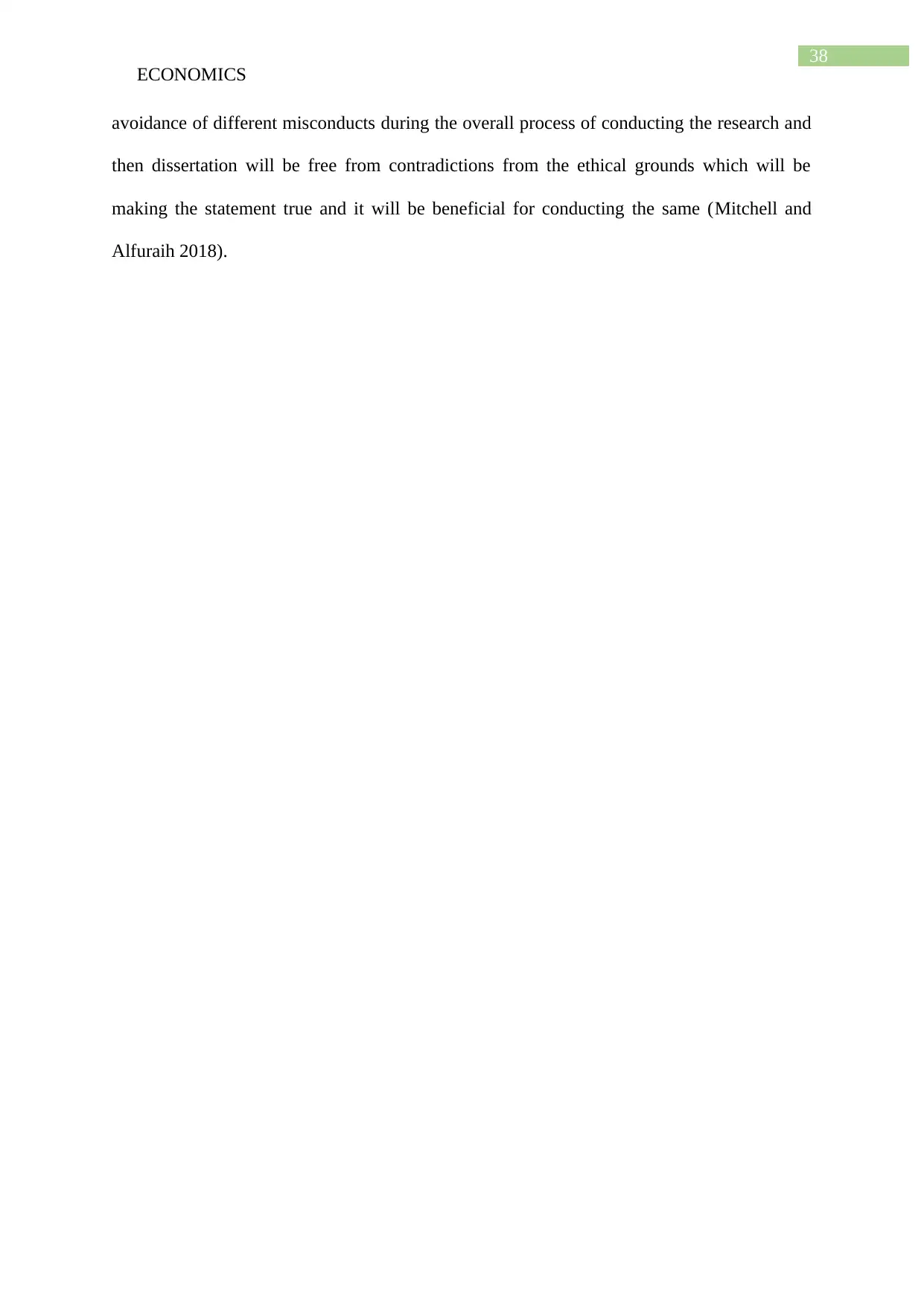
38
ECONOMICS
avoidance of different misconducts during the overall process of conducting the research and
then dissertation will be free from contradictions from the ethical grounds which will be
making the statement true and it will be beneficial for conducting the same (Mitchell and
Alfuraih 2018).
ECONOMICS
avoidance of different misconducts during the overall process of conducting the research and
then dissertation will be free from contradictions from the ethical grounds which will be
making the statement true and it will be beneficial for conducting the same (Mitchell and
Alfuraih 2018).

39
ECONOMICS
CHAPTER 4: FINDINGS AND ANALYSIS
4.1 Introduction
This section of the research paper will highlight on the findings from the secondary
research papers, internet articles and governmental publications towards the effect on the
commercial real estate sector of Saudi Arabia by the 2030 vision.
As stated in the previous chapters, Saudi Vision 2030 is the plan that aim for liberating the
kingdoms from the primary reliance over the oil, through the state’s investment fund for the
public (Anderson, Williamson and Wohl 2017). The kingdom of Saudi Arabia has announced
the strategic comprehensive version for the social and the economic life by the year 2030.
The findings of the research can be summarized as per the following themes.
4.2 Thematic Analysis
Theme 1: Expectation of changes
The market of the real estate of Saudi Arabia shows some of the promising growth
from the vision 2030. According to the research, the foreign investors have been looking for
investing in the real estate of the Saudi Arabia having some of the high expectations due to
the multiple announcements throughout the last year that are related to the vision 2030. More
than 50 percent of the respondent stated for an increase in the development of the real estate,
specifically in the residential properties which is about 33% towards the development of the
real estate (Kiani 2017). The respondents furthermore stated that the Vision 2030 would help
in the increase of the retail or the commercial units and would enable the foreign direct
investments in Saudi Arabia.
ECONOMICS
CHAPTER 4: FINDINGS AND ANALYSIS
4.1 Introduction
This section of the research paper will highlight on the findings from the secondary
research papers, internet articles and governmental publications towards the effect on the
commercial real estate sector of Saudi Arabia by the 2030 vision.
As stated in the previous chapters, Saudi Vision 2030 is the plan that aim for liberating the
kingdoms from the primary reliance over the oil, through the state’s investment fund for the
public (Anderson, Williamson and Wohl 2017). The kingdom of Saudi Arabia has announced
the strategic comprehensive version for the social and the economic life by the year 2030.
The findings of the research can be summarized as per the following themes.
4.2 Thematic Analysis
Theme 1: Expectation of changes
The market of the real estate of Saudi Arabia shows some of the promising growth
from the vision 2030. According to the research, the foreign investors have been looking for
investing in the real estate of the Saudi Arabia having some of the high expectations due to
the multiple announcements throughout the last year that are related to the vision 2030. More
than 50 percent of the respondent stated for an increase in the development of the real estate,
specifically in the residential properties which is about 33% towards the development of the
real estate (Kiani 2017). The respondents furthermore stated that the Vision 2030 would help
in the increase of the retail or the commercial units and would enable the foreign direct
investments in Saudi Arabia.
Secure Best Marks with AI Grader
Need help grading? Try our AI Grader for instant feedback on your assignments.
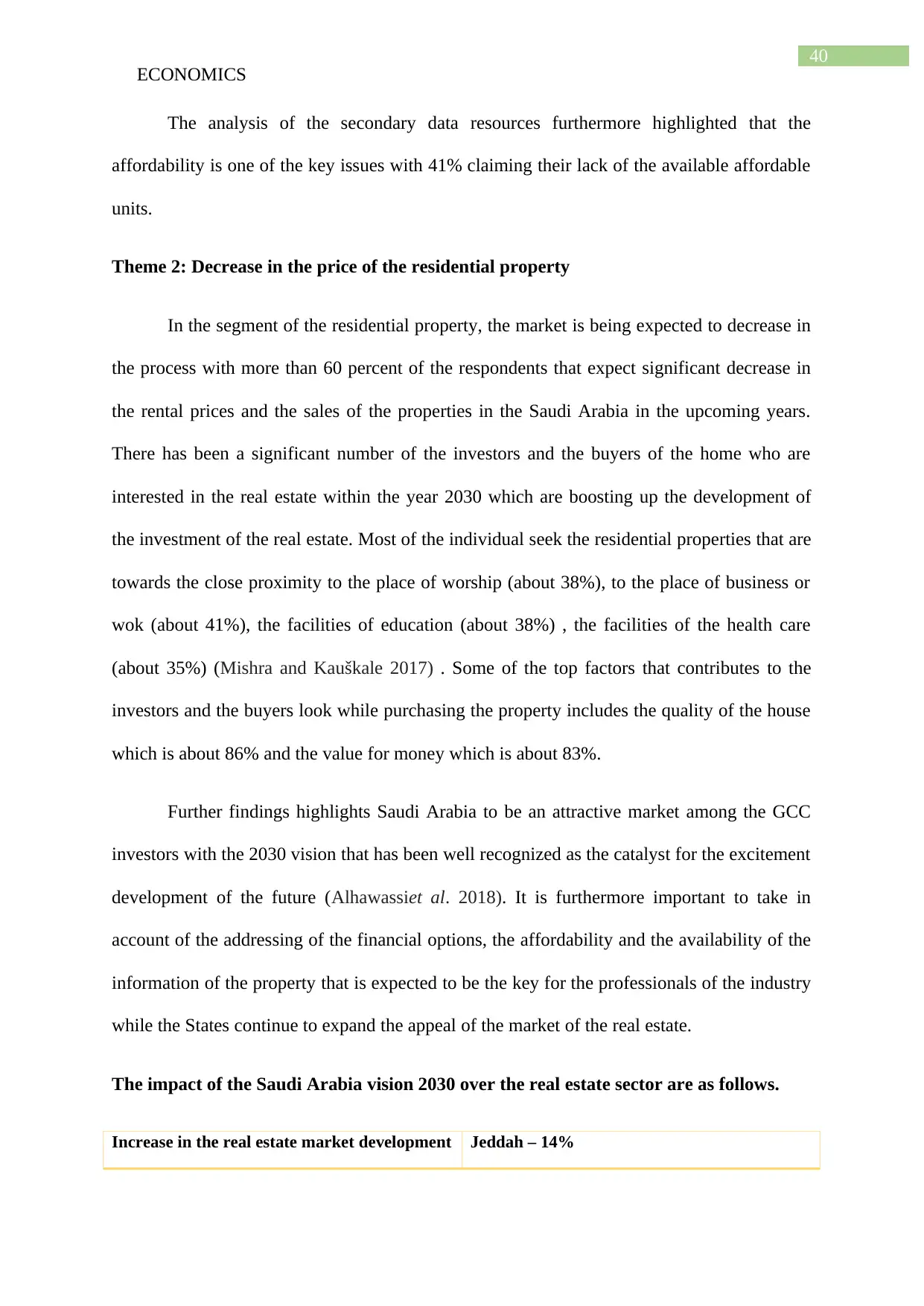
40
ECONOMICS
The analysis of the secondary data resources furthermore highlighted that the
affordability is one of the key issues with 41% claiming their lack of the available affordable
units.
Theme 2: Decrease in the price of the residential property
In the segment of the residential property, the market is being expected to decrease in
the process with more than 60 percent of the respondents that expect significant decrease in
the rental prices and the sales of the properties in the Saudi Arabia in the upcoming years.
There has been a significant number of the investors and the buyers of the home who are
interested in the real estate within the year 2030 which are boosting up the development of
the investment of the real estate. Most of the individual seek the residential properties that are
towards the close proximity to the place of worship (about 38%), to the place of business or
wok (about 41%), the facilities of education (about 38%) , the facilities of the health care
(about 35%) (Mishra and Kauškale 2017) . Some of the top factors that contributes to the
investors and the buyers look while purchasing the property includes the quality of the house
which is about 86% and the value for money which is about 83%.
Further findings highlights Saudi Arabia to be an attractive market among the GCC
investors with the 2030 vision that has been well recognized as the catalyst for the excitement
development of the future (Alhawassiet al. 2018). It is furthermore important to take in
account of the addressing of the financial options, the affordability and the availability of the
information of the property that is expected to be the key for the professionals of the industry
while the States continue to expand the appeal of the market of the real estate.
The impact of the Saudi Arabia vision 2030 over the real estate sector are as follows.
Increase in the real estate market development Jeddah – 14%
ECONOMICS
The analysis of the secondary data resources furthermore highlighted that the
affordability is one of the key issues with 41% claiming their lack of the available affordable
units.
Theme 2: Decrease in the price of the residential property
In the segment of the residential property, the market is being expected to decrease in
the process with more than 60 percent of the respondents that expect significant decrease in
the rental prices and the sales of the properties in the Saudi Arabia in the upcoming years.
There has been a significant number of the investors and the buyers of the home who are
interested in the real estate within the year 2030 which are boosting up the development of
the investment of the real estate. Most of the individual seek the residential properties that are
towards the close proximity to the place of worship (about 38%), to the place of business or
wok (about 41%), the facilities of education (about 38%) , the facilities of the health care
(about 35%) (Mishra and Kauškale 2017) . Some of the top factors that contributes to the
investors and the buyers look while purchasing the property includes the quality of the house
which is about 86% and the value for money which is about 83%.
Further findings highlights Saudi Arabia to be an attractive market among the GCC
investors with the 2030 vision that has been well recognized as the catalyst for the excitement
development of the future (Alhawassiet al. 2018). It is furthermore important to take in
account of the addressing of the financial options, the affordability and the availability of the
information of the property that is expected to be the key for the professionals of the industry
while the States continue to expand the appeal of the market of the real estate.
The impact of the Saudi Arabia vision 2030 over the real estate sector are as follows.
Increase in the real estate market development Jeddah – 14%
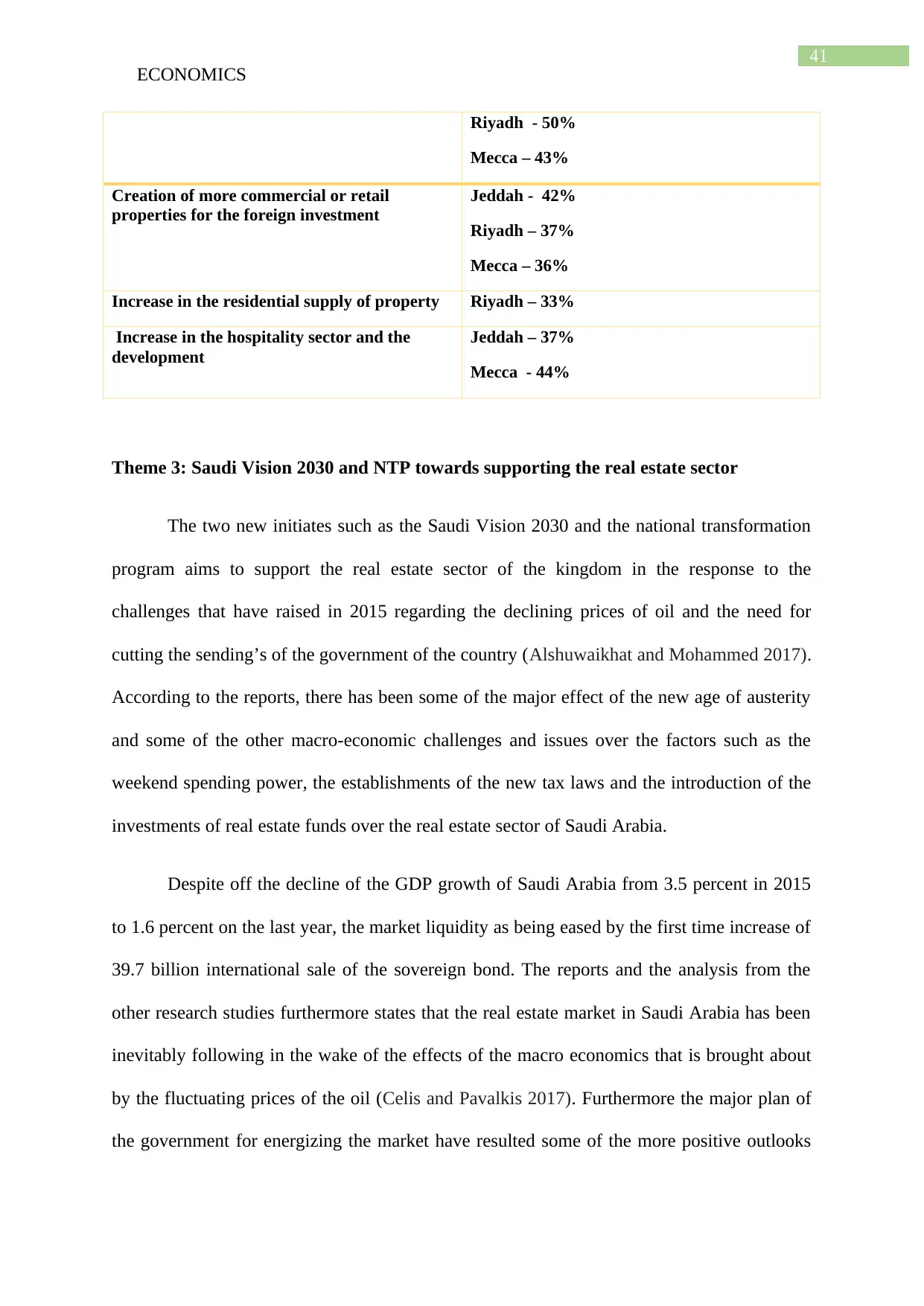
41
ECONOMICS
Riyadh - 50%
Mecca – 43%
Creation of more commercial or retail
properties for the foreign investment
Jeddah - 42%
Riyadh – 37%
Mecca – 36%
Increase in the residential supply of property Riyadh – 33%
Increase in the hospitality sector and the
development
Jeddah – 37%
Mecca - 44%
Theme 3: Saudi Vision 2030 and NTP towards supporting the real estate sector
The two new initiates such as the Saudi Vision 2030 and the national transformation
program aims to support the real estate sector of the kingdom in the response to the
challenges that have raised in 2015 regarding the declining prices of oil and the need for
cutting the sending’s of the government of the country (Alshuwaikhat and Mohammed 2017).
According to the reports, there has been some of the major effect of the new age of austerity
and some of the other macro-economic challenges and issues over the factors such as the
weekend spending power, the establishments of the new tax laws and the introduction of the
investments of real estate funds over the real estate sector of Saudi Arabia.
Despite off the decline of the GDP growth of Saudi Arabia from 3.5 percent in 2015
to 1.6 percent on the last year, the market liquidity as being eased by the first time increase of
39.7 billion international sale of the sovereign bond. The reports and the analysis from the
other research studies furthermore states that the real estate market in Saudi Arabia has been
inevitably following in the wake of the effects of the macro economics that is brought about
by the fluctuating prices of the oil (Celis and Pavalkis 2017). Furthermore the major plan of
the government for energizing the market have resulted some of the more positive outlooks
ECONOMICS
Riyadh - 50%
Mecca – 43%
Creation of more commercial or retail
properties for the foreign investment
Jeddah - 42%
Riyadh – 37%
Mecca – 36%
Increase in the residential supply of property Riyadh – 33%
Increase in the hospitality sector and the
development
Jeddah – 37%
Mecca - 44%
Theme 3: Saudi Vision 2030 and NTP towards supporting the real estate sector
The two new initiates such as the Saudi Vision 2030 and the national transformation
program aims to support the real estate sector of the kingdom in the response to the
challenges that have raised in 2015 regarding the declining prices of oil and the need for
cutting the sending’s of the government of the country (Alshuwaikhat and Mohammed 2017).
According to the reports, there has been some of the major effect of the new age of austerity
and some of the other macro-economic challenges and issues over the factors such as the
weekend spending power, the establishments of the new tax laws and the introduction of the
investments of real estate funds over the real estate sector of Saudi Arabia.
Despite off the decline of the GDP growth of Saudi Arabia from 3.5 percent in 2015
to 1.6 percent on the last year, the market liquidity as being eased by the first time increase of
39.7 billion international sale of the sovereign bond. The reports and the analysis from the
other research studies furthermore states that the real estate market in Saudi Arabia has been
inevitably following in the wake of the effects of the macro economics that is brought about
by the fluctuating prices of the oil (Celis and Pavalkis 2017). Furthermore the major plan of
the government for energizing the market have resulted some of the more positive outlooks
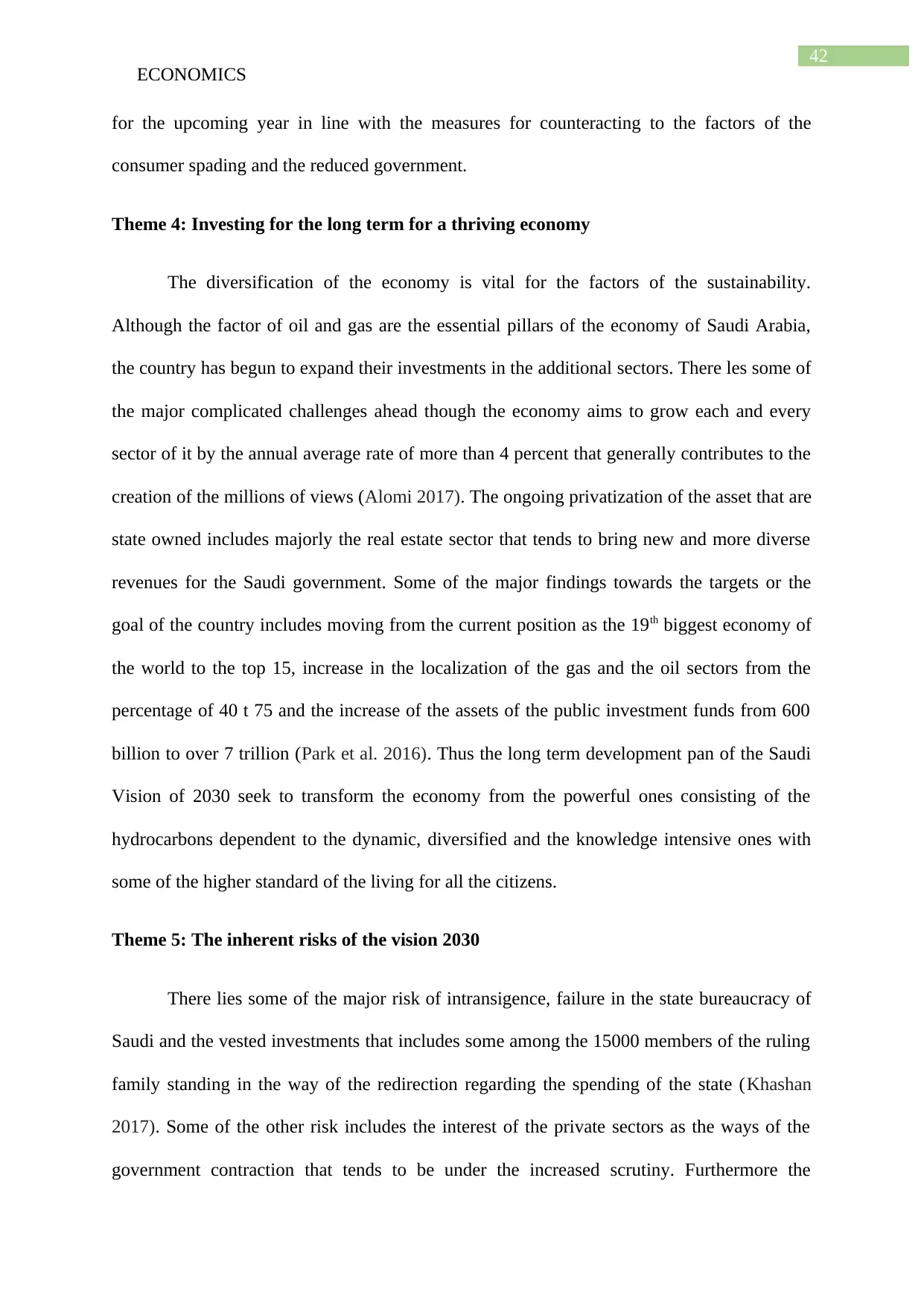
42
ECONOMICS
for the upcoming year in line with the measures for counteracting to the factors of the
consumer spading and the reduced government.
Theme 4: Investing for the long term for a thriving economy
The diversification of the economy is vital for the factors of the sustainability.
Although the factor of oil and gas are the essential pillars of the economy of Saudi Arabia,
the country has begun to expand their investments in the additional sectors. There les some of
the major complicated challenges ahead though the economy aims to grow each and every
sector of it by the annual average rate of more than 4 percent that generally contributes to the
creation of the millions of views (Alomi 2017). The ongoing privatization of the asset that are
state owned includes majorly the real estate sector that tends to bring new and more diverse
revenues for the Saudi government. Some of the major findings towards the targets or the
goal of the country includes moving from the current position as the 19th biggest economy of
the world to the top 15, increase in the localization of the gas and the oil sectors from the
percentage of 40 t 75 and the increase of the assets of the public investment funds from 600
billion to over 7 trillion (Park et al. 2016). Thus the long term development pan of the Saudi
Vision of 2030 seek to transform the economy from the powerful ones consisting of the
hydrocarbons dependent to the dynamic, diversified and the knowledge intensive ones with
some of the higher standard of the living for all the citizens.
Theme 5: The inherent risks of the vision 2030
There lies some of the major risk of intransigence, failure in the state bureaucracy of
Saudi and the vested investments that includes some among the 15000 members of the ruling
family standing in the way of the redirection regarding the spending of the state (Khashan
2017). Some of the other risk includes the interest of the private sectors as the ways of the
government contraction that tends to be under the increased scrutiny. Furthermore the
ECONOMICS
for the upcoming year in line with the measures for counteracting to the factors of the
consumer spading and the reduced government.
Theme 4: Investing for the long term for a thriving economy
The diversification of the economy is vital for the factors of the sustainability.
Although the factor of oil and gas are the essential pillars of the economy of Saudi Arabia,
the country has begun to expand their investments in the additional sectors. There les some of
the major complicated challenges ahead though the economy aims to grow each and every
sector of it by the annual average rate of more than 4 percent that generally contributes to the
creation of the millions of views (Alomi 2017). The ongoing privatization of the asset that are
state owned includes majorly the real estate sector that tends to bring new and more diverse
revenues for the Saudi government. Some of the major findings towards the targets or the
goal of the country includes moving from the current position as the 19th biggest economy of
the world to the top 15, increase in the localization of the gas and the oil sectors from the
percentage of 40 t 75 and the increase of the assets of the public investment funds from 600
billion to over 7 trillion (Park et al. 2016). Thus the long term development pan of the Saudi
Vision of 2030 seek to transform the economy from the powerful ones consisting of the
hydrocarbons dependent to the dynamic, diversified and the knowledge intensive ones with
some of the higher standard of the living for all the citizens.
Theme 5: The inherent risks of the vision 2030
There lies some of the major risk of intransigence, failure in the state bureaucracy of
Saudi and the vested investments that includes some among the 15000 members of the ruling
family standing in the way of the redirection regarding the spending of the state (Khashan
2017). Some of the other risk includes the interest of the private sectors as the ways of the
government contraction that tends to be under the increased scrutiny. Furthermore the
Paraphrase This Document
Need a fresh take? Get an instant paraphrase of this document with our AI Paraphraser
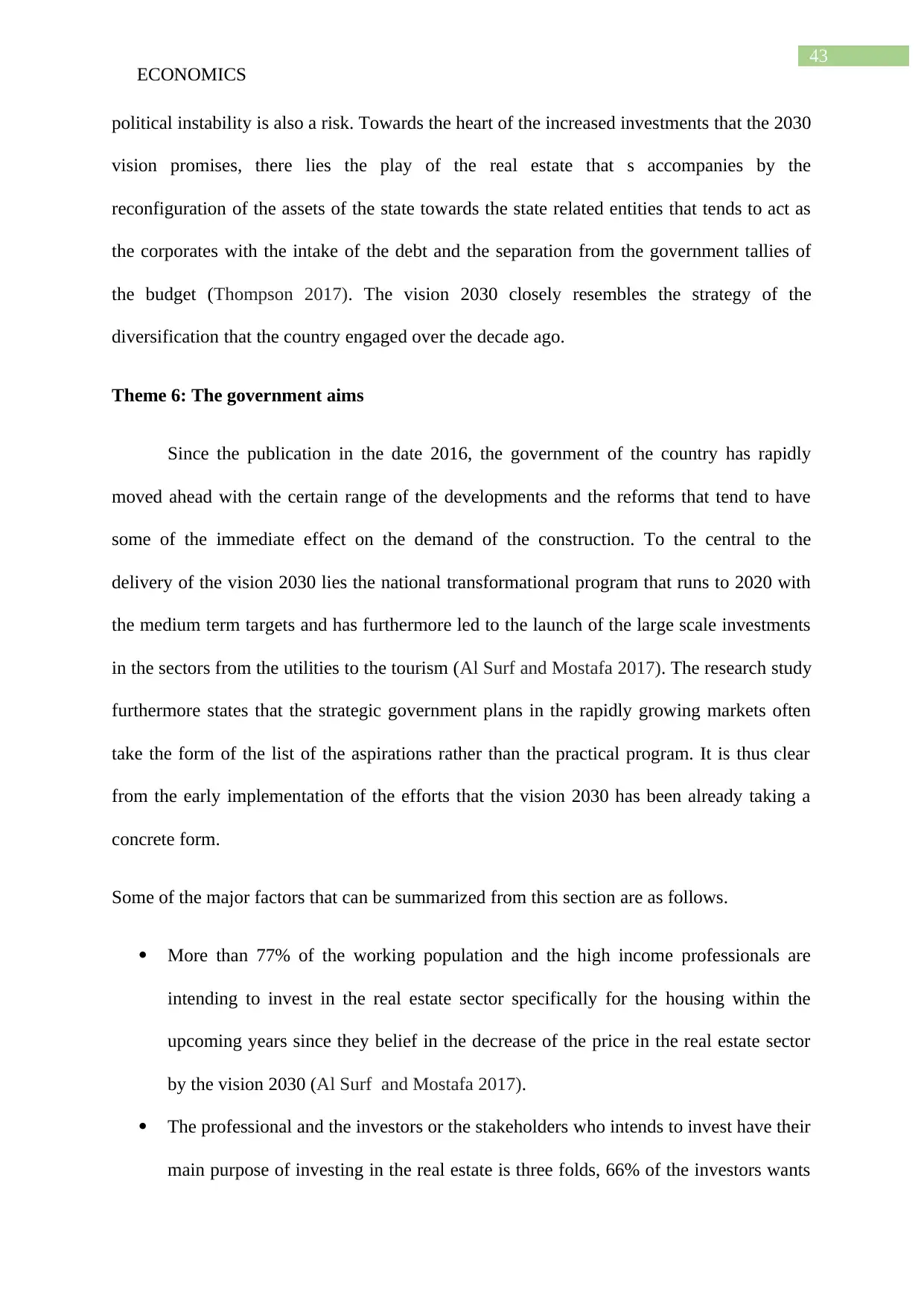
43
ECONOMICS
political instability is also a risk. Towards the heart of the increased investments that the 2030
vision promises, there lies the play of the real estate that s accompanies by the
reconfiguration of the assets of the state towards the state related entities that tends to act as
the corporates with the intake of the debt and the separation from the government tallies of
the budget (Thompson 2017). The vision 2030 closely resembles the strategy of the
diversification that the country engaged over the decade ago.
Theme 6: The government aims
Since the publication in the date 2016, the government of the country has rapidly
moved ahead with the certain range of the developments and the reforms that tend to have
some of the immediate effect on the demand of the construction. To the central to the
delivery of the vision 2030 lies the national transformational program that runs to 2020 with
the medium term targets and has furthermore led to the launch of the large scale investments
in the sectors from the utilities to the tourism (Al Surf and Mostafa 2017). The research study
furthermore states that the strategic government plans in the rapidly growing markets often
take the form of the list of the aspirations rather than the practical program. It is thus clear
from the early implementation of the efforts that the vision 2030 has been already taking a
concrete form.
Some of the major factors that can be summarized from this section are as follows.
More than 77% of the working population and the high income professionals are
intending to invest in the real estate sector specifically for the housing within the
upcoming years since they belief in the decrease of the price in the real estate sector
by the vision 2030 (Al Surf and Mostafa 2017).
The professional and the investors or the stakeholders who intends to invest have their
main purpose of investing in the real estate is three folds, 66% of the investors wants
ECONOMICS
political instability is also a risk. Towards the heart of the increased investments that the 2030
vision promises, there lies the play of the real estate that s accompanies by the
reconfiguration of the assets of the state towards the state related entities that tends to act as
the corporates with the intake of the debt and the separation from the government tallies of
the budget (Thompson 2017). The vision 2030 closely resembles the strategy of the
diversification that the country engaged over the decade ago.
Theme 6: The government aims
Since the publication in the date 2016, the government of the country has rapidly
moved ahead with the certain range of the developments and the reforms that tend to have
some of the immediate effect on the demand of the construction. To the central to the
delivery of the vision 2030 lies the national transformational program that runs to 2020 with
the medium term targets and has furthermore led to the launch of the large scale investments
in the sectors from the utilities to the tourism (Al Surf and Mostafa 2017). The research study
furthermore states that the strategic government plans in the rapidly growing markets often
take the form of the list of the aspirations rather than the practical program. It is thus clear
from the early implementation of the efforts that the vision 2030 has been already taking a
concrete form.
Some of the major factors that can be summarized from this section are as follows.
More than 77% of the working population and the high income professionals are
intending to invest in the real estate sector specifically for the housing within the
upcoming years since they belief in the decrease of the price in the real estate sector
by the vision 2030 (Al Surf and Mostafa 2017).
The professional and the investors or the stakeholders who intends to invest have their
main purpose of investing in the real estate is three folds, 66% of the investors wants
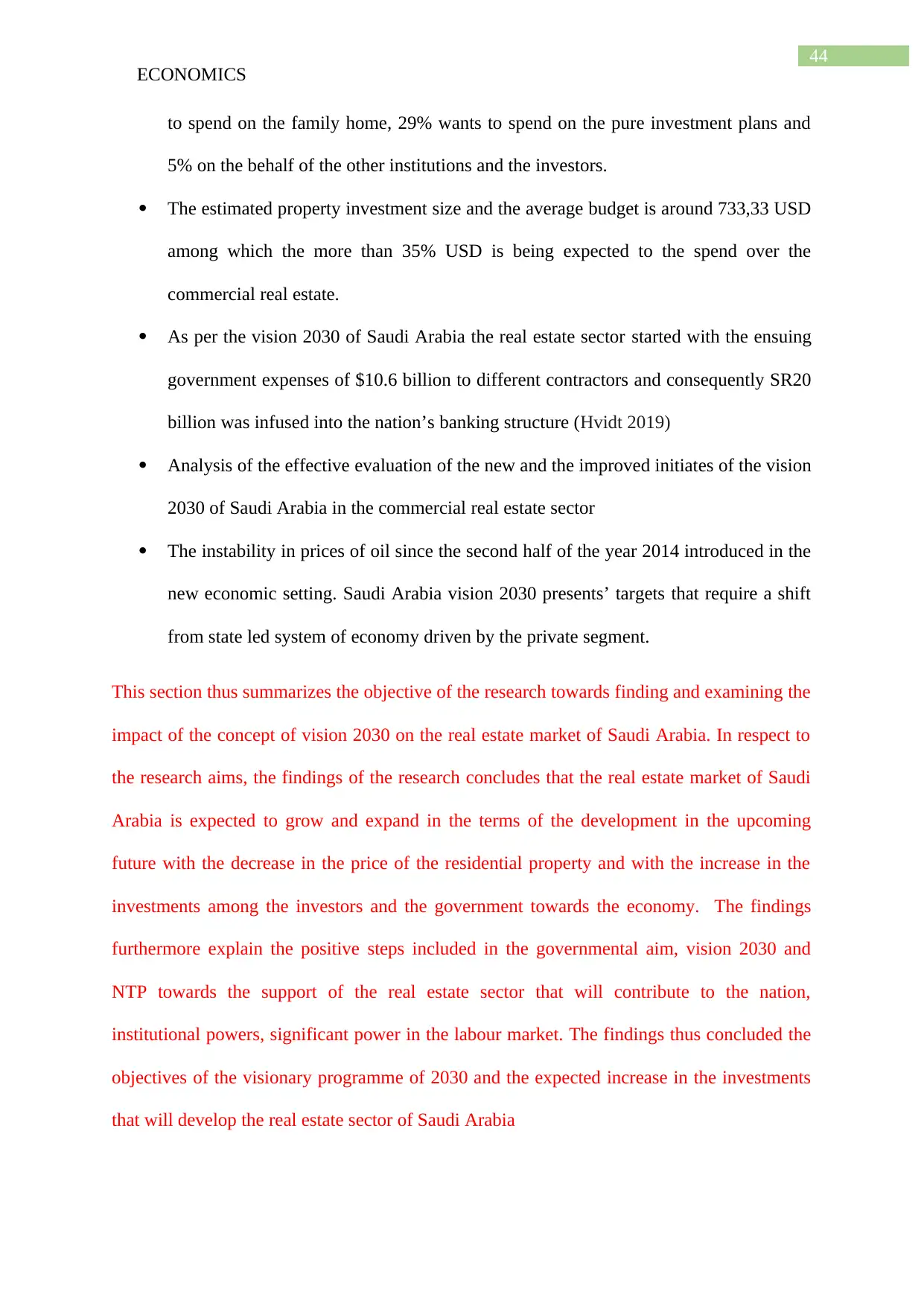
44
ECONOMICS
to spend on the family home, 29% wants to spend on the pure investment plans and
5% on the behalf of the other institutions and the investors.
The estimated property investment size and the average budget is around 733,33 USD
among which the more than 35% USD is being expected to the spend over the
commercial real estate.
As per the vision 2030 of Saudi Arabia the real estate sector started with the ensuing
government expenses of $10.6 billion to different contractors and consequently SR20
billion was infused into the nation’s banking structure (Hvidt 2019)
Analysis of the effective evaluation of the new and the improved initiates of the vision
2030 of Saudi Arabia in the commercial real estate sector
The instability in prices of oil since the second half of the year 2014 introduced in the
new economic setting. Saudi Arabia vision 2030 presents’ targets that require a shift
from state led system of economy driven by the private segment.
This section thus summarizes the objective of the research towards finding and examining the
impact of the concept of vision 2030 on the real estate market of Saudi Arabia. In respect to
the research aims, the findings of the research concludes that the real estate market of Saudi
Arabia is expected to grow and expand in the terms of the development in the upcoming
future with the decrease in the price of the residential property and with the increase in the
investments among the investors and the government towards the economy. The findings
furthermore explain the positive steps included in the governmental aim, vision 2030 and
NTP towards the support of the real estate sector that will contribute to the nation,
institutional powers, significant power in the labour market. The findings thus concluded the
objectives of the visionary programme of 2030 and the expected increase in the investments
that will develop the real estate sector of Saudi Arabia
ECONOMICS
to spend on the family home, 29% wants to spend on the pure investment plans and
5% on the behalf of the other institutions and the investors.
The estimated property investment size and the average budget is around 733,33 USD
among which the more than 35% USD is being expected to the spend over the
commercial real estate.
As per the vision 2030 of Saudi Arabia the real estate sector started with the ensuing
government expenses of $10.6 billion to different contractors and consequently SR20
billion was infused into the nation’s banking structure (Hvidt 2019)
Analysis of the effective evaluation of the new and the improved initiates of the vision
2030 of Saudi Arabia in the commercial real estate sector
The instability in prices of oil since the second half of the year 2014 introduced in the
new economic setting. Saudi Arabia vision 2030 presents’ targets that require a shift
from state led system of economy driven by the private segment.
This section thus summarizes the objective of the research towards finding and examining the
impact of the concept of vision 2030 on the real estate market of Saudi Arabia. In respect to
the research aims, the findings of the research concludes that the real estate market of Saudi
Arabia is expected to grow and expand in the terms of the development in the upcoming
future with the decrease in the price of the residential property and with the increase in the
investments among the investors and the government towards the economy. The findings
furthermore explain the positive steps included in the governmental aim, vision 2030 and
NTP towards the support of the real estate sector that will contribute to the nation,
institutional powers, significant power in the labour market. The findings thus concluded the
objectives of the visionary programme of 2030 and the expected increase in the investments
that will develop the real estate sector of Saudi Arabia
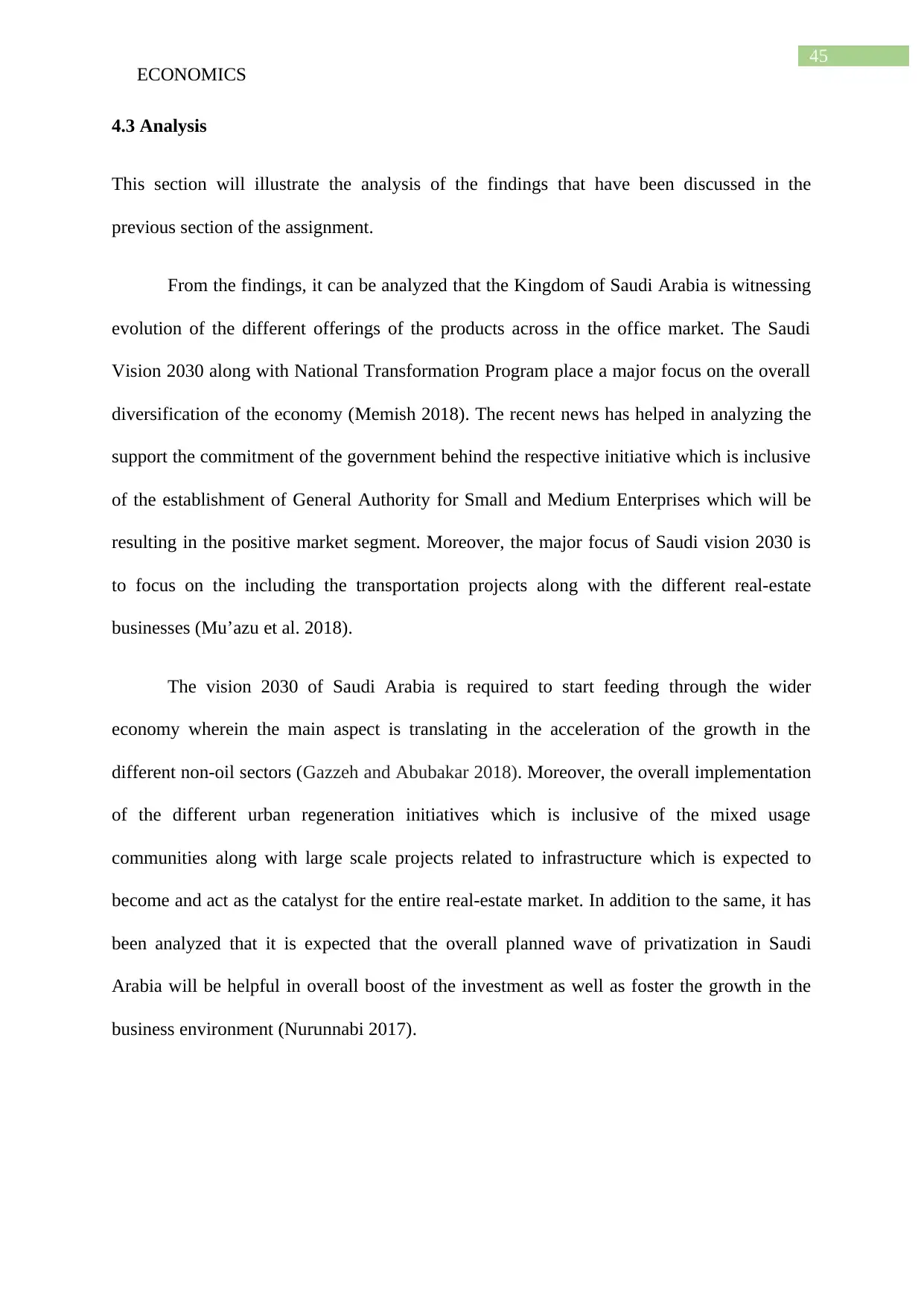
45
ECONOMICS
4.3 Analysis
This section will illustrate the analysis of the findings that have been discussed in the
previous section of the assignment.
From the findings, it can be analyzed that the Kingdom of Saudi Arabia is witnessing
evolution of the different offerings of the products across in the office market. The Saudi
Vision 2030 along with National Transformation Program place a major focus on the overall
diversification of the economy (Memish 2018). The recent news has helped in analyzing the
support the commitment of the government behind the respective initiative which is inclusive
of the establishment of General Authority for Small and Medium Enterprises which will be
resulting in the positive market segment. Moreover, the major focus of Saudi vision 2030 is
to focus on the including the transportation projects along with the different real-estate
businesses (Mu’azu et al. 2018).
The vision 2030 of Saudi Arabia is required to start feeding through the wider
economy wherein the main aspect is translating in the acceleration of the growth in the
different non-oil sectors (Gazzeh and Abubakar 2018). Moreover, the overall implementation
of the different urban regeneration initiatives which is inclusive of the mixed usage
communities along with large scale projects related to infrastructure which is expected to
become and act as the catalyst for the entire real-estate market. In addition to the same, it has
been analyzed that it is expected that the overall planned wave of privatization in Saudi
Arabia will be helpful in overall boost of the investment as well as foster the growth in the
business environment (Nurunnabi 2017).
ECONOMICS
4.3 Analysis
This section will illustrate the analysis of the findings that have been discussed in the
previous section of the assignment.
From the findings, it can be analyzed that the Kingdom of Saudi Arabia is witnessing
evolution of the different offerings of the products across in the office market. The Saudi
Vision 2030 along with National Transformation Program place a major focus on the overall
diversification of the economy (Memish 2018). The recent news has helped in analyzing the
support the commitment of the government behind the respective initiative which is inclusive
of the establishment of General Authority for Small and Medium Enterprises which will be
resulting in the positive market segment. Moreover, the major focus of Saudi vision 2030 is
to focus on the including the transportation projects along with the different real-estate
businesses (Mu’azu et al. 2018).
The vision 2030 of Saudi Arabia is required to start feeding through the wider
economy wherein the main aspect is translating in the acceleration of the growth in the
different non-oil sectors (Gazzeh and Abubakar 2018). Moreover, the overall implementation
of the different urban regeneration initiatives which is inclusive of the mixed usage
communities along with large scale projects related to infrastructure which is expected to
become and act as the catalyst for the entire real-estate market. In addition to the same, it has
been analyzed that it is expected that the overall planned wave of privatization in Saudi
Arabia will be helpful in overall boost of the investment as well as foster the growth in the
business environment (Nurunnabi 2017).
Secure Best Marks with AI Grader
Need help grading? Try our AI Grader for instant feedback on your assignments.
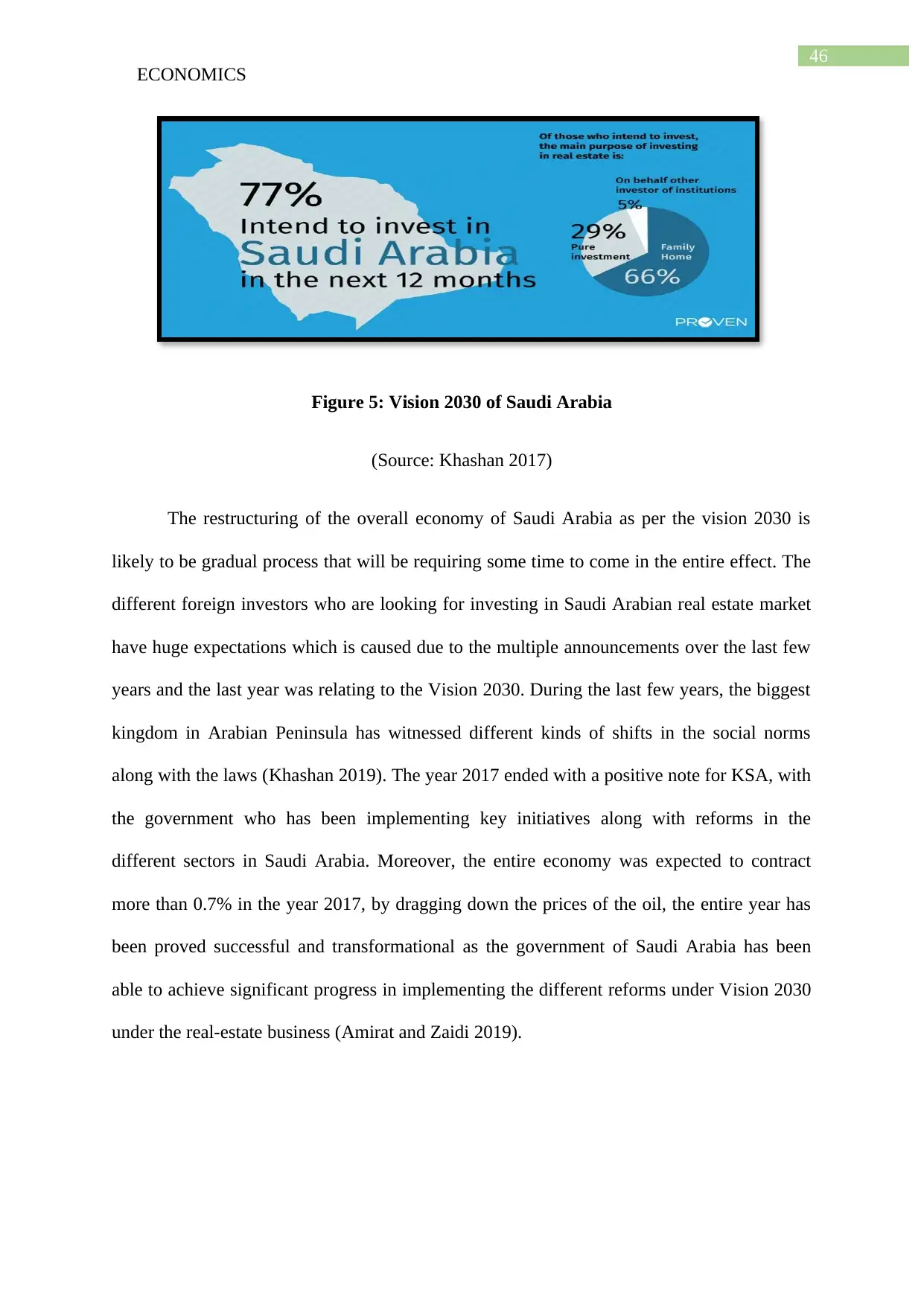
46
ECONOMICS
Figure 5: Vision 2030 of Saudi Arabia
(Source: Khashan 2017)
The restructuring of the overall economy of Saudi Arabia as per the vision 2030 is
likely to be gradual process that will be requiring some time to come in the entire effect. The
different foreign investors who are looking for investing in Saudi Arabian real estate market
have huge expectations which is caused due to the multiple announcements over the last few
years and the last year was relating to the Vision 2030. During the last few years, the biggest
kingdom in Arabian Peninsula has witnessed different kinds of shifts in the social norms
along with the laws (Khashan 2019). The year 2017 ended with a positive note for KSA, with
the government who has been implementing key initiatives along with reforms in the
different sectors in Saudi Arabia. Moreover, the entire economy was expected to contract
more than 0.7% in the year 2017, by dragging down the prices of the oil, the entire year has
been proved successful and transformational as the government of Saudi Arabia has been
able to achieve significant progress in implementing the different reforms under Vision 2030
under the real-estate business (Amirat and Zaidi 2019).
ECONOMICS
Figure 5: Vision 2030 of Saudi Arabia
(Source: Khashan 2017)
The restructuring of the overall economy of Saudi Arabia as per the vision 2030 is
likely to be gradual process that will be requiring some time to come in the entire effect. The
different foreign investors who are looking for investing in Saudi Arabian real estate market
have huge expectations which is caused due to the multiple announcements over the last few
years and the last year was relating to the Vision 2030. During the last few years, the biggest
kingdom in Arabian Peninsula has witnessed different kinds of shifts in the social norms
along with the laws (Khashan 2019). The year 2017 ended with a positive note for KSA, with
the government who has been implementing key initiatives along with reforms in the
different sectors in Saudi Arabia. Moreover, the entire economy was expected to contract
more than 0.7% in the year 2017, by dragging down the prices of the oil, the entire year has
been proved successful and transformational as the government of Saudi Arabia has been
able to achieve significant progress in implementing the different reforms under Vision 2030
under the real-estate business (Amirat and Zaidi 2019).
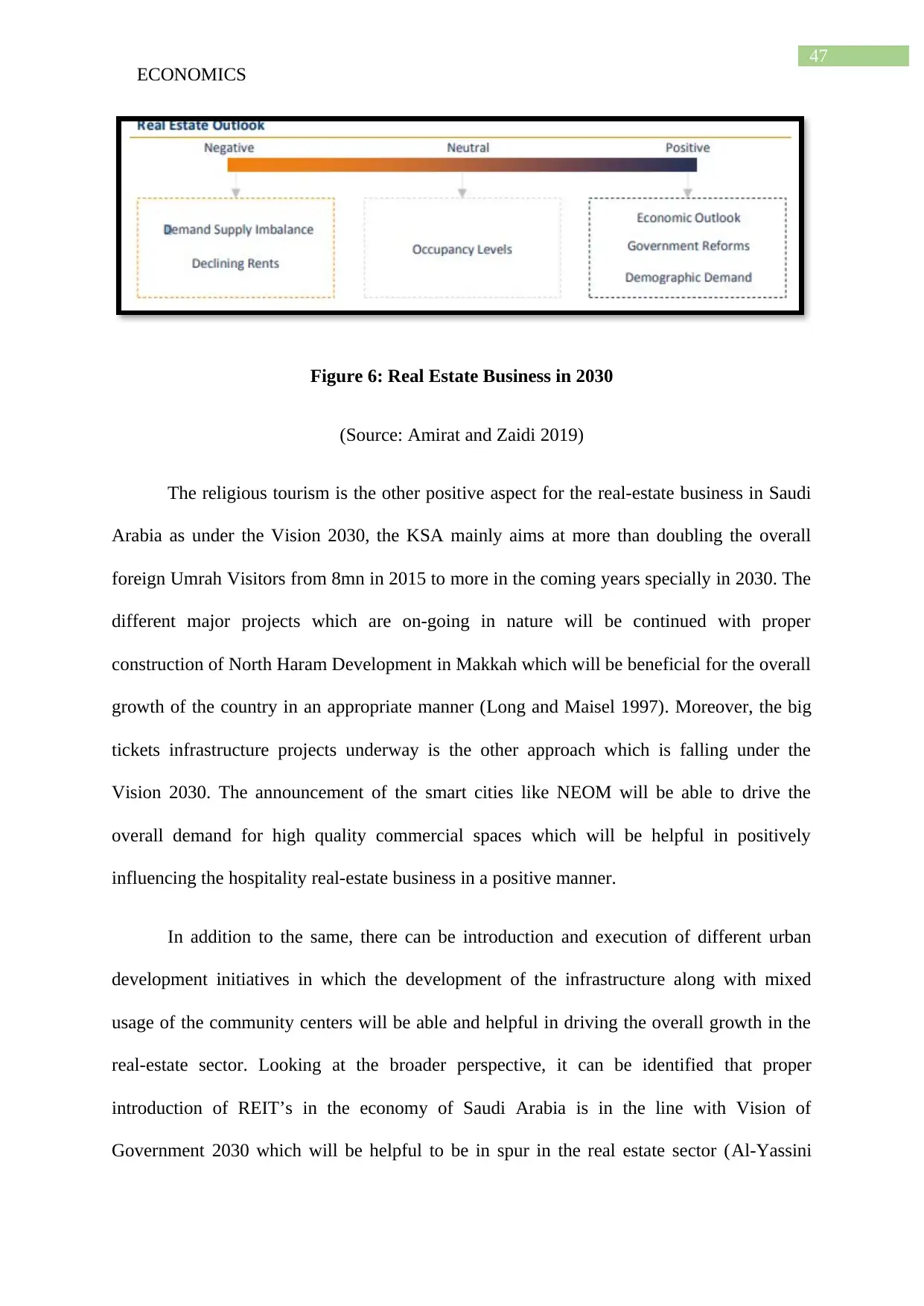
47
ECONOMICS
Figure 6: Real Estate Business in 2030
(Source: Amirat and Zaidi 2019)
The religious tourism is the other positive aspect for the real-estate business in Saudi
Arabia as under the Vision 2030, the KSA mainly aims at more than doubling the overall
foreign Umrah Visitors from 8mn in 2015 to more in the coming years specially in 2030. The
different major projects which are on-going in nature will be continued with proper
construction of North Haram Development in Makkah which will be beneficial for the overall
growth of the country in an appropriate manner (Long and Maisel 1997). Moreover, the big
tickets infrastructure projects underway is the other approach which is falling under the
Vision 2030. The announcement of the smart cities like NEOM will be able to drive the
overall demand for high quality commercial spaces which will be helpful in positively
influencing the hospitality real-estate business in a positive manner.
In addition to the same, there can be introduction and execution of different urban
development initiatives in which the development of the infrastructure along with mixed
usage of the community centers will be able and helpful in driving the overall growth in the
real-estate sector. Looking at the broader perspective, it can be identified that proper
introduction of REIT’s in the economy of Saudi Arabia is in the line with Vision of
Government 2030 which will be helpful to be in spur in the real estate sector (Al-Yassini
ECONOMICS
Figure 6: Real Estate Business in 2030
(Source: Amirat and Zaidi 2019)
The religious tourism is the other positive aspect for the real-estate business in Saudi
Arabia as under the Vision 2030, the KSA mainly aims at more than doubling the overall
foreign Umrah Visitors from 8mn in 2015 to more in the coming years specially in 2030. The
different major projects which are on-going in nature will be continued with proper
construction of North Haram Development in Makkah which will be beneficial for the overall
growth of the country in an appropriate manner (Long and Maisel 1997). Moreover, the big
tickets infrastructure projects underway is the other approach which is falling under the
Vision 2030. The announcement of the smart cities like NEOM will be able to drive the
overall demand for high quality commercial spaces which will be helpful in positively
influencing the hospitality real-estate business in a positive manner.
In addition to the same, there can be introduction and execution of different urban
development initiatives in which the development of the infrastructure along with mixed
usage of the community centers will be able and helpful in driving the overall growth in the
real-estate sector. Looking at the broader perspective, it can be identified that proper
introduction of REIT’s in the economy of Saudi Arabia is in the line with Vision of
Government 2030 which will be helpful to be in spur in the real estate sector (Al-Yassini
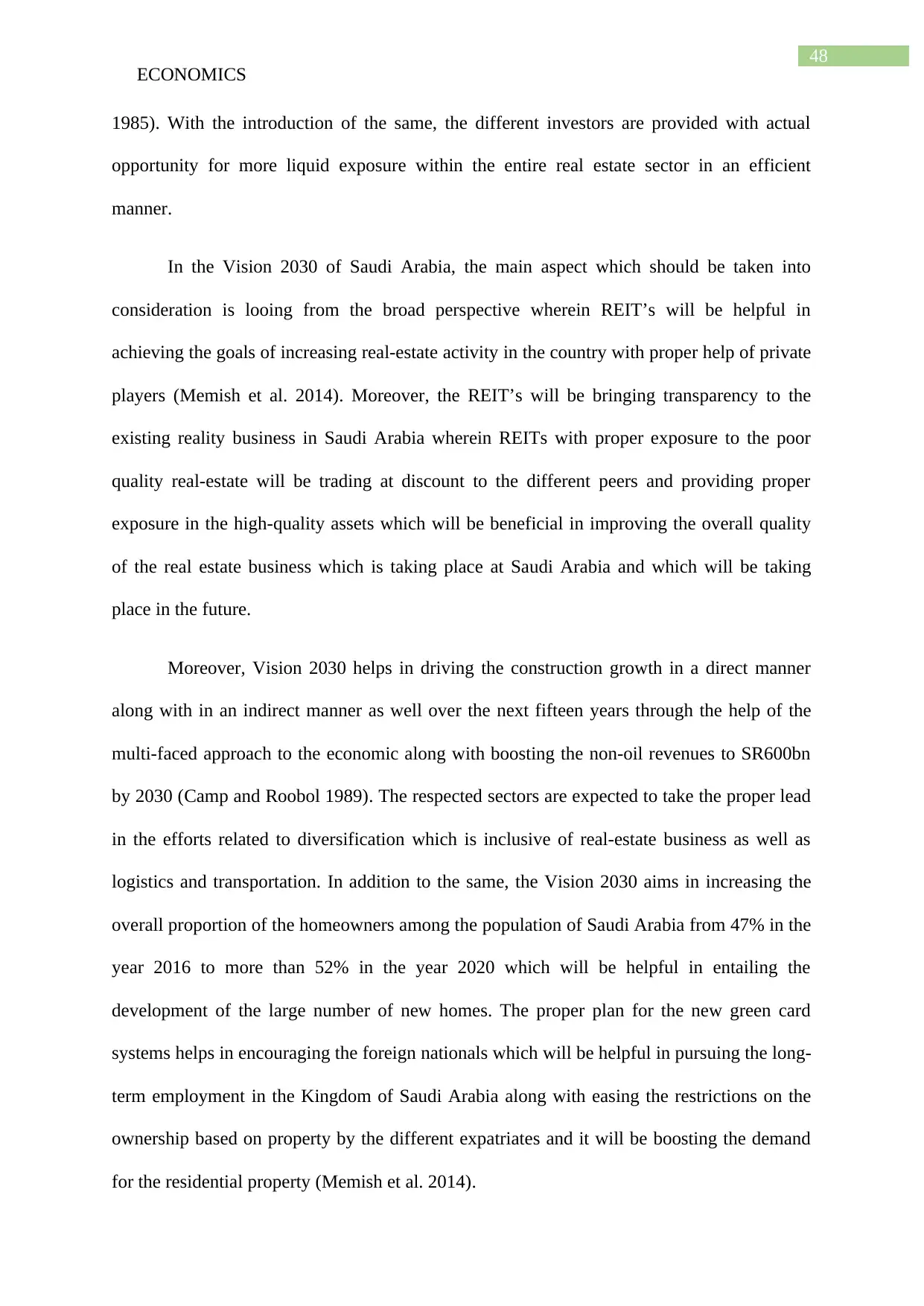
48
ECONOMICS
1985). With the introduction of the same, the different investors are provided with actual
opportunity for more liquid exposure within the entire real estate sector in an efficient
manner.
In the Vision 2030 of Saudi Arabia, the main aspect which should be taken into
consideration is looing from the broad perspective wherein REIT’s will be helpful in
achieving the goals of increasing real-estate activity in the country with proper help of private
players (Memish et al. 2014). Moreover, the REIT’s will be bringing transparency to the
existing reality business in Saudi Arabia wherein REITs with proper exposure to the poor
quality real-estate will be trading at discount to the different peers and providing proper
exposure in the high-quality assets which will be beneficial in improving the overall quality
of the real estate business which is taking place at Saudi Arabia and which will be taking
place in the future.
Moreover, Vision 2030 helps in driving the construction growth in a direct manner
along with in an indirect manner as well over the next fifteen years through the help of the
multi-faced approach to the economic along with boosting the non-oil revenues to SR600bn
by 2030 (Camp and Roobol 1989). The respected sectors are expected to take the proper lead
in the efforts related to diversification which is inclusive of real-estate business as well as
logistics and transportation. In addition to the same, the Vision 2030 aims in increasing the
overall proportion of the homeowners among the population of Saudi Arabia from 47% in the
year 2016 to more than 52% in the year 2020 which will be helpful in entailing the
development of the large number of new homes. The proper plan for the new green card
systems helps in encouraging the foreign nationals which will be helpful in pursuing the long-
term employment in the Kingdom of Saudi Arabia along with easing the restrictions on the
ownership based on property by the different expatriates and it will be boosting the demand
for the residential property (Memish et al. 2014).
ECONOMICS
1985). With the introduction of the same, the different investors are provided with actual
opportunity for more liquid exposure within the entire real estate sector in an efficient
manner.
In the Vision 2030 of Saudi Arabia, the main aspect which should be taken into
consideration is looing from the broad perspective wherein REIT’s will be helpful in
achieving the goals of increasing real-estate activity in the country with proper help of private
players (Memish et al. 2014). Moreover, the REIT’s will be bringing transparency to the
existing reality business in Saudi Arabia wherein REITs with proper exposure to the poor
quality real-estate will be trading at discount to the different peers and providing proper
exposure in the high-quality assets which will be beneficial in improving the overall quality
of the real estate business which is taking place at Saudi Arabia and which will be taking
place in the future.
Moreover, Vision 2030 helps in driving the construction growth in a direct manner
along with in an indirect manner as well over the next fifteen years through the help of the
multi-faced approach to the economic along with boosting the non-oil revenues to SR600bn
by 2030 (Camp and Roobol 1989). The respected sectors are expected to take the proper lead
in the efforts related to diversification which is inclusive of real-estate business as well as
logistics and transportation. In addition to the same, the Vision 2030 aims in increasing the
overall proportion of the homeowners among the population of Saudi Arabia from 47% in the
year 2016 to more than 52% in the year 2020 which will be helpful in entailing the
development of the large number of new homes. The proper plan for the new green card
systems helps in encouraging the foreign nationals which will be helpful in pursuing the long-
term employment in the Kingdom of Saudi Arabia along with easing the restrictions on the
ownership based on property by the different expatriates and it will be boosting the demand
for the residential property (Memish et al. 2014).
Paraphrase This Document
Need a fresh take? Get an instant paraphrase of this document with our AI Paraphraser
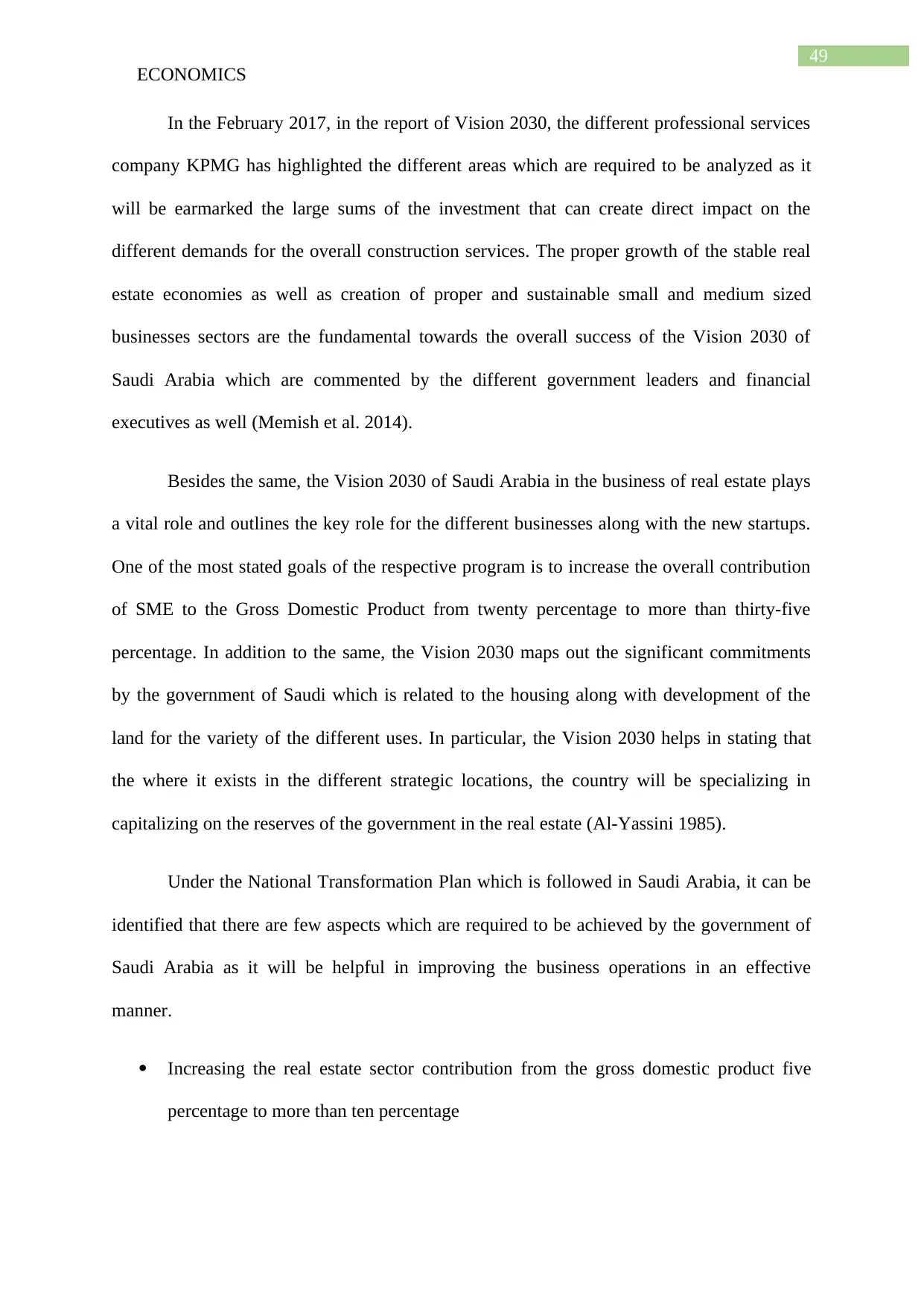
49
ECONOMICS
In the February 2017, in the report of Vision 2030, the different professional services
company KPMG has highlighted the different areas which are required to be analyzed as it
will be earmarked the large sums of the investment that can create direct impact on the
different demands for the overall construction services. The proper growth of the stable real
estate economies as well as creation of proper and sustainable small and medium sized
businesses sectors are the fundamental towards the overall success of the Vision 2030 of
Saudi Arabia which are commented by the different government leaders and financial
executives as well (Memish et al. 2014).
Besides the same, the Vision 2030 of Saudi Arabia in the business of real estate plays
a vital role and outlines the key role for the different businesses along with the new startups.
One of the most stated goals of the respective program is to increase the overall contribution
of SME to the Gross Domestic Product from twenty percentage to more than thirty-five
percentage. In addition to the same, the Vision 2030 maps out the significant commitments
by the government of Saudi which is related to the housing along with development of the
land for the variety of the different uses. In particular, the Vision 2030 helps in stating that
the where it exists in the different strategic locations, the country will be specializing in
capitalizing on the reserves of the government in the real estate (Al-Yassini 1985).
Under the National Transformation Plan which is followed in Saudi Arabia, it can be
identified that there are few aspects which are required to be achieved by the government of
Saudi Arabia as it will be helpful in improving the business operations in an effective
manner.
Increasing the real estate sector contribution from the gross domestic product five
percentage to more than ten percentage
ECONOMICS
In the February 2017, in the report of Vision 2030, the different professional services
company KPMG has highlighted the different areas which are required to be analyzed as it
will be earmarked the large sums of the investment that can create direct impact on the
different demands for the overall construction services. The proper growth of the stable real
estate economies as well as creation of proper and sustainable small and medium sized
businesses sectors are the fundamental towards the overall success of the Vision 2030 of
Saudi Arabia which are commented by the different government leaders and financial
executives as well (Memish et al. 2014).
Besides the same, the Vision 2030 of Saudi Arabia in the business of real estate plays
a vital role and outlines the key role for the different businesses along with the new startups.
One of the most stated goals of the respective program is to increase the overall contribution
of SME to the Gross Domestic Product from twenty percentage to more than thirty-five
percentage. In addition to the same, the Vision 2030 maps out the significant commitments
by the government of Saudi which is related to the housing along with development of the
land for the variety of the different uses. In particular, the Vision 2030 helps in stating that
the where it exists in the different strategic locations, the country will be specializing in
capitalizing on the reserves of the government in the real estate (Al-Yassini 1985).
Under the National Transformation Plan which is followed in Saudi Arabia, it can be
identified that there are few aspects which are required to be achieved by the government of
Saudi Arabia as it will be helpful in improving the business operations in an effective
manner.
Increasing the real estate sector contribution from the gross domestic product five
percentage to more than ten percentage
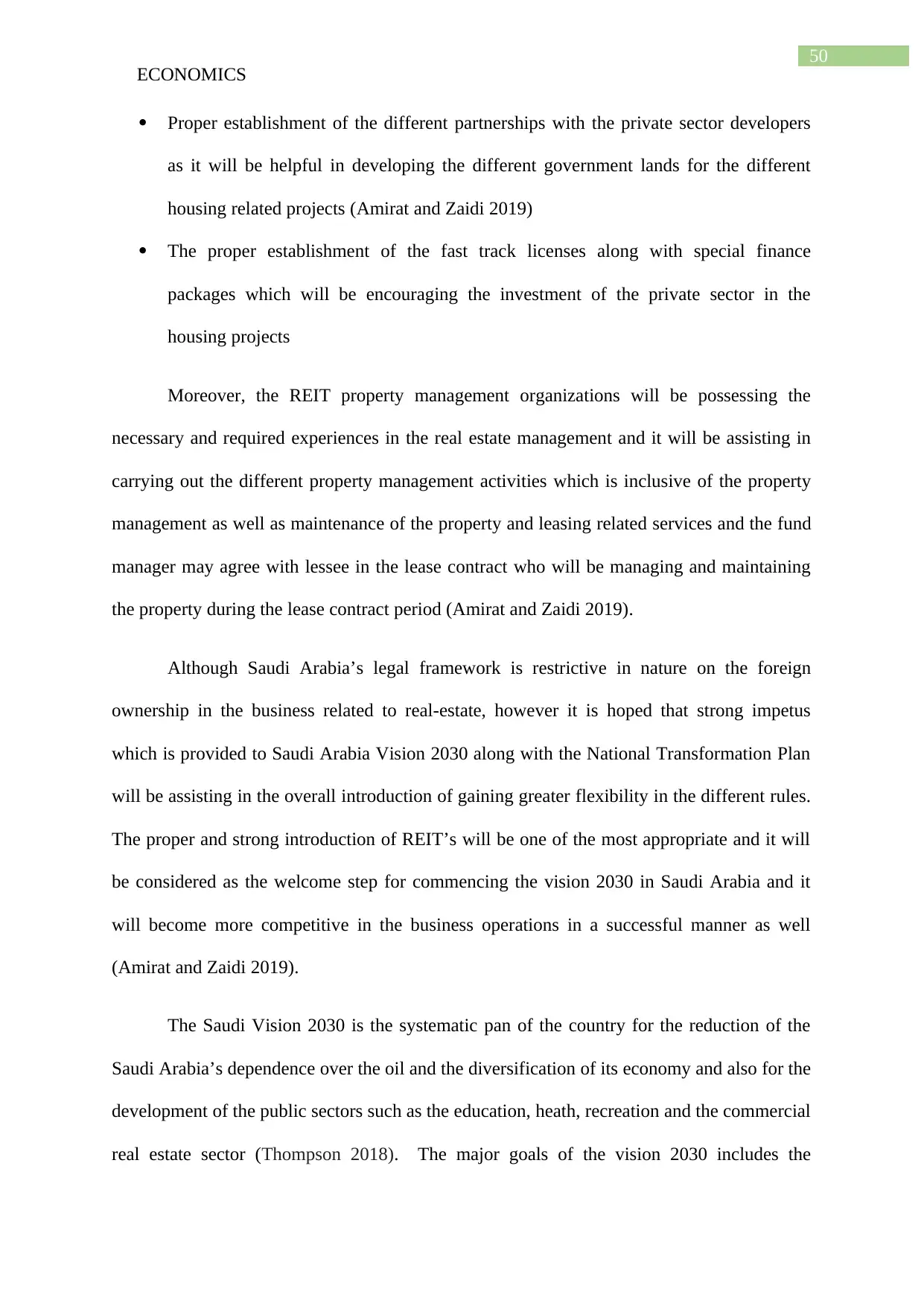
50
ECONOMICS
Proper establishment of the different partnerships with the private sector developers
as it will be helpful in developing the different government lands for the different
housing related projects (Amirat and Zaidi 2019)
The proper establishment of the fast track licenses along with special finance
packages which will be encouraging the investment of the private sector in the
housing projects
Moreover, the REIT property management organizations will be possessing the
necessary and required experiences in the real estate management and it will be assisting in
carrying out the different property management activities which is inclusive of the property
management as well as maintenance of the property and leasing related services and the fund
manager may agree with lessee in the lease contract who will be managing and maintaining
the property during the lease contract period (Amirat and Zaidi 2019).
Although Saudi Arabia’s legal framework is restrictive in nature on the foreign
ownership in the business related to real-estate, however it is hoped that strong impetus
which is provided to Saudi Arabia Vision 2030 along with the National Transformation Plan
will be assisting in the overall introduction of gaining greater flexibility in the different rules.
The proper and strong introduction of REIT’s will be one of the most appropriate and it will
be considered as the welcome step for commencing the vision 2030 in Saudi Arabia and it
will become more competitive in the business operations in a successful manner as well
(Amirat and Zaidi 2019).
The Saudi Vision 2030 is the systematic pan of the country for the reduction of the
Saudi Arabia’s dependence over the oil and the diversification of its economy and also for the
development of the public sectors such as the education, heath, recreation and the commercial
real estate sector (Thompson 2018). The major goals of the vision 2030 includes the
ECONOMICS
Proper establishment of the different partnerships with the private sector developers
as it will be helpful in developing the different government lands for the different
housing related projects (Amirat and Zaidi 2019)
The proper establishment of the fast track licenses along with special finance
packages which will be encouraging the investment of the private sector in the
housing projects
Moreover, the REIT property management organizations will be possessing the
necessary and required experiences in the real estate management and it will be assisting in
carrying out the different property management activities which is inclusive of the property
management as well as maintenance of the property and leasing related services and the fund
manager may agree with lessee in the lease contract who will be managing and maintaining
the property during the lease contract period (Amirat and Zaidi 2019).
Although Saudi Arabia’s legal framework is restrictive in nature on the foreign
ownership in the business related to real-estate, however it is hoped that strong impetus
which is provided to Saudi Arabia Vision 2030 along with the National Transformation Plan
will be assisting in the overall introduction of gaining greater flexibility in the different rules.
The proper and strong introduction of REIT’s will be one of the most appropriate and it will
be considered as the welcome step for commencing the vision 2030 in Saudi Arabia and it
will become more competitive in the business operations in a successful manner as well
(Amirat and Zaidi 2019).
The Saudi Vision 2030 is the systematic pan of the country for the reduction of the
Saudi Arabia’s dependence over the oil and the diversification of its economy and also for the
development of the public sectors such as the education, heath, recreation and the commercial
real estate sector (Thompson 2018). The major goals of the vision 2030 includes the

51
ECONOMICS
reinforcement of the investments and the economic activities together with the increase of the
non-oil industry trade among the countries through the means of the consumer products and
the goods. The chapter highlights the major factors that has been gathered from the various
research studies, online journals, books and the government publications as the secondary
data resource on the impact of 2030 vision on the commercial real estate sector in Saudi
Arabia.
In respond to the need of this plan towards the economic diversification in Saudi
Arabia, the findings of the study justifies in many of the ways regarding the expected rise in
the demand for the housing real estate in the country within the upcoming years. The findings
of the research gave a great insight regarding the current market condition of the country
(Juan, Meng and Shaobiao 2018). It is anticipated from the research study that there will be a
significant increase in the interest among the investors and the home buyers for the aim of
capitalizing on the attractive price options, the payment related plans and the discounts from
the wide spectrum of the products of the real estate that suits their budget.
Furthermore the findings suggest that within the residential property price segment,
the expectation lies towards the decrease in the market for the prices (Thompson 2017). This
is because more than 605 of the research survey data from the resources reported of expecting
a substantial decrease in the rental process and the sales of the residential properties in the
country within the upcoming year.
In accordance to the preference of the location as per the findings, it can be stated that
the importance of the location is one of the essential factors that has been found. The findings
of the assignment furthermore reveled that more than 52.45% of the population consider their
ideal residential property to be in the location of the city centre or down town (Hvidt 2019).
ECONOMICS
reinforcement of the investments and the economic activities together with the increase of the
non-oil industry trade among the countries through the means of the consumer products and
the goods. The chapter highlights the major factors that has been gathered from the various
research studies, online journals, books and the government publications as the secondary
data resource on the impact of 2030 vision on the commercial real estate sector in Saudi
Arabia.
In respond to the need of this plan towards the economic diversification in Saudi
Arabia, the findings of the study justifies in many of the ways regarding the expected rise in
the demand for the housing real estate in the country within the upcoming years. The findings
of the research gave a great insight regarding the current market condition of the country
(Juan, Meng and Shaobiao 2018). It is anticipated from the research study that there will be a
significant increase in the interest among the investors and the home buyers for the aim of
capitalizing on the attractive price options, the payment related plans and the discounts from
the wide spectrum of the products of the real estate that suits their budget.
Furthermore the findings suggest that within the residential property price segment,
the expectation lies towards the decrease in the market for the prices (Thompson 2017). This
is because more than 605 of the research survey data from the resources reported of expecting
a substantial decrease in the rental process and the sales of the residential properties in the
country within the upcoming year.
In accordance to the preference of the location as per the findings, it can be stated that
the importance of the location is one of the essential factors that has been found. The findings
of the assignment furthermore reveled that more than 52.45% of the population consider their
ideal residential property to be in the location of the city centre or down town (Hvidt 2019).
Secure Best Marks with AI Grader
Need help grading? Try our AI Grader for instant feedback on your assignments.
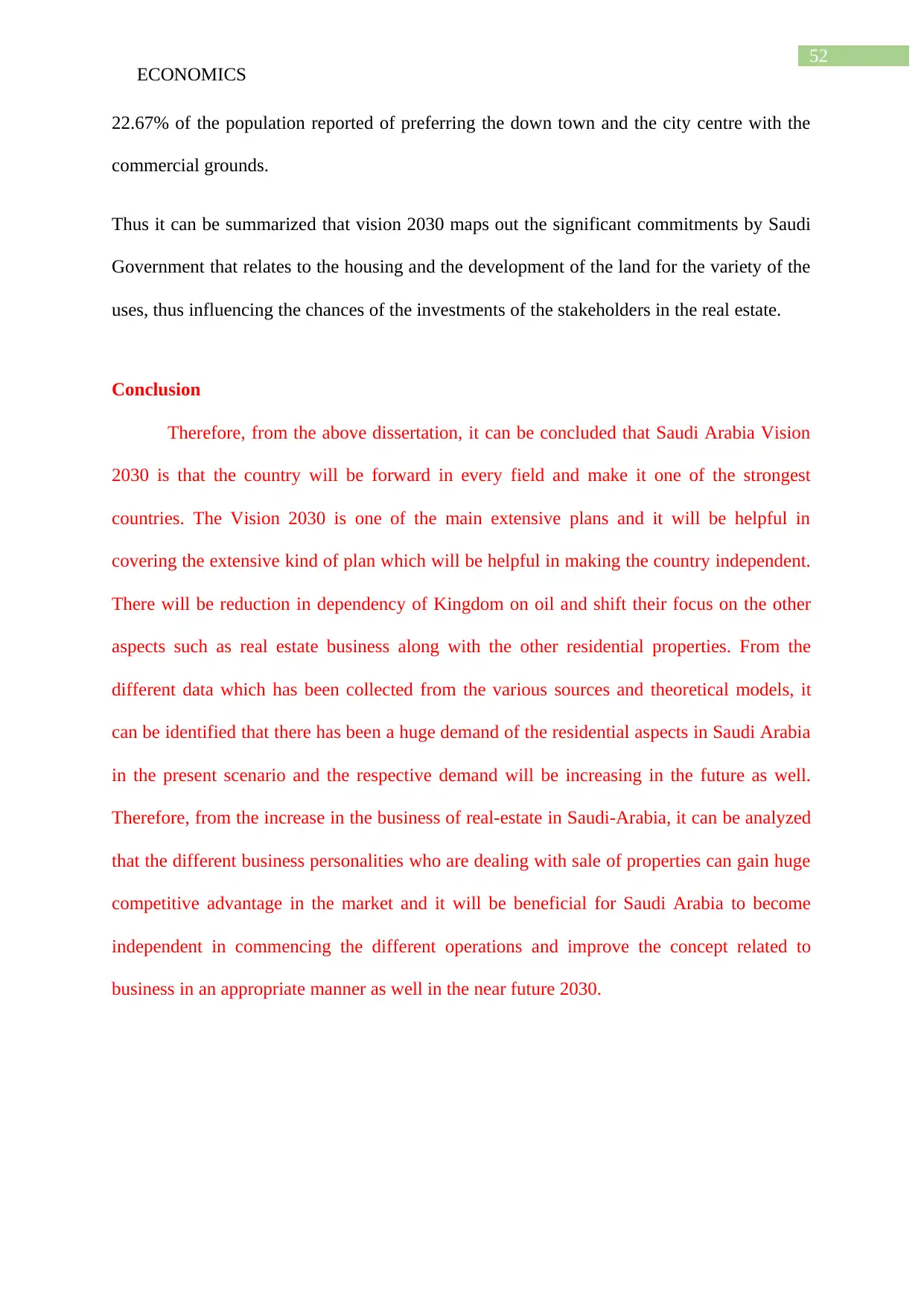
52
ECONOMICS
22.67% of the population reported of preferring the down town and the city centre with the
commercial grounds.
Thus it can be summarized that vision 2030 maps out the significant commitments by Saudi
Government that relates to the housing and the development of the land for the variety of the
uses, thus influencing the chances of the investments of the stakeholders in the real estate.
Conclusion
Therefore, from the above dissertation, it can be concluded that Saudi Arabia Vision
2030 is that the country will be forward in every field and make it one of the strongest
countries. The Vision 2030 is one of the main extensive plans and it will be helpful in
covering the extensive kind of plan which will be helpful in making the country independent.
There will be reduction in dependency of Kingdom on oil and shift their focus on the other
aspects such as real estate business along with the other residential properties. From the
different data which has been collected from the various sources and theoretical models, it
can be identified that there has been a huge demand of the residential aspects in Saudi Arabia
in the present scenario and the respective demand will be increasing in the future as well.
Therefore, from the increase in the business of real-estate in Saudi-Arabia, it can be analyzed
that the different business personalities who are dealing with sale of properties can gain huge
competitive advantage in the market and it will be beneficial for Saudi Arabia to become
independent in commencing the different operations and improve the concept related to
business in an appropriate manner as well in the near future 2030.
ECONOMICS
22.67% of the population reported of preferring the down town and the city centre with the
commercial grounds.
Thus it can be summarized that vision 2030 maps out the significant commitments by Saudi
Government that relates to the housing and the development of the land for the variety of the
uses, thus influencing the chances of the investments of the stakeholders in the real estate.
Conclusion
Therefore, from the above dissertation, it can be concluded that Saudi Arabia Vision
2030 is that the country will be forward in every field and make it one of the strongest
countries. The Vision 2030 is one of the main extensive plans and it will be helpful in
covering the extensive kind of plan which will be helpful in making the country independent.
There will be reduction in dependency of Kingdom on oil and shift their focus on the other
aspects such as real estate business along with the other residential properties. From the
different data which has been collected from the various sources and theoretical models, it
can be identified that there has been a huge demand of the residential aspects in Saudi Arabia
in the present scenario and the respective demand will be increasing in the future as well.
Therefore, from the increase in the business of real-estate in Saudi-Arabia, it can be analyzed
that the different business personalities who are dealing with sale of properties can gain huge
competitive advantage in the market and it will be beneficial for Saudi Arabia to become
independent in commencing the different operations and improve the concept related to
business in an appropriate manner as well in the near future 2030.
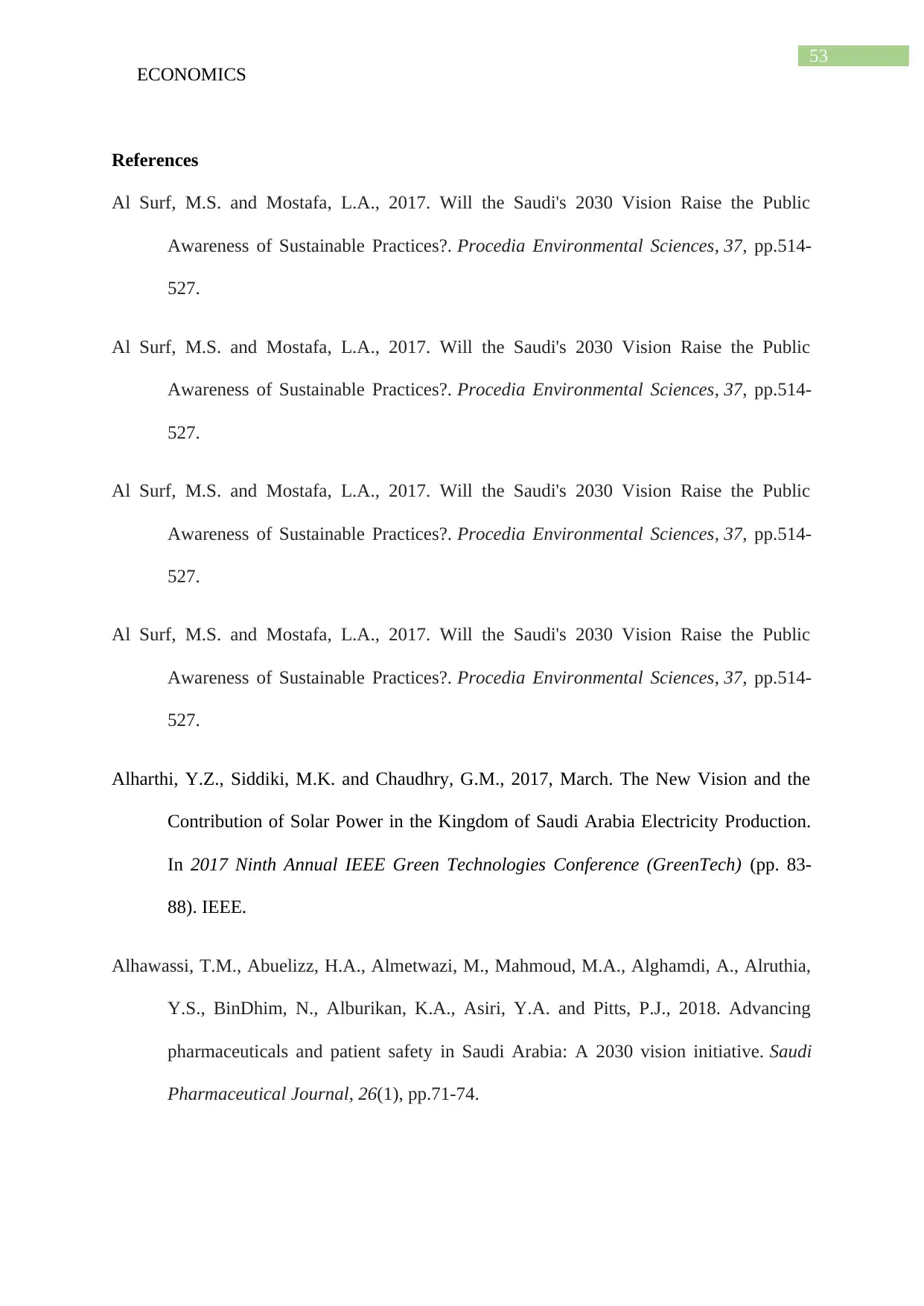
53
ECONOMICS
References
Al Surf, M.S. and Mostafa, L.A., 2017. Will the Saudi's 2030 Vision Raise the Public
Awareness of Sustainable Practices?. Procedia Environmental Sciences, 37, pp.514-
527.
Al Surf, M.S. and Mostafa, L.A., 2017. Will the Saudi's 2030 Vision Raise the Public
Awareness of Sustainable Practices?. Procedia Environmental Sciences, 37, pp.514-
527.
Al Surf, M.S. and Mostafa, L.A., 2017. Will the Saudi's 2030 Vision Raise the Public
Awareness of Sustainable Practices?. Procedia Environmental Sciences, 37, pp.514-
527.
Al Surf, M.S. and Mostafa, L.A., 2017. Will the Saudi's 2030 Vision Raise the Public
Awareness of Sustainable Practices?. Procedia Environmental Sciences, 37, pp.514-
527.
Alharthi, Y.Z., Siddiki, M.K. and Chaudhry, G.M., 2017, March. The New Vision and the
Contribution of Solar Power in the Kingdom of Saudi Arabia Electricity Production.
In 2017 Ninth Annual IEEE Green Technologies Conference (GreenTech) (pp. 83-
88). IEEE.
Alhawassi, T.M., Abuelizz, H.A., Almetwazi, M., Mahmoud, M.A., Alghamdi, A., Alruthia,
Y.S., BinDhim, N., Alburikan, K.A., Asiri, Y.A. and Pitts, P.J., 2018. Advancing
pharmaceuticals and patient safety in Saudi Arabia: A 2030 vision initiative. Saudi
Pharmaceutical Journal, 26(1), pp.71-74.
ECONOMICS
References
Al Surf, M.S. and Mostafa, L.A., 2017. Will the Saudi's 2030 Vision Raise the Public
Awareness of Sustainable Practices?. Procedia Environmental Sciences, 37, pp.514-
527.
Al Surf, M.S. and Mostafa, L.A., 2017. Will the Saudi's 2030 Vision Raise the Public
Awareness of Sustainable Practices?. Procedia Environmental Sciences, 37, pp.514-
527.
Al Surf, M.S. and Mostafa, L.A., 2017. Will the Saudi's 2030 Vision Raise the Public
Awareness of Sustainable Practices?. Procedia Environmental Sciences, 37, pp.514-
527.
Al Surf, M.S. and Mostafa, L.A., 2017. Will the Saudi's 2030 Vision Raise the Public
Awareness of Sustainable Practices?. Procedia Environmental Sciences, 37, pp.514-
527.
Alharthi, Y.Z., Siddiki, M.K. and Chaudhry, G.M., 2017, March. The New Vision and the
Contribution of Solar Power in the Kingdom of Saudi Arabia Electricity Production.
In 2017 Ninth Annual IEEE Green Technologies Conference (GreenTech) (pp. 83-
88). IEEE.
Alhawassi, T.M., Abuelizz, H.A., Almetwazi, M., Mahmoud, M.A., Alghamdi, A., Alruthia,
Y.S., BinDhim, N., Alburikan, K.A., Asiri, Y.A. and Pitts, P.J., 2018. Advancing
pharmaceuticals and patient safety in Saudi Arabia: A 2030 vision initiative. Saudi
Pharmaceutical Journal, 26(1), pp.71-74.
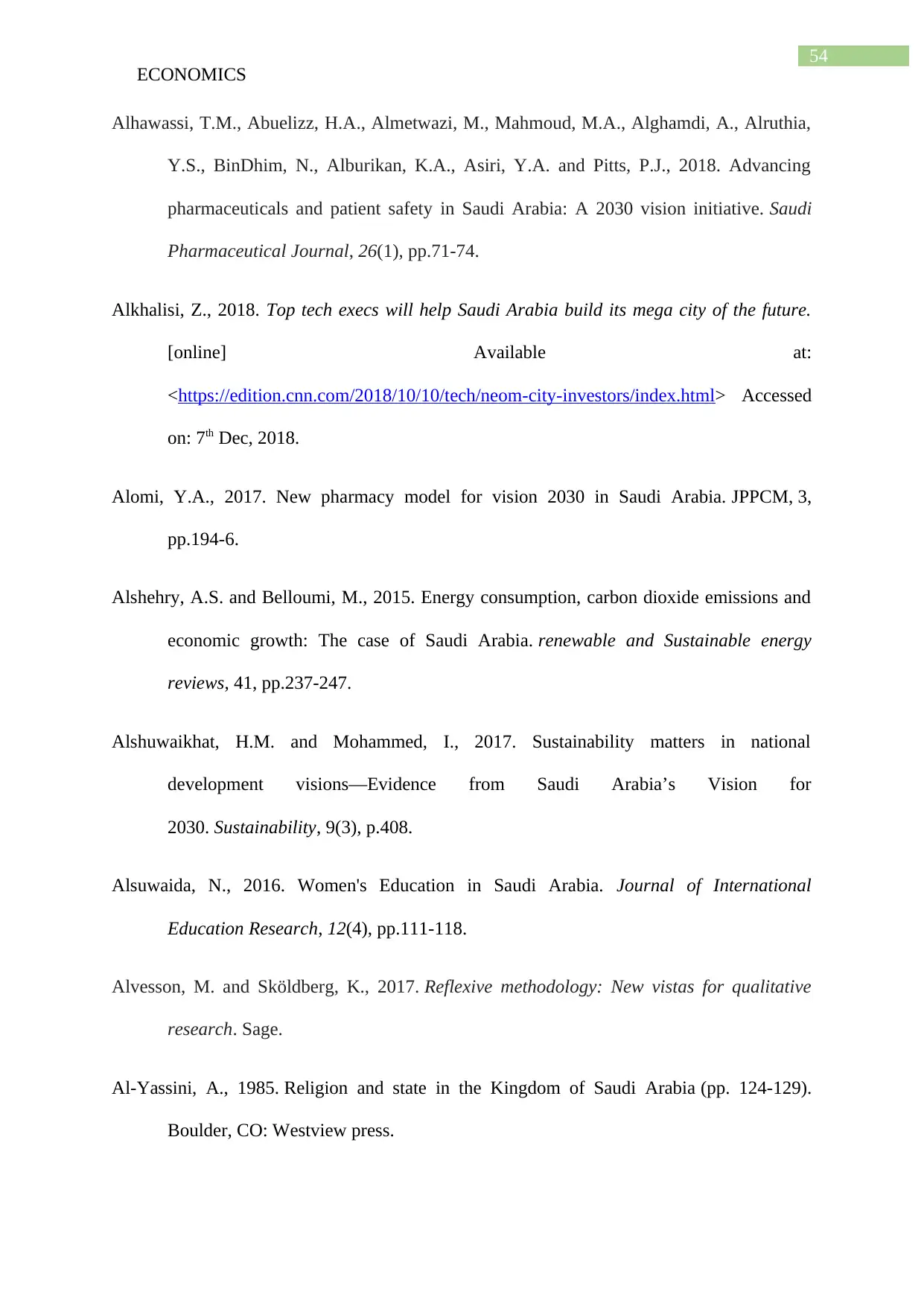
54
ECONOMICS
Alhawassi, T.M., Abuelizz, H.A., Almetwazi, M., Mahmoud, M.A., Alghamdi, A., Alruthia,
Y.S., BinDhim, N., Alburikan, K.A., Asiri, Y.A. and Pitts, P.J., 2018. Advancing
pharmaceuticals and patient safety in Saudi Arabia: A 2030 vision initiative. Saudi
Pharmaceutical Journal, 26(1), pp.71-74.
Alkhalisi, Z., 2018. Top tech execs will help Saudi Arabia build its mega city of the future.
[online] Available at:
<https://edition.cnn.com/2018/10/10/tech/neom-city-investors/index.html> Accessed
on: 7th Dec, 2018.
Alomi, Y.A., 2017. New pharmacy model for vision 2030 in Saudi Arabia. JPPCM, 3,
pp.194-6.
Alshehry, A.S. and Belloumi, M., 2015. Energy consumption, carbon dioxide emissions and
economic growth: The case of Saudi Arabia. renewable and Sustainable energy
reviews, 41, pp.237-247.
Alshuwaikhat, H.M. and Mohammed, I., 2017. Sustainability matters in national
development visions—Evidence from Saudi Arabia’s Vision for
2030. Sustainability, 9(3), p.408.
Alsuwaida, N., 2016. Women's Education in Saudi Arabia. Journal of International
Education Research, 12(4), pp.111-118.
Alvesson, M. and Sköldberg, K., 2017. Reflexive methodology: New vistas for qualitative
research. Sage.
Al-Yassini, A., 1985. Religion and state in the Kingdom of Saudi Arabia (pp. 124-129).
Boulder, CO: Westview press.
ECONOMICS
Alhawassi, T.M., Abuelizz, H.A., Almetwazi, M., Mahmoud, M.A., Alghamdi, A., Alruthia,
Y.S., BinDhim, N., Alburikan, K.A., Asiri, Y.A. and Pitts, P.J., 2018. Advancing
pharmaceuticals and patient safety in Saudi Arabia: A 2030 vision initiative. Saudi
Pharmaceutical Journal, 26(1), pp.71-74.
Alkhalisi, Z., 2018. Top tech execs will help Saudi Arabia build its mega city of the future.
[online] Available at:
<https://edition.cnn.com/2018/10/10/tech/neom-city-investors/index.html> Accessed
on: 7th Dec, 2018.
Alomi, Y.A., 2017. New pharmacy model for vision 2030 in Saudi Arabia. JPPCM, 3,
pp.194-6.
Alshehry, A.S. and Belloumi, M., 2015. Energy consumption, carbon dioxide emissions and
economic growth: The case of Saudi Arabia. renewable and Sustainable energy
reviews, 41, pp.237-247.
Alshuwaikhat, H.M. and Mohammed, I., 2017. Sustainability matters in national
development visions—Evidence from Saudi Arabia’s Vision for
2030. Sustainability, 9(3), p.408.
Alsuwaida, N., 2016. Women's Education in Saudi Arabia. Journal of International
Education Research, 12(4), pp.111-118.
Alvesson, M. and Sköldberg, K., 2017. Reflexive methodology: New vistas for qualitative
research. Sage.
Al-Yassini, A., 1985. Religion and state in the Kingdom of Saudi Arabia (pp. 124-129).
Boulder, CO: Westview press.
Paraphrase This Document
Need a fresh take? Get an instant paraphrase of this document with our AI Paraphraser
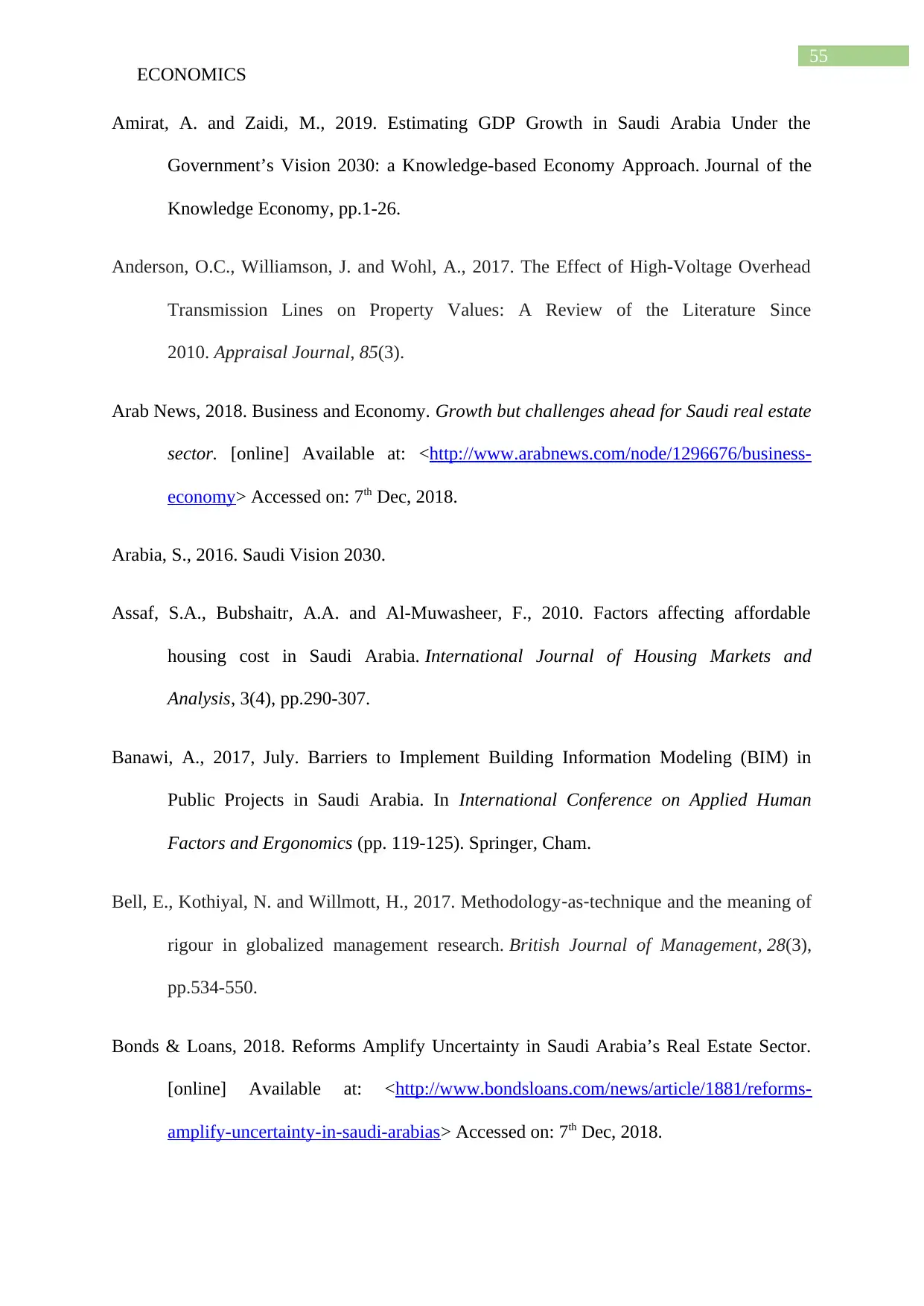
55
ECONOMICS
Amirat, A. and Zaidi, M., 2019. Estimating GDP Growth in Saudi Arabia Under the
Government’s Vision 2030: a Knowledge-based Economy Approach. Journal of the
Knowledge Economy, pp.1-26.
Anderson, O.C., Williamson, J. and Wohl, A., 2017. The Effect of High-Voltage Overhead
Transmission Lines on Property Values: A Review of the Literature Since
2010. Appraisal Journal, 85(3).
Arab News, 2018. Business and Economy. Growth but challenges ahead for Saudi real estate
sector. [online] Available at: <http://www.arabnews.com/node/1296676/business-
economy> Accessed on: 7th Dec, 2018.
Arabia, S., 2016. Saudi Vision 2030.
Assaf, S.A., Bubshaitr, A.A. and Al-Muwasheer, F., 2010. Factors affecting affordable
housing cost in Saudi Arabia. International Journal of Housing Markets and
Analysis, 3(4), pp.290-307.
Banawi, A., 2017, July. Barriers to Implement Building Information Modeling (BIM) in
Public Projects in Saudi Arabia. In International Conference on Applied Human
Factors and Ergonomics (pp. 119-125). Springer, Cham.
Bell, E., Kothiyal, N. and Willmott, H., 2017. Methodology‐as‐technique and the meaning of
rigour in globalized management research. British Journal of Management, 28(3),
pp.534-550.
Bonds & Loans, 2018. Reforms Amplify Uncertainty in Saudi Arabia’s Real Estate Sector.
[online] Available at: <http://www.bondsloans.com/news/article/1881/reforms-
amplify-uncertainty-in-saudi-arabias> Accessed on: 7th Dec, 2018.
ECONOMICS
Amirat, A. and Zaidi, M., 2019. Estimating GDP Growth in Saudi Arabia Under the
Government’s Vision 2030: a Knowledge-based Economy Approach. Journal of the
Knowledge Economy, pp.1-26.
Anderson, O.C., Williamson, J. and Wohl, A., 2017. The Effect of High-Voltage Overhead
Transmission Lines on Property Values: A Review of the Literature Since
2010. Appraisal Journal, 85(3).
Arab News, 2018. Business and Economy. Growth but challenges ahead for Saudi real estate
sector. [online] Available at: <http://www.arabnews.com/node/1296676/business-
economy> Accessed on: 7th Dec, 2018.
Arabia, S., 2016. Saudi Vision 2030.
Assaf, S.A., Bubshaitr, A.A. and Al-Muwasheer, F., 2010. Factors affecting affordable
housing cost in Saudi Arabia. International Journal of Housing Markets and
Analysis, 3(4), pp.290-307.
Banawi, A., 2017, July. Barriers to Implement Building Information Modeling (BIM) in
Public Projects in Saudi Arabia. In International Conference on Applied Human
Factors and Ergonomics (pp. 119-125). Springer, Cham.
Bell, E., Kothiyal, N. and Willmott, H., 2017. Methodology‐as‐technique and the meaning of
rigour in globalized management research. British Journal of Management, 28(3),
pp.534-550.
Bonds & Loans, 2018. Reforms Amplify Uncertainty in Saudi Arabia’s Real Estate Sector.
[online] Available at: <http://www.bondsloans.com/news/article/1881/reforms-
amplify-uncertainty-in-saudi-arabias> Accessed on: 7th Dec, 2018.
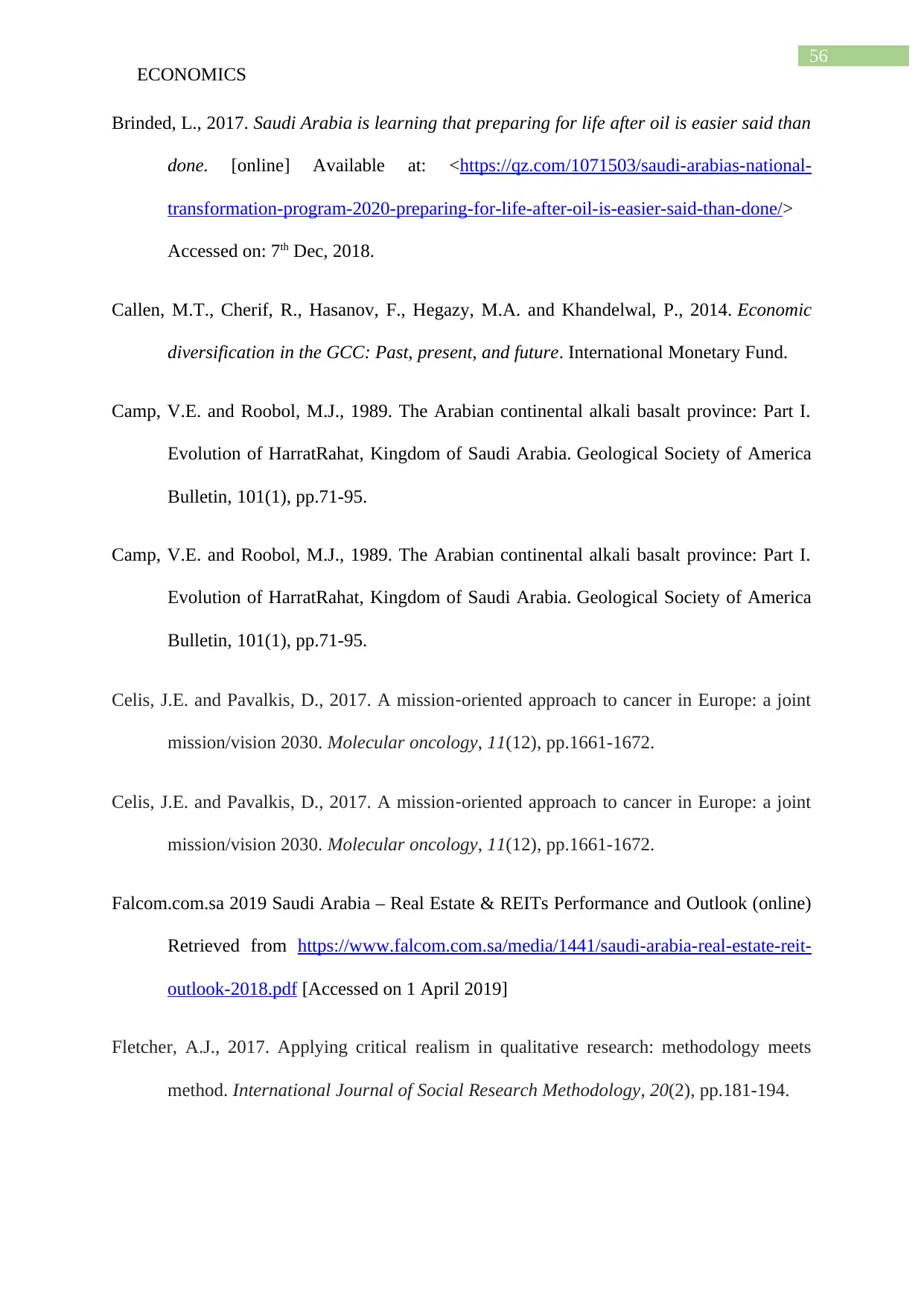
56
ECONOMICS
Brinded, L., 2017. Saudi Arabia is learning that preparing for life after oil is easier said than
done. [online] Available at: <https://qz.com/1071503/saudi-arabias-national-
transformation-program-2020-preparing-for-life-after-oil-is-easier-said-than-done/>
Accessed on: 7th Dec, 2018.
Callen, M.T., Cherif, R., Hasanov, F., Hegazy, M.A. and Khandelwal, P., 2014. Economic
diversification in the GCC: Past, present, and future. International Monetary Fund.
Camp, V.E. and Roobol, M.J., 1989. The Arabian continental alkali basalt province: Part I.
Evolution of HarratRahat, Kingdom of Saudi Arabia. Geological Society of America
Bulletin, 101(1), pp.71-95.
Camp, V.E. and Roobol, M.J., 1989. The Arabian continental alkali basalt province: Part I.
Evolution of HarratRahat, Kingdom of Saudi Arabia. Geological Society of America
Bulletin, 101(1), pp.71-95.
Celis, J.E. and Pavalkis, D., 2017. A mission‐oriented approach to cancer in Europe: a joint
mission/vision 2030. Molecular oncology, 11(12), pp.1661-1672.
Celis, J.E. and Pavalkis, D., 2017. A mission‐oriented approach to cancer in Europe: a joint
mission/vision 2030. Molecular oncology, 11(12), pp.1661-1672.
Falcom.com.sa 2019 Saudi Arabia – Real Estate & REITs Performance and Outlook (online)
Retrieved from https://www.falcom.com.sa/media/1441/saudi-arabia-real-estate-reit-
outlook-2018.pdf [Accessed on 1 April 2019]
Fletcher, A.J., 2017. Applying critical realism in qualitative research: methodology meets
method. International Journal of Social Research Methodology, 20(2), pp.181-194.
ECONOMICS
Brinded, L., 2017. Saudi Arabia is learning that preparing for life after oil is easier said than
done. [online] Available at: <https://qz.com/1071503/saudi-arabias-national-
transformation-program-2020-preparing-for-life-after-oil-is-easier-said-than-done/>
Accessed on: 7th Dec, 2018.
Callen, M.T., Cherif, R., Hasanov, F., Hegazy, M.A. and Khandelwal, P., 2014. Economic
diversification in the GCC: Past, present, and future. International Monetary Fund.
Camp, V.E. and Roobol, M.J., 1989. The Arabian continental alkali basalt province: Part I.
Evolution of HarratRahat, Kingdom of Saudi Arabia. Geological Society of America
Bulletin, 101(1), pp.71-95.
Camp, V.E. and Roobol, M.J., 1989. The Arabian continental alkali basalt province: Part I.
Evolution of HarratRahat, Kingdom of Saudi Arabia. Geological Society of America
Bulletin, 101(1), pp.71-95.
Celis, J.E. and Pavalkis, D., 2017. A mission‐oriented approach to cancer in Europe: a joint
mission/vision 2030. Molecular oncology, 11(12), pp.1661-1672.
Celis, J.E. and Pavalkis, D., 2017. A mission‐oriented approach to cancer in Europe: a joint
mission/vision 2030. Molecular oncology, 11(12), pp.1661-1672.
Falcom.com.sa 2019 Saudi Arabia – Real Estate & REITs Performance and Outlook (online)
Retrieved from https://www.falcom.com.sa/media/1441/saudi-arabia-real-estate-reit-
outlook-2018.pdf [Accessed on 1 April 2019]
Fletcher, A.J., 2017. Applying critical realism in qualitative research: methodology meets
method. International Journal of Social Research Methodology, 20(2), pp.181-194.

57
ECONOMICS
Foley, S., 2017. When Oil Is Not Enough: Sino-Saudi Relations and Vision 2030.Asian
Journal of Middle Eastern and Islamic Studies, 11(1), pp.107-120.
Gazzeh, K. and Abubakar, I.R., 2018. Regional disparity in access to basic public services in
Saudi Arabia: A sustainability challenge. Utilities Policy, 52, pp.70-80.
Gelil, I., Howarth, N. and Lanza, A., 2017. Growth, investment and the low carbon transition:
A view from Saudi Arabia. KAPSARC Discussion Paper.
Horschig, D., 2016. Economic Diversification in Saudi Arabia. Journal of Political Inquiry|
Fall, p.1.
Hvidt, M., 2019. Development Plans and Visions in the Arab Gulf countries. What is the
likelihood that they will be implemented?. Videncenter Om Det ModerneMellem¯
sten.
Juan, C., Meng, S. and Shaobiao, W., 2018. Aligning China’s Belt and Road Initiative with
Saudi Arabia’s 2030 Vision: Opportunities and Challenges. China Quarterly of
International Strategic Studies, 4(03), pp.1-17.
Kane, F., 2018. Growth but challenges ahead for Saudi real estate sector. [online] Available
at: <http://www.arabnews.com/node/1296676/business-economy> Accessed on: 7th
Dec, 2018.
Khan, M., 2016. Saudi Arabia's Vision 2030. Defence Journal, 119(11), pp.36-42.
Khashan, H., 2017. Saudi Arabia's Flawed" Vision 2030". Middle East Quarterly.
Kiani, A., 2017. Coupling effects of demand-side improvements ensemble on energy
performance to monetary implications for UAE economy. Journal of Cleaner
Production, 167, pp.44-54.
ECONOMICS
Foley, S., 2017. When Oil Is Not Enough: Sino-Saudi Relations and Vision 2030.Asian
Journal of Middle Eastern and Islamic Studies, 11(1), pp.107-120.
Gazzeh, K. and Abubakar, I.R., 2018. Regional disparity in access to basic public services in
Saudi Arabia: A sustainability challenge. Utilities Policy, 52, pp.70-80.
Gelil, I., Howarth, N. and Lanza, A., 2017. Growth, investment and the low carbon transition:
A view from Saudi Arabia. KAPSARC Discussion Paper.
Horschig, D., 2016. Economic Diversification in Saudi Arabia. Journal of Political Inquiry|
Fall, p.1.
Hvidt, M., 2019. Development Plans and Visions in the Arab Gulf countries. What is the
likelihood that they will be implemented?. Videncenter Om Det ModerneMellem¯
sten.
Juan, C., Meng, S. and Shaobiao, W., 2018. Aligning China’s Belt and Road Initiative with
Saudi Arabia’s 2030 Vision: Opportunities and Challenges. China Quarterly of
International Strategic Studies, 4(03), pp.1-17.
Kane, F., 2018. Growth but challenges ahead for Saudi real estate sector. [online] Available
at: <http://www.arabnews.com/node/1296676/business-economy> Accessed on: 7th
Dec, 2018.
Khan, M., 2016. Saudi Arabia's Vision 2030. Defence Journal, 119(11), pp.36-42.
Khashan, H., 2017. Saudi Arabia's Flawed" Vision 2030". Middle East Quarterly.
Kiani, A., 2017. Coupling effects of demand-side improvements ensemble on energy
performance to monetary implications for UAE economy. Journal of Cleaner
Production, 167, pp.44-54.
Secure Best Marks with AI Grader
Need help grading? Try our AI Grader for instant feedback on your assignments.

58
ECONOMICS
Kiani, A., 2017. Coupling effects of demand-side improvements ensemble on energy
performance to monetary implications for UAE economy. Journal of Cleaner
Production, 167, pp.44-54.
Kumar, R., 2019. Research methodology: A step-by-step guide for beginners. Sage
Publications Limited.
Ledford, J.R. and Gast, D.L., 2018. Single case research methodology: Applications in
special education and behavioral sciences. Routledge.
Long, D.E. and Maisel, S., 1997. The Kingdom of Saudi Arabia. Gainesville, FL: University
Press of Florida.
Mackey, A. and Gass, S.M., 2015. Second language research: Methodology and design.
Routledge.
Memish, Z.A., 2018. MERS: What is the current situation in Saudi Arabia?. Journal of travel
medicine, 25(1), p.tay065.
Mishra, A. and Kauškale, L., 2017. Comparative Analysis of Sustainable Real Estate Market
Development in Two Northern Capitals: Case of Riga, Latvia and Stockholm,
Sweden. Baltic Journal of Real Estate Economics and Construction
Management, 5(1), pp.186-200.
Mitchell, B. and Alfuraih, A., 2018. The Kingdom of Saudi Arabia: Achieving the
Aspirations of the National Transformation Program 2020 and Saudi Vision 2030
Through Education. Journal of Education and Development, 2(3), p.36.
ECONOMICS
Kiani, A., 2017. Coupling effects of demand-side improvements ensemble on energy
performance to monetary implications for UAE economy. Journal of Cleaner
Production, 167, pp.44-54.
Kumar, R., 2019. Research methodology: A step-by-step guide for beginners. Sage
Publications Limited.
Ledford, J.R. and Gast, D.L., 2018. Single case research methodology: Applications in
special education and behavioral sciences. Routledge.
Long, D.E. and Maisel, S., 1997. The Kingdom of Saudi Arabia. Gainesville, FL: University
Press of Florida.
Mackey, A. and Gass, S.M., 2015. Second language research: Methodology and design.
Routledge.
Memish, Z.A., 2018. MERS: What is the current situation in Saudi Arabia?. Journal of travel
medicine, 25(1), p.tay065.
Mishra, A. and Kauškale, L., 2017. Comparative Analysis of Sustainable Real Estate Market
Development in Two Northern Capitals: Case of Riga, Latvia and Stockholm,
Sweden. Baltic Journal of Real Estate Economics and Construction
Management, 5(1), pp.186-200.
Mitchell, B. and Alfuraih, A., 2018. The Kingdom of Saudi Arabia: Achieving the
Aspirations of the National Transformation Program 2020 and Saudi Vision 2030
Through Education. Journal of Education and Development, 2(3), p.36.

59
ECONOMICS
Mu’azu, N.D., Blaisi, N.I., Naji, A.A., Abdel-Magid, I.M. and AlQahtany, A., 2018. Food
waste management current practices and sustainable future approaches: a Saudi
Arabian perspectives. Journal of Material Cycles and Waste Management, pp.1-13.
Nurunnabi, M., 2017. Transformation from an oil-based economy to a knowledge-based
economy in Saudi Arabia: the direction of Saudi vision 2030. Journal of the
Knowledge Economy, 8(2), pp.536-564.
Ouda, O.K., Rehan, M., Nader, N. and Nizami, A.S., 2017. Environmental and economic
benefits of recovered paper: A case study of saudiarabia. Energy Procedia, 142,
pp.3753-3758.
Park, M.A., Krakos, J.A., Michal, T., Loseille, A. and Alonso, J.J., 2016. Unstructured grid
adaptation: Status, potential impacts, and recommended investments toward CFD
Vision 2030.
Quinlan, C., Babin, B., Carr, J. and Griffin, M., 2019. Business research methods. South
Western Cengage.
Ramady, M.A., 2010. The Saudi Arabian economy: Policies, achievements, and challenges.
Springer Science & Business Media.
Reardon, J., 2016. Saudi Vision 2030: What Does It Mean for Your Industry?[online]
Available at: <https://www.tamimi.com/law-update-articles/saudi-vision-2030-what-
does-it-mean-for-your-industry/> Accessed on: 7th Dec, 2018.
Reilly, T.M. and Jones III, R., 2017. Mixed methodology in family business research: Past
accomplishments and perspectives for the future. Journal of family business
strategy, 8(3), pp.185-195.
ECONOMICS
Mu’azu, N.D., Blaisi, N.I., Naji, A.A., Abdel-Magid, I.M. and AlQahtany, A., 2018. Food
waste management current practices and sustainable future approaches: a Saudi
Arabian perspectives. Journal of Material Cycles and Waste Management, pp.1-13.
Nurunnabi, M., 2017. Transformation from an oil-based economy to a knowledge-based
economy in Saudi Arabia: the direction of Saudi vision 2030. Journal of the
Knowledge Economy, 8(2), pp.536-564.
Ouda, O.K., Rehan, M., Nader, N. and Nizami, A.S., 2017. Environmental and economic
benefits of recovered paper: A case study of saudiarabia. Energy Procedia, 142,
pp.3753-3758.
Park, M.A., Krakos, J.A., Michal, T., Loseille, A. and Alonso, J.J., 2016. Unstructured grid
adaptation: Status, potential impacts, and recommended investments toward CFD
Vision 2030.
Quinlan, C., Babin, B., Carr, J. and Griffin, M., 2019. Business research methods. South
Western Cengage.
Ramady, M.A., 2010. The Saudi Arabian economy: Policies, achievements, and challenges.
Springer Science & Business Media.
Reardon, J., 2016. Saudi Vision 2030: What Does It Mean for Your Industry?[online]
Available at: <https://www.tamimi.com/law-update-articles/saudi-vision-2030-what-
does-it-mean-for-your-industry/> Accessed on: 7th Dec, 2018.
Reilly, T.M. and Jones III, R., 2017. Mixed methodology in family business research: Past
accomplishments and perspectives for the future. Journal of family business
strategy, 8(3), pp.185-195.
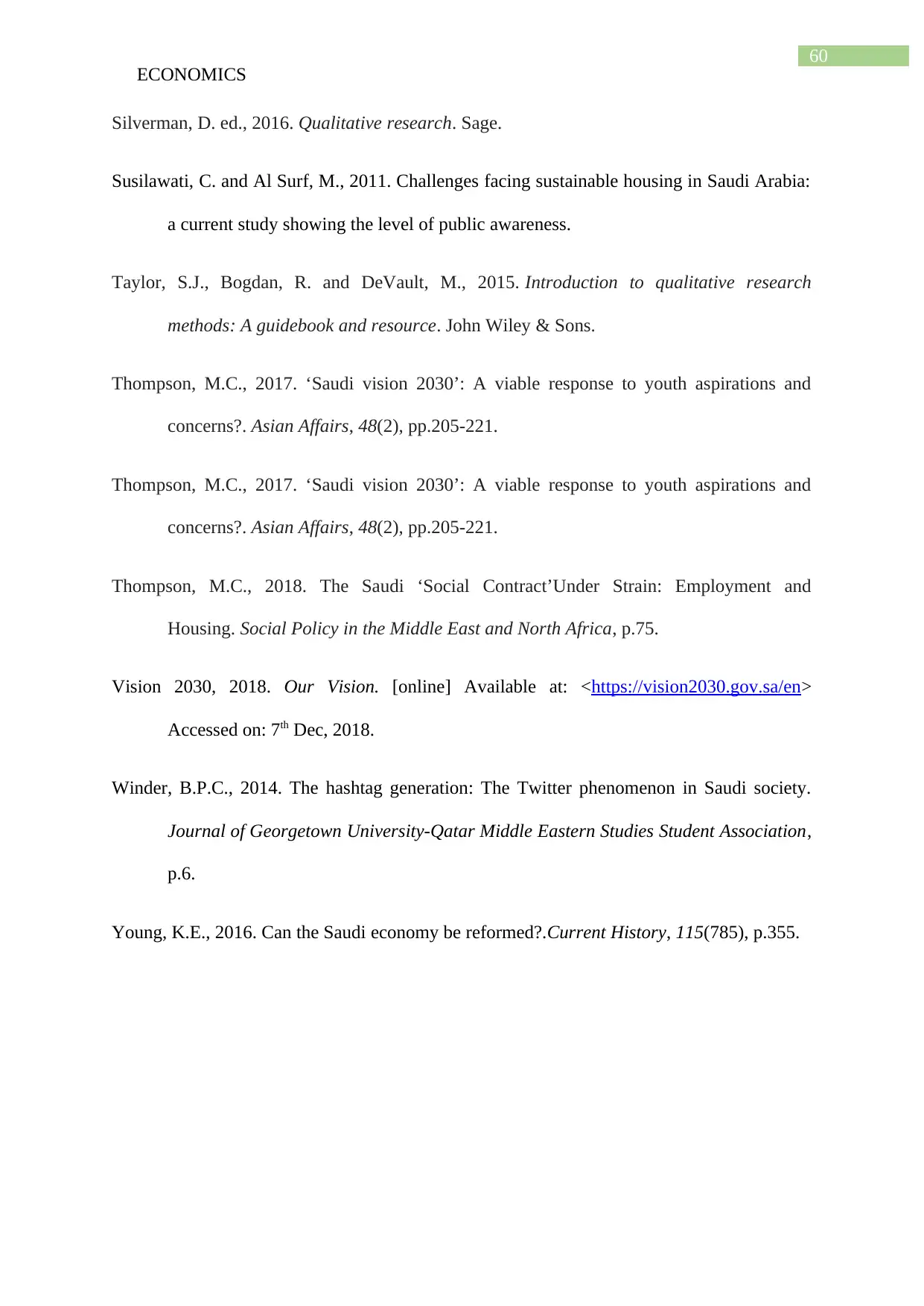
60
ECONOMICS
Silverman, D. ed., 2016. Qualitative research. Sage.
Susilawati, C. and Al Surf, M., 2011. Challenges facing sustainable housing in Saudi Arabia:
a current study showing the level of public awareness.
Taylor, S.J., Bogdan, R. and DeVault, M., 2015. Introduction to qualitative research
methods: A guidebook and resource. John Wiley & Sons.
Thompson, M.C., 2017. ‘Saudi vision 2030’: A viable response to youth aspirations and
concerns?. Asian Affairs, 48(2), pp.205-221.
Thompson, M.C., 2017. ‘Saudi vision 2030’: A viable response to youth aspirations and
concerns?. Asian Affairs, 48(2), pp.205-221.
Thompson, M.C., 2018. The Saudi ‘Social Contract’Under Strain: Employment and
Housing. Social Policy in the Middle East and North Africa, p.75.
Vision 2030, 2018. Our Vision. [online] Available at: <https://vision2030.gov.sa/en>
Accessed on: 7th Dec, 2018.
Winder, B.P.C., 2014. The hashtag generation: The Twitter phenomenon in Saudi society.
Journal of Georgetown University-Qatar Middle Eastern Studies Student Association,
p.6.
Young, K.E., 2016. Can the Saudi economy be reformed?.Current History, 115(785), p.355.
ECONOMICS
Silverman, D. ed., 2016. Qualitative research. Sage.
Susilawati, C. and Al Surf, M., 2011. Challenges facing sustainable housing in Saudi Arabia:
a current study showing the level of public awareness.
Taylor, S.J., Bogdan, R. and DeVault, M., 2015. Introduction to qualitative research
methods: A guidebook and resource. John Wiley & Sons.
Thompson, M.C., 2017. ‘Saudi vision 2030’: A viable response to youth aspirations and
concerns?. Asian Affairs, 48(2), pp.205-221.
Thompson, M.C., 2017. ‘Saudi vision 2030’: A viable response to youth aspirations and
concerns?. Asian Affairs, 48(2), pp.205-221.
Thompson, M.C., 2018. The Saudi ‘Social Contract’Under Strain: Employment and
Housing. Social Policy in the Middle East and North Africa, p.75.
Vision 2030, 2018. Our Vision. [online] Available at: <https://vision2030.gov.sa/en>
Accessed on: 7th Dec, 2018.
Winder, B.P.C., 2014. The hashtag generation: The Twitter phenomenon in Saudi society.
Journal of Georgetown University-Qatar Middle Eastern Studies Student Association,
p.6.
Young, K.E., 2016. Can the Saudi economy be reformed?.Current History, 115(785), p.355.
Paraphrase This Document
Need a fresh take? Get an instant paraphrase of this document with our AI Paraphraser

61
ECONOMICS
ECONOMICS
1 out of 62
Your All-in-One AI-Powered Toolkit for Academic Success.
+13062052269
info@desklib.com
Available 24*7 on WhatsApp / Email
![[object Object]](/_next/static/media/star-bottom.7253800d.svg)
Unlock your academic potential
© 2024 | Zucol Services PVT LTD | All rights reserved.





